Fujitsu Client Computing MC8355D Multi-Band Radio Module User Manual Q702 B6FJ 8761 01ENZ0 00
Fujitsu Limited Multi-Band Radio Module Q702 B6FJ 8761 01ENZ0 00
Contents
- 1. WWAN portion of user manual
- 2. Host User Manual
- 3. Revised WWAN portion of User Manual
Host User Manual
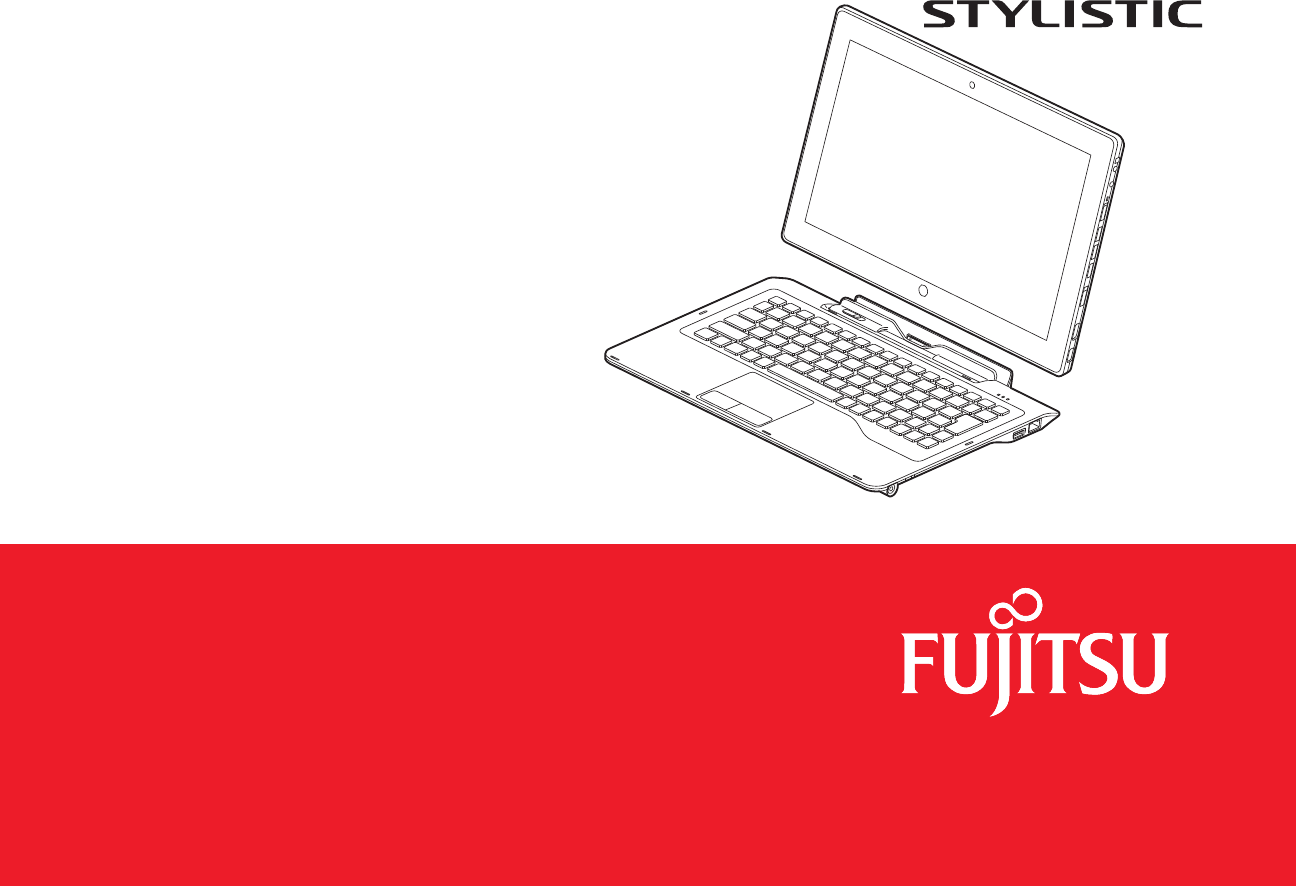
User’s
Guide
Learn how to use your
Fujitsu STYLISTIC® Q702
Hybrid Tablet

Copyright and Trademark Information
Fujitsu America, Inc.has made every effort to ensure the accuracy and completeness of this document. Because ongoing development efforts are made to
continually improve the capabilities of our products, however, the data contained herein represents Fujitsu design objectives and is provided for comparative
purposes; actual results may vary based on a variety of factors. This product data does not constitute a warranty. Specifications are subject to change without
knowledge.
Fujitsu and the Fujitsu logo are registered trademarks of Fujitsu Limited; STYLISTIC is a registered trademark of Fujitsu America, Incorporated.
Microsoft and Windows are registered trademarks or trademarks of Microsoft Corporation in the United States and/or other countries.
The SD Logo is registered with the U.S. Patent and Trademark Office and with other trademark offices around the world by SD-3C, LLC.
Intel and Intel Core are trademarks or registered trademarks of Intel Corporation or its subsidiaries in the United States and other countries.
OmniPass is a trademark of Softex, Inc.
Google is a trademark or registered trademark of Google Incorporated.
Atheros is a registered trademark of Atheros Communications, Inc.
Norton Internet Security is a trademark of Symantec Corporation in the United States and other countries.
AirPrime is a trademark of Sierra Wireless Inc.
Roxio is a trademark of Roxio, a division of Sonic Solutions.
Gobi3000 is a trademark of Qualcomm Inc.
Nuance and XT9 are either registered trademarks or trademarks of Nuance Communications, Incorporated.
Adobe and Adobe Reader are registered trademarks or trademarks of Adobe Systems Incorporated in the United States and/or other countries.
Bluetooth and the Bluetooth logo are registered trademarks of Bluetooth SIG, Inc.
Realtek is a trademark of Realtek Semiconductor Corp.
Wi-Fi is a trademark of the Wireless Ethernet Compatibility Alliance (WECA).
All other products are trademarks or registered trademarks of their respective companies. All other trademarks mentioned herein are the property of their
respective owners.

Copyright 2012 Fujitsu America, Inc. All rights reserved. No part of this publication may be copied, reproduced, or translated, without the prior written
consent of Fujitsu America, Incorporated. No part of this publication may be stored or transmitted in any electronic form without the prior consent of Fujitsu
America, Inc. B6FJ-8761-01ENZ0-00
USER GUIDE FOR WIRELESS BROADBAND CONNECTION
IF YOU HAVE THE OPTIONAL WIRELESS WAN (WWAN) DEVICE INSTALLED IN YOUR HYBRID TABLET, THE WWAN USER’S GUIDE IS LOCATED AT:
http://solutions.us.fujitsu.com/www/content/support/mobile/support_notices
PLEASE CLICK “3G MINI-CARD GOBI3000 REGULATORY AND SAFETY INFORMATION” TO OPEN THE FULL USER GUIDE CONTAINING WARNINGS AND
PRECAUTIONS ASSOCIATED WITH RF SAFETY WHEN USING THE WWAN DEVICE.
DECLARATION OF CONFORMITY
according to FCC Part 15
Responsible Party Name: Fujitsu America, Inc.
Address: 1250 E. Arques Avenue
Sunnyvale, CA 94085
Telephone: (408) 746-6000
Declares that product: Base Model Configuration: STYLISTIC Q702 Hybrid Tablet
Complies with Part 15 of the FCC Rules.
This device complies with Part 15 of the FCC rules. Operations are subject to the following two conditions:
(1) This device may not cause harmful interference, (2) This device must accept any interference received,
including interference that may cause undesired operation.
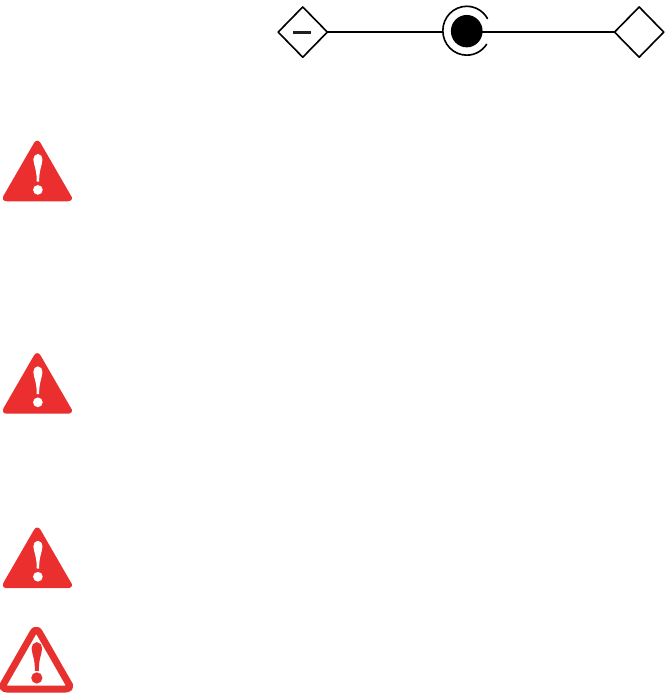
IMPORTANT SAFETY INSTRUCTIONS
This unit requires an AC adapter to operate. Use only UL Listed I.T.E. Adapters with an output rating of 19 VDC, with a current of 3.16A (60 W).
When using your Hybrid Tablet, basic safety precautions should always be followed to reduce the risk of fire, electric shock and injury to persons, including
the following:
•Do not use this product near water for example, near a bathtub, washbowl, kitchen sink or laundry tub, in a wet basement or near a
swimming pool.
•Use only the power cord and batteries indicated in this manual. Do not dispose of batteries in a fire. They may explode. Check with local
codes for possible special disposal instructions.
SAVE THESE INSTRUCTIONS
For Authorized Repair Technicians Only
CAUTION: HOT SURFACE: THE BOTTOM OF THIS COMPUTER CAN BECOME HOT WHEN USED FOR LONG PERIODS OF TIME. WHEN USING THIS
DEVICE, TAKE CAUTION TO LIMIT LONG TERM OR CONTINUOUS USE WHILE RESTING IT ON EXPOSED SKIN, SUCH AS THE LAP.
CAUTION: RISK OF EXPLOSION IF BATTERY IS REPLACED BY AN INCORRECT TYPE. DISPOSE OF USED BATTERIES ACCORDING TO THE INSTRUCTIONS.
DANGER OF EXPLOSION IF LITHIUM (CLOCK) BATTERY IS INCORRECTLY REPLACED. REPLACE ONLY WITH THE SAME OR EQUIVALENT TYPE
RECOMMENDED BY THE MANUFACTURER. DISPOSE OF USED BATTERIES ACCORDING TO THE MANUFACTURER’S INSTRUCTION.
FOR CONTINUED PROTECTION AGAINST RISK OF FIRE, REPLACE ONLY WITH THE SAME TYPE AND RATING FUSE.
+
AC adapter output polarity:

5
Contents
Chapter 1 Getting to Know Your Hybrid Tablet
Overview. . . . . . . . . . . . . . . . . . . . . . . . . . . . . . . . . . . . . . . . . . . . . . . . . . . . .13
Locating the Connectors and Controls. . . . . . . . . . . . . . . . . . . . . . . . . . . . .14
Front Features. . . . . . . . . . . . . . . . . . . . . . . . . . . . . . . . . . . . . . . . . . . . . . 14
Back Features . . . . . . . . . . . . . . . . . . . . . . . . . . . . . . . . . . . . . . . . . . . . . . 16
Left features . . . . . . . . . . . . . . . . . . . . . . . . . . . . . . . . . . . . . . . . . . . . . . . 17
Right Features. . . . . . . . . . . . . . . . . . . . . . . . . . . . . . . . . . . . . . . . . . . . . . 18
Status Indicator Panel. . . . . . . . . . . . . . . . . . . . . . . . . . . . . . . . . . . . . . . . . .20
Display Panel . . . . . . . . . . . . . . . . . . . . . . . . . . . . . . . . . . . . . . . . . . . . . . . . .22
Adjusting Display Panel Brightness . . . . . . . . . . . . . . . . . . . . . . . . . . . . . 22
Active Digitizer/Touchscreen . . . . . . . . . . . . . . . . . . . . . . . . . . . . . . . . . . . .24
Active Digitizer Display. . . . . . . . . . . . . . . . . . . . . . . . . . . . . . . . . . . . . . . 24
Using the Capacitive Touchscreen . . . . . . . . . . . . . . . . . . . . . . . . . . . . . . 28
Accessing the OnScreen TouchPad. . . . . . . . . . . . . . . . . . . . . . . . . . . . . . 29
Using the Nuance SoftKeyboard . . . . . . . . . . . . . . . . . . . . . . . . . . . . . . . 30
Caring for the Pen. . . . . . . . . . . . . . . . . . . . . . . . . . . . . . . . . . . . . . . . . . . 30
Hybrid Tablet Buttons. . . . . . . . . . . . . . . . . . . . . . . . . . . . . . . . . . . . . . . . . .33

6
-
Chapter 2 Getting Started with Your Hybrid Tablet
Power Sources . . . . . . . . . . . . . . . . . . . . . . . . . . . . . . . . . . . . . . . . . . . . . . . 35
Connecting the Power Adapters . . . . . . . . . . . . . . . . . . . . . . . . . . . . . . . . 35
Starting Your STYLISTIC Hybrid Tablet. . . . . . . . . . . . . . . . . . . . . . . . . . . . 37
Power On . . . . . . . . . . . . . . . . . . . . . . . . . . . . . . . . . . . . . . . . . . . . . . . . . . 37
Boot Sequence . . . . . . . . . . . . . . . . . . . . . . . . . . . . . . . . . . . . . . . . . . . . . 38
Hard Disk Drive Passwords . . . . . . . . . . . . . . . . . . . . . . . . . . . . . . . . . . . . 38
BIOS Setup Utility . . . . . . . . . . . . . . . . . . . . . . . . . . . . . . . . . . . . . . . . . . . 38
Booting the System. . . . . . . . . . . . . . . . . . . . . . . . . . . . . . . . . . . . . . . . . . 39
Starting Windows the First Time. . . . . . . . . . . . . . . . . . . . . . . . . . . . . . . . 39
. . . . . . . . . . . . . . . . . . . . . . . . . . . . . . . . . . . . . . . . . . . . . . . . . . . . . . . . . . 40
Power Management . . . . . . . . . . . . . . . . . . . . . . . . . . . . . . . . . . . . . . . . . . 41
Power/Suspend/Resume Switch . . . . . . . . . . . . . . . . . . . . . . . . . . . . . . . . 41
Sleep Mode . . . . . . . . . . . . . . . . . . . . . . . . . . . . . . . . . . . . . . . . . . . . . . . . 41
Hibernation Feature . . . . . . . . . . . . . . . . . . . . . . . . . . . . . . . . . . . . . . . . . 42
Windows Power Management . . . . . . . . . . . . . . . . . . . . . . . . . . . . . . . . . 42
Restarting the System. . . . . . . . . . . . . . . . . . . . . . . . . . . . . . . . . . . . . . . . 43
Powering Off . . . . . . . . . . . . . . . . . . . . . . . . . . . . . . . . . . . . . . . . . . . . . . . 43
Chapter 3 User-Installable Features
Secure Digital Cards. . . . . . . . . . . . . . . . . . . . . . . . . . . . . . . . . . . . . . . . . . . 44
Installing SD Cards . . . . . . . . . . . . . . . . . . . . . . . . . . . . . . . . . . . . . . . . . . 45
Removing an SD Card . . . . . . . . . . . . . . . . . . . . . . . . . . . . . . . . . . . . . . . . 45
Keyboard Docking Station. . . . . . . . . . . . . . . . . . . . . . . . . . . . . . . . . . . . . . 46
Docking Station Components . . . . . . . . . . . . . . . . . . . . . . . . . . . . . . . . . . 47
Attaching the Docking Station . . . . . . . . . . . . . . . . . . . . . . . . . . . . . . . . . 48
Detaching Docking Station. . . . . . . . . . . . . . . . . . . . . . . . . . . . . . . . . . . . 49
Changing the Battery . . . . . . . . . . . . . . . . . . . . . . . . . . . . . . . . . . . . . . . . 49
Docking Station Status Indicators . . . . . . . . . . . . . . . . . . . . . . . . . . . . . . 50
Docking Indicator . . . . . . . . . . . . . . . . . . . . . . . . . . . . . . . . . . . . . . . . . . . 50

7
-
Battery Charge Indicator. . . . . . . . . . . . . . . . . . . . . . . . . . . . . . . . . . . . . . 50
Battery Level Indicator . . . . . . . . . . . . . . . . . . . . . . . . . . . . . . . . . . . . . . . 51
NumLk Indicator . . . . . . . . . . . . . . . . . . . . . . . . . . . . . . . . . . . . . . . . . . . . 51
CapsLock Indicator . . . . . . . . . . . . . . . . . . . . . . . . . . . . . . . . . . . . . . . . . . 51
ScrLk Indicator. . . . . . . . . . . . . . . . . . . . . . . . . . . . . . . . . . . . . . . . . . . . . . 51
Chapter 4 Troubleshooting Your Hybrid Tablet
Troubleshooting. . . . . . . . . . . . . . . . . . . . . . . . . . . . . . . . . . . . . . . . . . . . . . 52
Identifying the Problem . . . . . . . . . . . . . . . . . . . . . . . . . . . . . . . . . . . . . . 52
Specific Problems . . . . . . . . . . . . . . . . . . . . . . . . . . . . . . . . . . . . . . . . . . . 54
Power On Self Test Messages . . . . . . . . . . . . . . . . . . . . . . . . . . . . . . . . . . 60
Restoring Your System Image and Software. . . . . . . . . . . . . . . . . . . . . . . 61
Saving and Recovering Your Factory and System Images . . . . . . . . . . . . 61
Backing Up a System Image . . . . . . . . . . . . . . . . . . . . . . . . . . . . . . . . . . . 63
Recovery and Utility tabs . . . . . . . . . . . . . . . . . . . . . . . . . . . . . . . . . . . . . 67
Recovering your Factory Image . . . . . . . . . . . . . . . . . . . . . . . . . . . . . . . . 68
Downloading Driver Updates . . . . . . . . . . . . . . . . . . . . . . . . . . . . . . . . . . 69
Chapter 5 Care and Maintenance
Caring for your Hybrid Tablet . . . . . . . . . . . . . . . . . . . . . . . . . . . . . . . . . . . 70
Cleaning your Hybrid Tablet . . . . . . . . . . . . . . . . . . . . . . . . . . . . . . . . . . . 71
Storing your Hybrid Tablet . . . . . . . . . . . . . . . . . . . . . . . . . . . . . . . . . . . . 72
Traveling with your Hybrid Tablet . . . . . . . . . . . . . . . . . . . . . . . . . . . . . . 72
Batteries . . . . . . . . . . . . . . . . . . . . . . . . . . . . . . . . . . . . . . . . . . . . . . . . . . 73
Media Care . . . . . . . . . . . . . . . . . . . . . . . . . . . . . . . . . . . . . . . . . . . . . . . . 74
Secure Digital Cards . . . . . . . . . . . . . . . . . . . . . . . . . . . . . . . . . . . . . . . . . 75

8
-
Chapter 6 System Specifications
Specifications . . . . . . . . . . . . . . . . . . . . . . . . . . . . . . . . . . . . . . . . . . . . . . . . 76
Microprocessor . . . . . . . . . . . . . . . . . . . . . . . . . . . . . . . . . . . . . . . . . . . . . 76
Chipset. . . . . . . . . . . . . . . . . . . . . . . . . . . . . . . . . . . . . . . . . . . . . . . . . . . . 76
Memory . . . . . . . . . . . . . . . . . . . . . . . . . . . . . . . . . . . . . . . . . . . . . . . . . . . 76
Video . . . . . . . . . . . . . . . . . . . . . . . . . . . . . . . . . . . . . . . . . . . . . . . . . . . . . 77
Audio . . . . . . . . . . . . . . . . . . . . . . . . . . . . . . . . . . . . . . . . . . . . . . . . . . . . . 77
Mass Storage Device Options . . . . . . . . . . . . . . . . . . . . . . . . . . . . . . . . . . 78
Communications . . . . . . . . . . . . . . . . . . . . . . . . . . . . . . . . . . . . . . . . . . . . 78
Security Features. . . . . . . . . . . . . . . . . . . . . . . . . . . . . . . . . . . . . . . . . . . . 78
Device Ports. . . . . . . . . . . . . . . . . . . . . . . . . . . . . . . . . . . . . . . . . . . . . . . . 78
Power. . . . . . . . . . . . . . . . . . . . . . . . . . . . . . . . . . . . . . . . . . . . . . . . . . . . . 79
Dimensions and Weight . . . . . . . . . . . . . . . . . . . . . . . . . . . . . . . . . . . . . . 79
Environmental Requirements. . . . . . . . . . . . . . . . . . . . . . . . . . . . . . . . . . 80
Popular Accessories. . . . . . . . . . . . . . . . . . . . . . . . . . . . . . . . . . . . . . . . . . 80
Included Software . . . . . . . . . . . . . . . . . . . . . . . . . . . . . . . . . . . . . . . . . . . 80
Learning About Your Software . . . . . . . . . . . . . . . . . . . . . . . . . . . . . . . . . 81
Regulatory Information . . . . . . . . . . . . . . . . . . . . . . . . . . . . . . . . . . . . . . . 84
Appendix A: WLAN User’s Guide
Before Using the Optional Wireless LAN . . . . . . . . . . . . . . . . . . . . . . . . . 88
Wireless LAN Device Covered by this Document . . . . . . . . . . . . . . . . . . . 88
Characteristics of the WLAN Device . . . . . . . . . . . . . . . . . . . . . . . . . . . . . 88
Wireless LAN Modes Using this Device. . . . . . . . . . . . . . . . . . . . . . . . . . . 89
Deactivating/Disconnecting the WLAN Device. . . . . . . . . . . . . . . . . . . . . 91
Deactivation Using the Wireless On/Off Switch . . . . . . . . . . . . . . . . . . . . 92
Disconnection Using the Icon in the Taskbar. . . . . . . . . . . . . . . . . . . . . . 92
Activating the WLAN Device . . . . . . . . . . . . . . . . . . . . . . . . . . . . . . . . . . . 92

9
-
Configuring the Wireless LAN. . . . . . . . . . . . . . . . . . . . . . . . . . . . . . . . . . . 93
Configuring the WLAN . . . . . . . . . . . . . . . . . . . . . . . . . . . . . . . . . . . . . . . 93
Connection to the network . . . . . . . . . . . . . . . . . . . . . . . . . . . . . . . . . . . . 93
Troubleshooting the WLAN. . . . . . . . . . . . . . . . . . . . . . . . . . . . . . . . . . . . . 94
Troubleshooting . . . . . . . . . . . . . . . . . . . . . . . . . . . . . . . . . . . . . . . . . . . . 94
WLAN Specifications . . . . . . . . . . . . . . . . . . . . . . . . . . . . . . . . . . . . . . . . . . 96
Specifications . . . . . . . . . . . . . . . . . . . . . . . . . . . . . . . . . . . . . . . . . . . . . . 96
Using the Bluetooth Device . . . . . . . . . . . . . . . . . . . . . . . . . . . . . . . . . . . . 97
What is Bluetooth . . . . . . . . . . . . . . . . . . . . . . . . . . . . . . . . . . . . . . . . . . . 97
Where to Find Information About Bluetooth . . . . . . . . . . . . . . . . . . . . . . 97
Appendix B: Fingerprint Sensor Device
Introducing the Fingerprint Sensor Device . . . . . . . . . . . . . . . . . . . . . . . . 99
Getting Started . . . . . . . . . . . . . . . . . . . . . . . . . . . . . . . . . . . . . . . . . . . . . 100
Installing OmniPass . . . . . . . . . . . . . . . . . . . . . . . . . . . . . . . . . . . . . . . . . 100
User Enrollment . . . . . . . . . . . . . . . . . . . . . . . . . . . . . . . . . . . . . . . . . . . . 102
Using OmniPass . . . . . . . . . . . . . . . . . . . . . . . . . . . . . . . . . . . . . . . . . . . . 105
Configuring OmniPass . . . . . . . . . . . . . . . . . . . . . . . . . . . . . . . . . . . . . . . 110
OmniPass Control Center . . . . . . . . . . . . . . . . . . . . . . . . . . . . . . . . . . . . . 111
Troubleshooting . . . . . . . . . . . . . . . . . . . . . . . . . . . . . . . . . . . . . . . . . . . . 112
Index . . . . . . . . . . . . . . . . . . . . . . . . . . . . . . . . . . . . . . . . . . . . . . . . . . . . . . . 114

10
Preface
About This Guide
The STYLISTIC® Q702 Hybrid Tablet is a high-performance pen-based computer that has been designed to support
Microsoft® Windows® 7 Professional edition.
This manual explains how to operate your Hybrid Tablet hardware and built-in system software.
The STYLISTIC Q702 Hybrid Tablet is a completely self-contained unit with a 11.6” HD IPS display with 160 degree
vertical and horizontal viewing angles. It has a powerful interface that enables it to support a variety of optional
features.
Conventions Used in the Guide
Pages with additional information about a specific topic are cross-referenced within the text.
On screen buttons or menu items appear in bold. Example: Click OK to restart your Hybrid Tablet.
THE INFORMATION ICON HIGHLIGHTS INFORMATION THAT WILL ENHANCE YOUR UNDERSTANDING OF THE SUBJECT MATERIAL.
THE CAUTION ICON HIGHLIGHTS INFORMATION THAT IS IMPORTANT TO THE SAFE OPERATION OF YOUR COMPUTER, OR TO THE INTEGRITY OF YOUR
FILES. PLEASE READ ALL CAUTION INFORMATION CAREFULLY.

11
- About This Guide
Fujitsu Contact Information
Service and Support
You can contact Fujitsu Service and Support in the following ways:
•Toll free: 1-800-8FUJITSU (1-800-838-5487)
•Website:
U.S.A. - us.fujitsu.com/solutions
Canada - www.fujitsu.ca
Before you place the call, you should have the following information ready so that the customer support
representative can provide you with the fastest possible solution:
•Product name
•Product configuration number
•Product serial number
•Purchase date
•Conditions under which the problem occurred
•Any error messages that have occurred
•Type of device connected, if any
Fujitsu Shopping Online
You can go directly to the online by going to the website at: www.shopfujitsu.com.
THE WARNING ICON HIGHLIGHTS INFORMATION THAT CAN BE HAZARDOUS TO EITHER YOU, YOUR HYBRID TABLET, OR YOUR FILES. PLEASE READ ALL
WARNING INFORMATION CAREFULLY.

12
- About This Guide
Maintaining Latest Configuration
To ensure that you always have the most current driver updates related to your system, you should occasionally access
the Fujitsu Software Download Manager (FSDM) utility. The FSDM utility is available to allow you to download the
latest drivers, utilities, and applications from the Fujitsu Support site. If you have a Windows 7 operating system, you
will need to go to the Support Site (http://support.fujitsupc.com/CS/Portal/support.do?srch=DOWNLOADS).
Limited Warranty
Your Hybrid Tablet is backed by a Fujitsu International Limited Warranty. Check the service kit that came with your
tablet for the Limited Warranty period and terms and conditions.
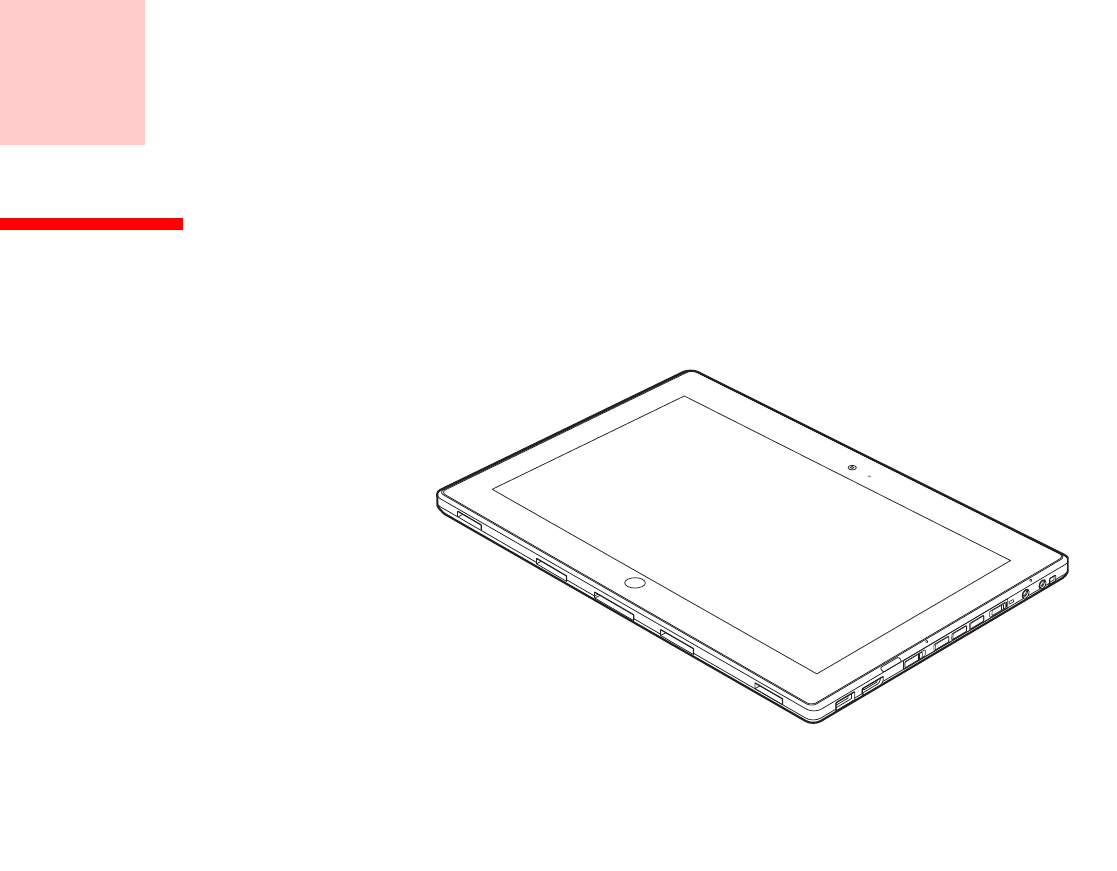
13
Chapter 1
Getting to Know Your Hybrid Tablet
Overview
The STYLISTIC® Q702 Hybrid Tablet
is a high-performance pen-based
computer that has been designed
to support Microsoft® Windows® 7
Professional edition.
The Q702 Hybrid Tablet is called a
“hybrid” because when used with
the optional keyboard docking
station, it has the looks and
functionality of a traditional
laptop.
This chapter provides an overview
of the STYLISTIC Q702 Hybrid
Tablet and its many features. Figure 1. STYLISTIC Q702 Hybrid Tablet
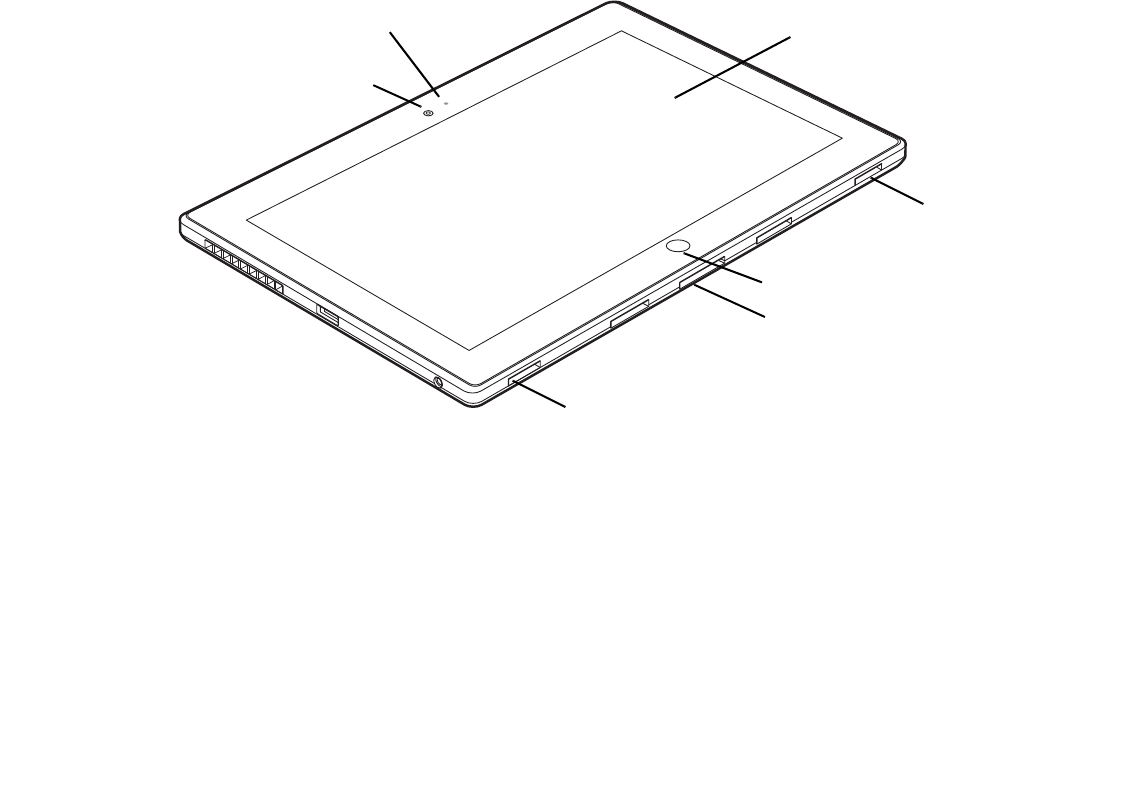
14
- Locating the Connectors and Controls
Locating the Connectors and Controls
Features and controls that you use to operate your Hybrid Tablet are outlined below and illustrated in Figures 2 and
3. Details on using these features and controls are provided later in this manual.
Figure 2. STYLISTIC Q702 Hybrid Tablet Features (Bottom, Right View)
Front Features
Front Web Camera
The front-facing HD (1280x720 pixel) web camera allows you to take pictures of yourself to send over the internet.
For information on using the microphone and web cam, see the documentation associated with the YouCam
application.
Web Cam Access LED
The web cam access LED indicates when the web camera is in use.
Front Web Camera
Display
Speaker
Web Cam Access LED
Windows Button
Speaker
Docking Cradle Connector

15
- Locating the Connectors and Controls
Display
The 11.6” HD IPS display offers 160 degree vertical and horizontal viewing angles.
Speakers
The speakers allow you to hear stereo sound from the system.
Windows Button
Pressing the Windows button gives you quick access to the Start menu.
Docking Cradle Connector
Allows you to connect the optional STYLISTIC Keyboard Docking Station.
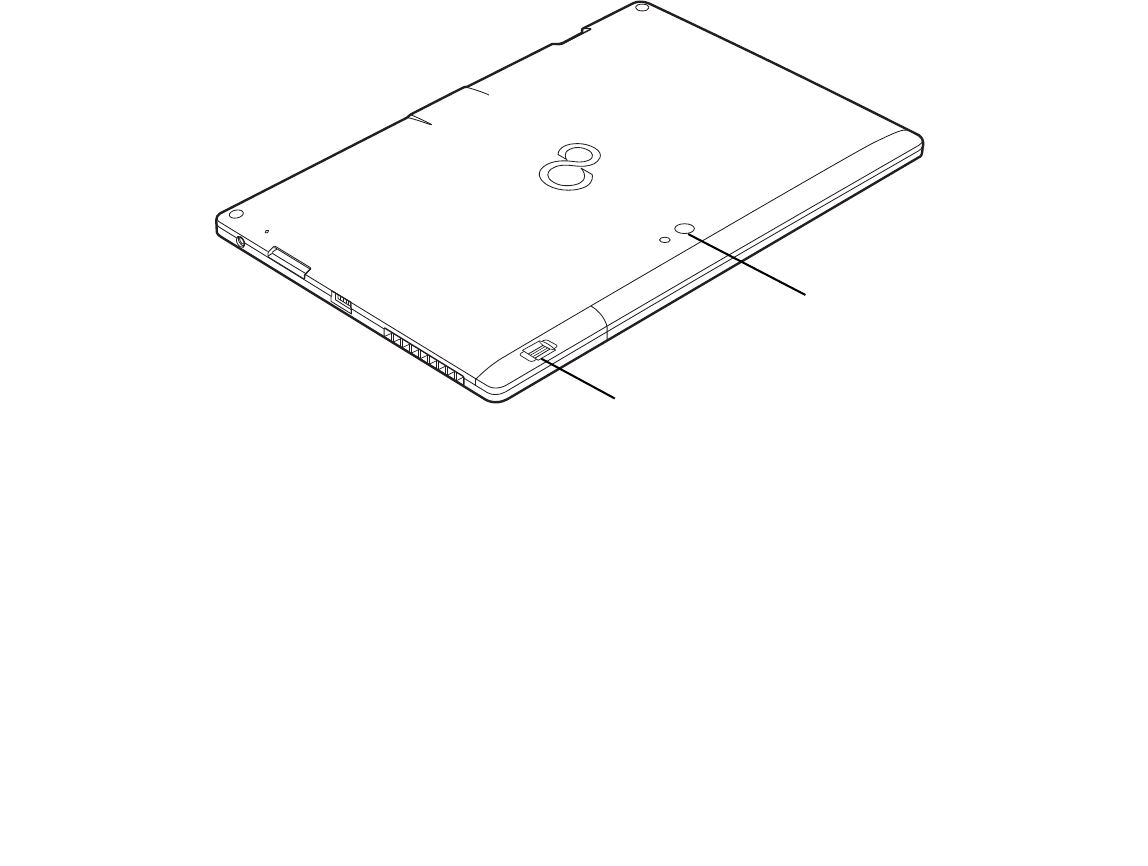
16
- Locating the Connectors and Controls
Figure 3. STYLISTIC Q702 Hybrid Tablet Features (Back View)
Back Features
Rear Web Camera
The FHD (1920x1080 pixel) rear web camera allows you to take pictures of objects in front of you for sharing over the
internet. For information on using the camera, see the documentation associated with the YouCam application.
Fingerprint Sensor
The fingerprint sensor allows you to start your system by swiping your finger over the sensor. See “Introducing the
Fingerprint Sensor Device” on page 99.
Rear Web Camera
Fingerprint Sensor
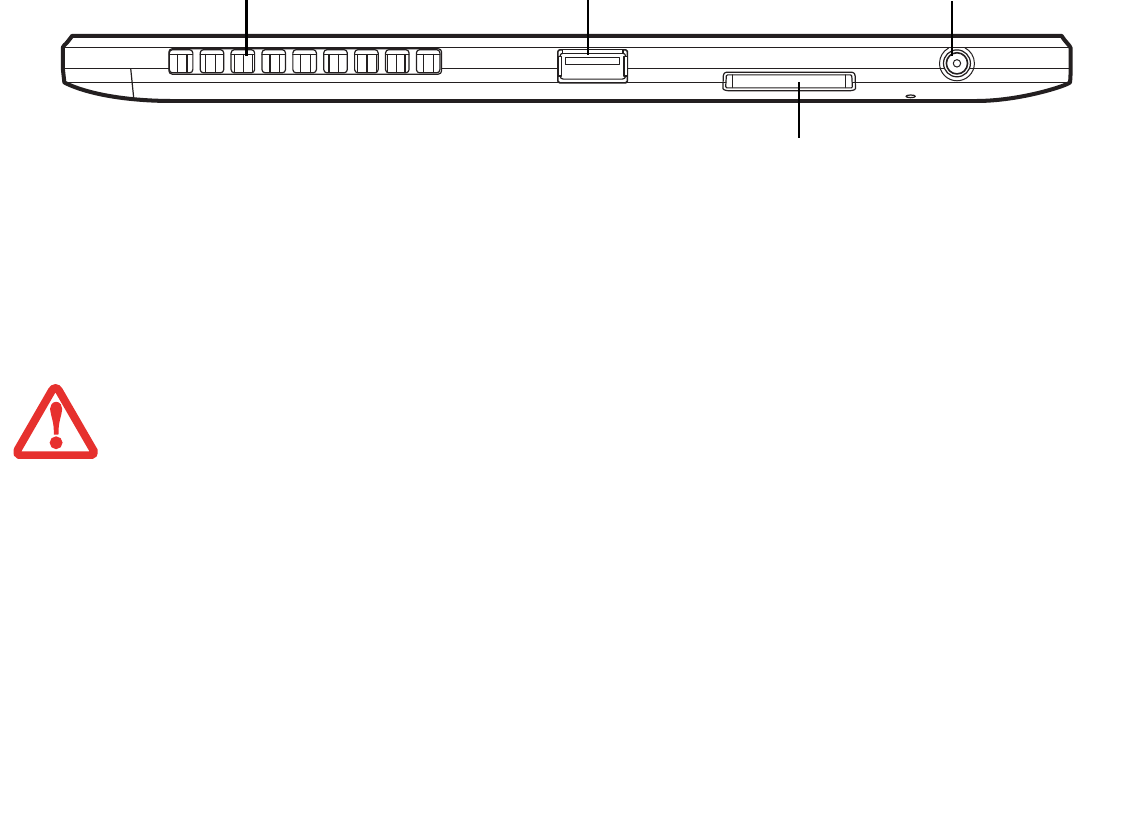
17
- Locating the Connectors and Controls
Figure 4. STYLISTIC Q702 Hybrid Tablet Features (Left View)
Left features
Air Vents
The air vents are used to cool the system to prevent overheating.
USB 3.0 Connector
Allows you to connect Universal Serial Bus-compliant devices (compliant with USB Standard Revision 3.0) to the
Hybrid Tablet.
DC In Jack
Allows you to connect the AC adapter or auto adapter.
SD Card Slot
The Secure Digital (SD) card slot allows you to insert a flash memory card for data storage. Flash memory cards allow
you to transfer data to and from a variety of different digital devices. See “Secure Digital Cards” on page 44.
TO PROTECT YOUR TABLET FROM DAMAGE AND TO OPTIMIZE PERFORMANCE, BE SURE TO KEEP ALL AIR VENTS UNOBSTRUCTED, CLEAN, AND CLEAR
OF DEBRIS. THIS MAY REQUIRE PERIODIC CLEANING, DEPENDING UPON THE ENVIRONMENT IN WHICH THE SYSTEM IS USED.
DO NOT OPERATE THE TABLET IN AREAS WHERE THE AIR VENTS CAN BE OBSTRUCTED, SUCH AS IN TIGHT ENCLOSURES OR ON SOFT SURFACES LIKE A
BED OR CUSHION.
Air Vents USB 3.0 Connector
SD Card Slot
DC In Jack
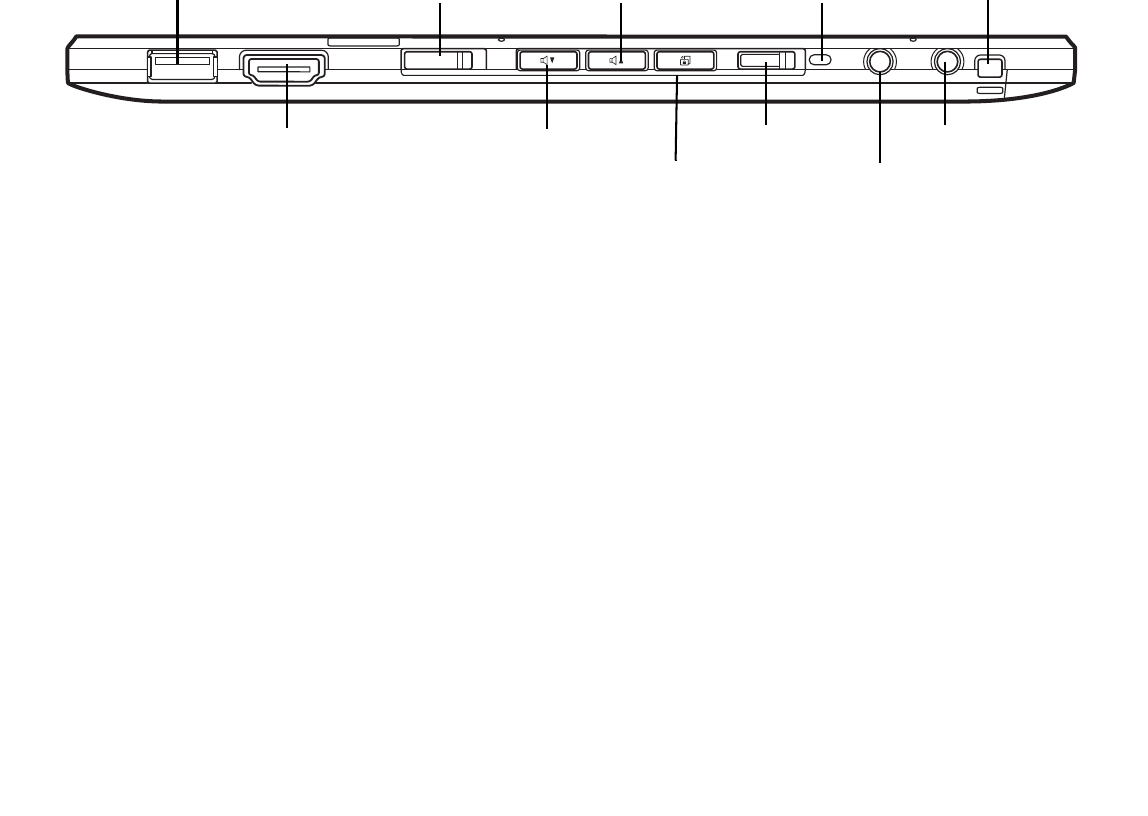
18
- Locating the Connectors and Controls
Figure 5. STYLISTIC Q702 Hybrid Tablet Features (Right View)
Right Features
USB 2.0 Connector
Allows you to connect Universal Serial Bus-compliant devices (compliant with USB Standard Revision 2.0) to the
Hybrid Tablet. Two additional USB 2.0 ports are located on the optional Keyboard Docking Station.
Power/Suspend/Resume Switch
Allows you to turn on, off, sleep, resume, hibernate or wake the Hybrid Tablet in order to optimize battery life. See
“Starting Your STYLISTIC Hybrid Tablet” on page 37.
Volume Up / Volume Down Buttons
The Volume Up and Volume Down buttons allow you to control the volume of the tablet.
Anti-theft Lock Slot
The anti-theft lock slot allows you to attach an optional physical lock down device.
Pen Tether Attachment Point
The pen tether attachment point is used to connect your pen -- or stylus -- to the system to prevent its loss.
USB 2.0 Connector
HDMI Connector
Power/Suspend/Resume Switch
Volume Down Button
Volume Up Button
Rotate Display Button
Wireless Device Switch
Anti-Theft Lock Slot
Headphone/Line Out Jack
Microphone/ Line In Jack
Pen Tether
Attachment Point

19
- Locating the Connectors and Controls
Headphone/Line Out Jack
The headphone jack allows you to connect headphones. See “Headphone Jack” on page 81.
Microphone/Line In Jack
The microphone jack allows you to connect an external stereo microphone. See “Microphone Jack” on page 81.
Wireless Device On/Off switch
The wireless device on/off switch is used to turn the optional WLAN, WWAN, and Bluetooth devices on and off.
Switching the device off when not in use will help to extend battery life.
Rotate Display Button
The Rotate Display button allow you to change the orientation of the display from horizontal to vertical.
HDMI Connector
The HDMI port is used to connect compatible digital devices with your computer (such as a high-definition television
or AV receiver).
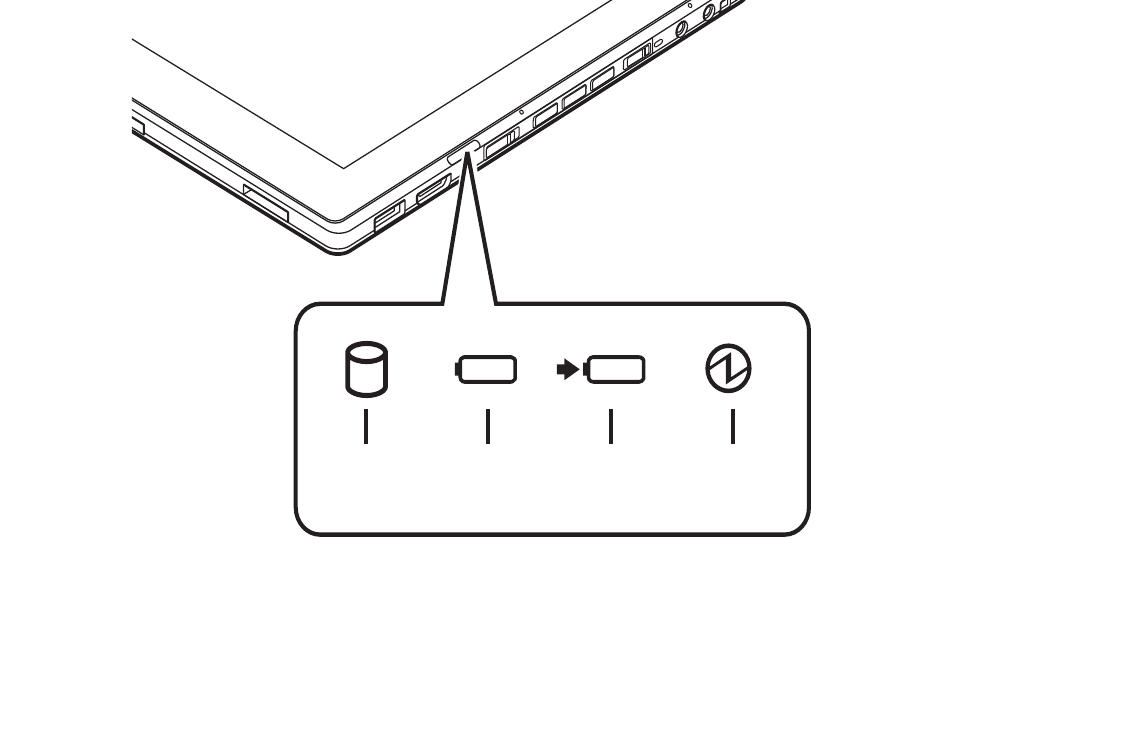
20
- Status Indicator Panel
Status Indicator Panel
Icons appear under each of the system status LEDs in the status display indicating the status of the solid state drive, system power, battery
charge and battery level status. The location of icons in the Status display is shown in Figure 6.
Table 1 explains how the LEDs associated with the individual icons are displayed, and describes what the variations of the displays indicate.
(If an icon is not displayed, it indicates that the related system function is off or inactive.
Figure 6. Status Display Icons
PowerBattery
Battery
SSD Access
harge
Level

21
- Status Indicator Panel
Table 1 . Status Display Conditions
In the following table, a “blinking” LED flashes at the rate of once per second; an LED that is “blinking, slow” flashes at the rate of one second on, five
seconds off.
Icon LED State Remarks
Hard Drive Access
Green, solid The indicator lights up green: The hard disk drive is being accessed.
Battery Level
Green, solid The battery is fully charged.
Orange, solid The battery is partially charged.
Red, solid The battery is nearly discharged.
Off The Tablet is switched off or in Save-to-Disk mode.
Charging Indicator
Green, solid The AC Adapter is connected.
Orange, solid The battery is being charged.
Red, blinking Battery charging error
Off AC Adapter is disconnected.
Power
Blue, solid, The system is turned on.
Blue, blinking The notebook is in sleep mode (Save-to-RAM).
Off The notebook is switched off or in Save-to-Disk mode.
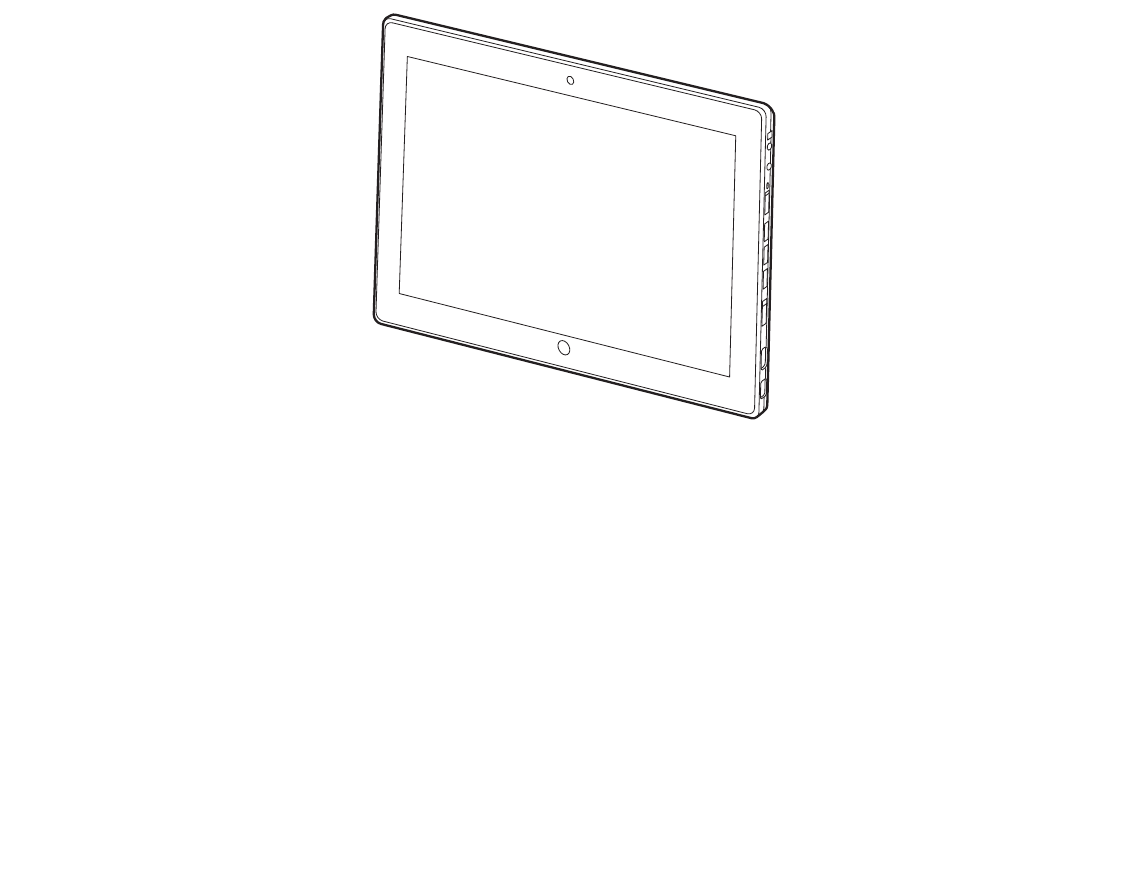
22
- Display Panel
Figure 7. Hybrid Tablet Display Panel
Display Panel
Your STYLISTIC Q702 Hybrid Tablet contains an LCD display panel that is backlit for easier viewing in bright
environments. The slate design of your Hybrid Tablet allows you to easily hold the unit and rotate it 90o, 180o, or 270o
in either direction. This display is used as a tablet, much as you would a pad of paper. The tablet can also be used in
conjunction with the optional keypad dock to create a traditional notebook form.
Adjusting Display Panel Brightness
To adjust brightness with the power management utility:
Click Start -> Control Panel. In View by:, select one of the icon views. Select Display, then click Adjust brightness in
the left pane. Under Select a power plan, select the plan settings you want to use. Drag Screen brightness: bar (at
the bottom of the window) to the left or right, depending on your preference.

23
- Display Panel
Holding the Hybrid Tablet
The STYLISTIC Q702 can be held in any of three orientations, depending upon how you would like to use it. There is
primary landscape orientation (secondary landscape orientation is non-functional) and primary and secondary
portrait orientations. (The orientation nomenclatures reflect those used in the button utility). When you rotate the
system using the Rotation button, the order in which it rotates is illustrated below.
Primary Landscape Orientation Secondary Portrait
Orientation Secondary Landscape Orientation
(Non-functional) Primary Portrait
Orientation
Sec 3_Display.fm Page 23 Tuesday, August 14, 2012 4:47 PM
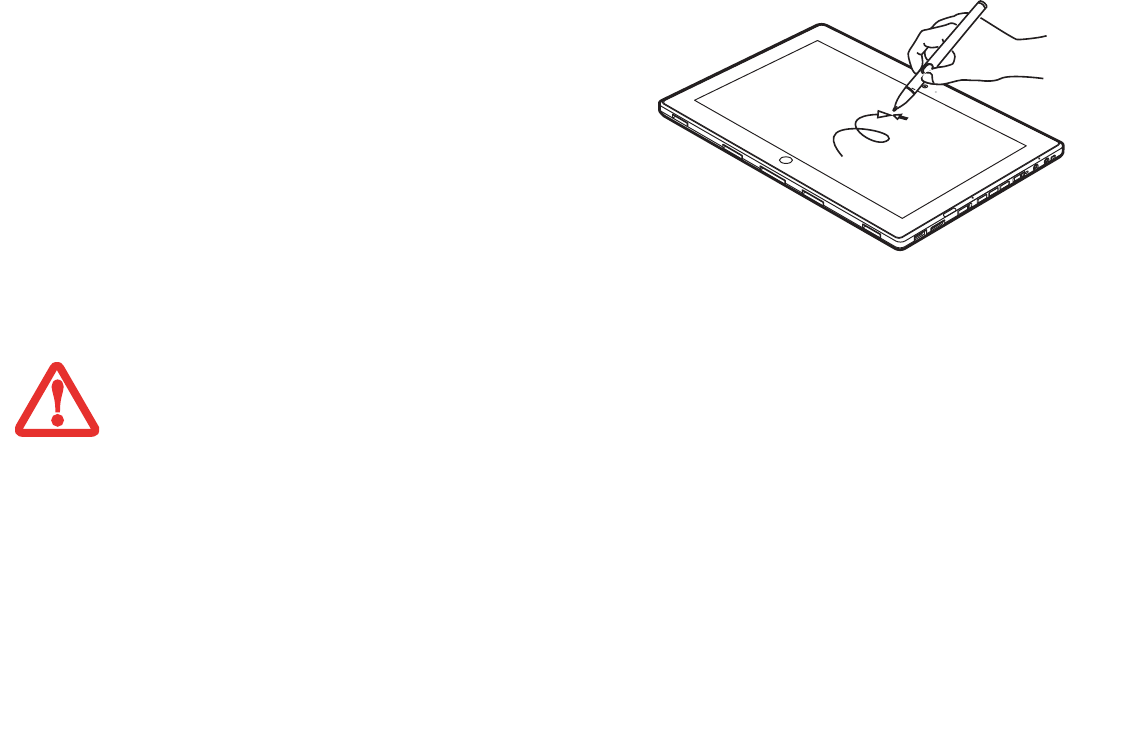
24
- Active Digitizer/Touchscreen
Active Digitizer/Touchscreen
Active Digitizer Display
The integrated active digitizer allows you to use the
included stylus (also called a “pen”) as a pointing
device. (For detailed information about caring
for your stylus, go to “Caring for the Pen” on
page 30.)
You can use the stylus to click, double-click, drag
items and icons, write text, or to draw like a pen or
pencil in applications that support this behavior,
such as drawing or painting programs. See the
documentation that came with your application for
details.
Figure 8. Using the Active Digitizer Display
•DO NOT USE EXCESSIVE FORCE WHEN TAPPING OR WRITING ON THE SCREEN WITH THE STYLUS. EXCESSIVE FORCE COULD RESULT IN DAMAGE TO
THE LED AND/OR ACTIVE DIGITIZER.
•TO PURCHASE ADDITIONAL OR REPLACEMENT STYLUSES, VISIT THE FUJITSU ACCESSORIES WEBSITE AT: WWW.SHOPFUJITSU.COM.
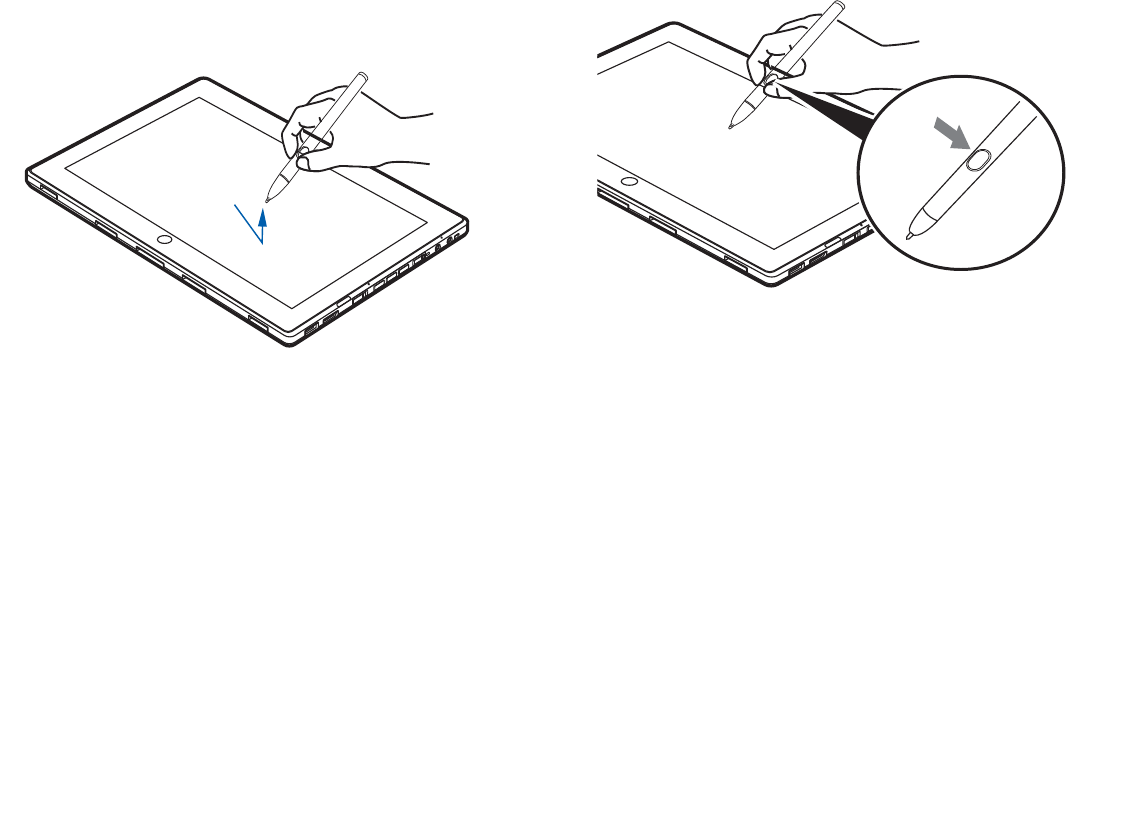
25
- Active Digitizer/Touchscreen
Clicking on Active Digitizer Display
To left-click, touch the object you wish to select and then lift
the stylus tip immediately.
Figure 9. Clicking on the Active Digitizer Display
Figure 10. Right-clicking Active Digitizer
Right-Clicking on Active Digitizer
Right-click can be accomplished by holding the front
of the toggle button down while tapping on the
screen. To change the settings for the right-click
feature, go to Start -> Control Panel -> Pen and Touch.
In the Pen Options tab, select “Press and Hold” then
click the [Settings] button.
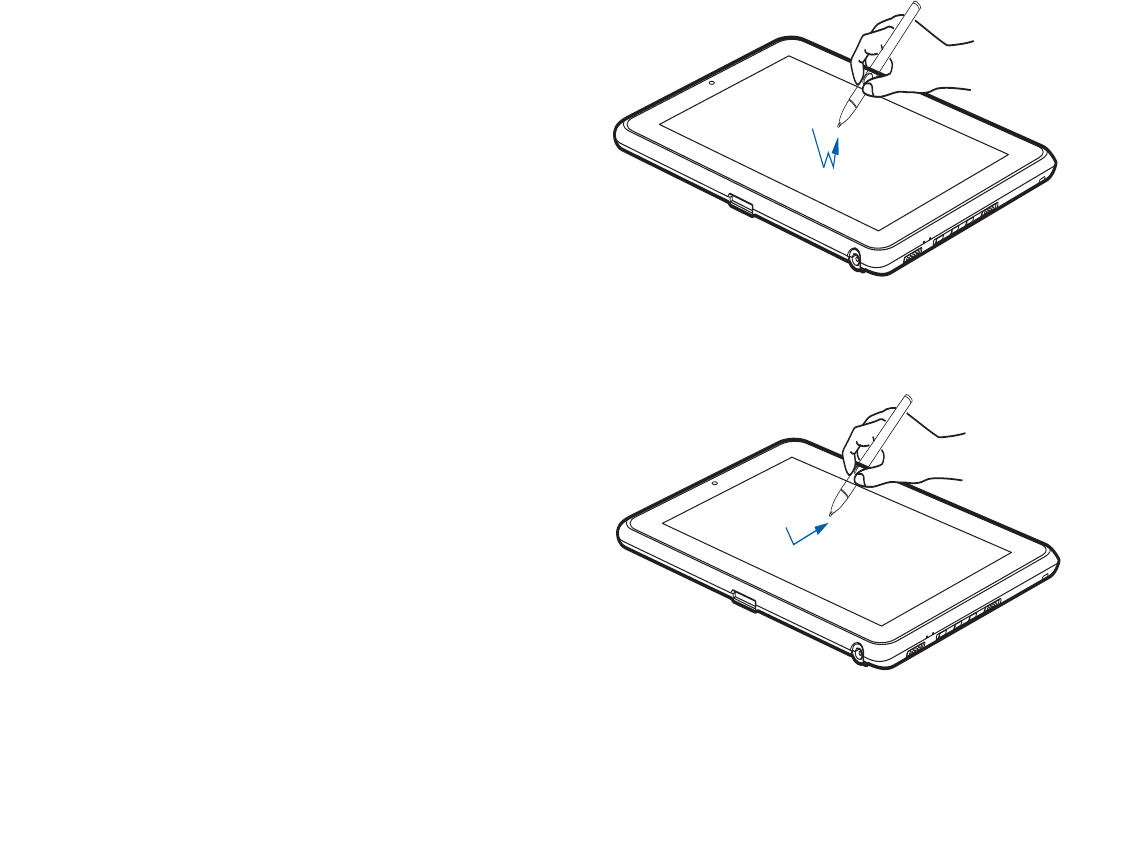
26
- Active Digitizer/Touchscreen
Double-Clicking
To double-click, touch the item twice, and then immediately
remove the stylus tip.
Figure 11. Double-clicking the Display
Dragging
Dragging means moving an item with the stylus by touching
the screen, moving and then lifting the stylus. To drag, touch
the Active Digitizer Display with your stylus on the item you
wish to move. While continuing to touch the screen with the
stylus, drag the item to its new location by moving the stylus
across the screen, and then lifting the stylus to release it.
Figure 12. Dragging on the Display

27
- Active Digitizer/Touchscreen
Calibrating the Display
In order to ensure accurate tracking between the stylus and cursor, you must run the Calibration Utility before you use
the system for the first time, or after you change the display resolution.
To run the calibration utility:
1Go to Start -> Control Panel.
2Double-click the Tablet Settings icon and select the Display tab
3Click the [Calibrate] button, then select whether you want to calibrate pen input or touch input.
4Adjust the display of your Hybrid Tablet to a comfortable angle and find the (+) symbol in the upper-left corner
of the display.
5Using the stylus or your finger (depending upon which type of input you are calibrating), firmly touch the screen
directly on the (+) symbol. Lift the stylus from the screen and the target will move to a different location on the
screen.
6Repeat step 5 until you have selected all of the (+) symbols.
7Once you have selected all the symbols, press the [OK] button.
8Touch the stylus to various points on the screen to verify that the screen is correctly calibrated. If you are not
satisfied with the screen’s calibration, press the [Calibrate]) button to begin again.
DO NOT USE EXCESSIVE FORCE WHEN TAPPING ON THE SCREEN DURING CALIBRATION. USE OF EXCESSIVE FORCE COULD RESULT IN DAMAGE TO THE
LED AND/OR TOUCH PANEL.

28
- Active Digitizer/Touchscreen
Using the Capacitive Touchscreen
Certain configurations of this Hybrid Tablet have an optional dual digitizer that allows you to use either the stylus or
your finger(s) as a pointing device. This type of display also allows you to use “gestures” to perform such actions as
scroll, zoom, and rotate.
Right-clicking the touchscreen
To perform a right-click action using two fingers, press the first finger at the location you want to perform a right-click,
then quickly tap and release the second finger on the screen.
Gesture Mode
To initiate gesture mode, two fingers must touch the screen within 200 ms of each other. If the second finger touches
the screen after 200 ms has elapsed, the second finger is ignored. If more than two fingers touch the screen in that
time, Advanced Gesture Mode is activated instead. When Gesture Mode is activated, no cursor movement is sent to
the system.
When both fingers are removed, Gesture mode ends. When a third finger is added, gesture mode ends and Advanced
gesture mode is activated. Note that if a gesture can’t be recognized, no action is taken. In that case, remove both
fingers from the screen and try again.
Scrolling Gesture
To scroll through long documents or on a web page, place both fingers on the screen (one finger quickly followed by
the second). If at least one finger has moved at least 3 mm, a scroll is considered. If both fingers are moving in the
same direction and parallel (given a tolerance of 5 mm), Scroll Mode is activated. If one finger is stationary, it is not
considered a scroll. If either finger is lifted, Scroll Mode is canceled.
•GESTURE SUPPORT IS DETERMINED BY THE APPLICATION IN USE.
•THE STYLUS TAKES PRECEDENCE OVER FINGER TOUCH. IF THE STYLUS IS WITHIN ACTIVE RANGE OF THE SCREEN, FINGER TOUCH WILL BE DISABLED.
•WHEN ONE FINGER IS USED ON THE TOUCHSCREEN, IT BEHAVES IN THE SAME MANNER AS A STYLUS.

29
- Active Digitizer/Touchscreen
Zoom Gesture
The zoom gesture is especially helpful when viewing pictures. To zoom in, place two fingers on the item you want to
enlarge (one finger quickly followed by the second), then spread them away from each other.
If at least one finger has moved at least 10 mm, a zoom event is considered. If the distance between the fingers has
changed by at least 10 mm, and both fingers have stayed on approximately the same line, Zoom Mode is entered. If
either finger strays more than 10 mm from the "zoom line" created when the fingers first made contact, the zoom is
canceled.
To zoom out, place two fingers on the item you want to reduce (one finger quickly followed by the second), then move
them towards each other.
Rotate Gesture
To change the orientation of an object on the screen, place two fingers on the image you want to rotate (one finger
quickly followed by the second), then move them in opposite directions (as if you were turning a knob). The direction
the item turns is dependant upon the direction you move your fingers.
If at least one finger moves at least 12 mm, a rotate is considered. If one finger is stationary (moving less than 5 mm
in any direction), and the other is moving, a rotate is considered. If the fingers begin moving in the same direction,
the rotation is canceled. If the distance between the fingers changes by more than 10 mm, the rotation is canceled.
Accessing the OnScreen TouchPad
Your tablet has a handy on-screen touchpad that offers a variety of helpful functions. Features of the OnScreen
TouchPad include:
•Virtual Mouse Emulator: The Virtual Mouse Emulator works in much the same manner as a hardware mouse.
With the virtual mouse, you can scroll, drag, and click, as well as perform [Ctl]+[Click] and [Shift]+[Click]
actions.
•Application Launch/Key Macro: This window provides access to five pages, each of which can contain up to
twenty buttons. Each button can be programmed to open an application, a folder, document, or key (such as
[Esc], [ Alt+X] and [Page Up]).
•Digital Keyboard: This window provides a soft keyboard for use in mathematical procedures. It works in much
the same way as the Windows standard calculator.

30
- Active Digitizer/Touchscreen
To access the OnScreen TouchPad, go to the Start Menu > All Programs > Fujitsu OnScreen TouchPad. To learn more
about the utility, click on Usage and Help.
Using the Nuance SoftKeyboard
For general information about using the Nuance SoftKeyboard, please refer to your Getting Started Guide that came
with the system. If you have questions about the Nuance SoftKeyboard, or you would like to learn more, click the Help
icon (it looks like a question mark) in the Nuance taskbar.
Caring for the Pen
Changing the Pen Settings
There are a few changes you can make to your pen settings in order to make it more suitable to your needs (such as
changing the pressure sensitivity). To do so, go to Start > Control Panel and select one of the icon views from the “View
by:” dropdown. Click on the Pen and Touch icon to open the window from which you can change a variety of pen
settings.
•ONLY USE THE PEN PROVIDED WITH YOUR HYBRID TABLET. DO NOT USE SUBSTITUTE PEN TIPS THAT WERE NOT SPECIALLY DESIGNED FOR YOUR
TABLET. REPLACE THE STYLUS TIP IF IT IS WORN. THE WARRANTY DOES NOT COVER A SCRATCHED SCREEN.
•WHILE WRITING, DO NOT TO SCRATCH THE SURFACE OF THE DISPLAY (E.G., WITH A WRISTWATCH OR BRACELET).
•THE PEN OF YOUR HYBRID TABLET IS AN ELECTRONIC INSTRUMENT WHICH CAN BE DAMAGED IF USED INCORRECTLY. HANDLE THE PEN WITH CARE.
THE FOLLOWING LIST CONTAINS GUIDELINES FOR PROPER PEN HANDLING:
•DO NOT GESTURE WITH THE PEN OR USE IT AS A POINTER.
•NEVER USE THE PEN ON ANY OTHER SURFACE THAN THE SCREEN OF YOUR HYBRID TABLET.
•DO NOT TRY TO TURN THE THUMB GRIP ON THE PEN.
•NEVER STORE THE PEN WITH THE TIP BEARING THE WEIGHT OF THE PEN. IF THE PEN IS STORED WITH THE TIP POINTING DOWN, THIS MAY HAVE AN
ADVERSE EFFECT ON THE PEN MECHANISM (PARTICULARLY UNDER HIGH TEMPERATURES). IN THIS CASE THE PEN TIP MAY REACT AS THOUGH IT IS
CONSTANTLY BEING PRESSED DOWN.
•THE PEN CAN BE INFLUENCED BY ELECTROMAGNETIC FIELDS (CURSOR QUIVERS OR JUMPS). THERE MAY BE A FEW AREAS ON THE SCREEN WHERE THE
CURSOR QUIVERS SLIGHTLY IN SPITE OF PRESSING THE PEN DOWN FIRMLY.
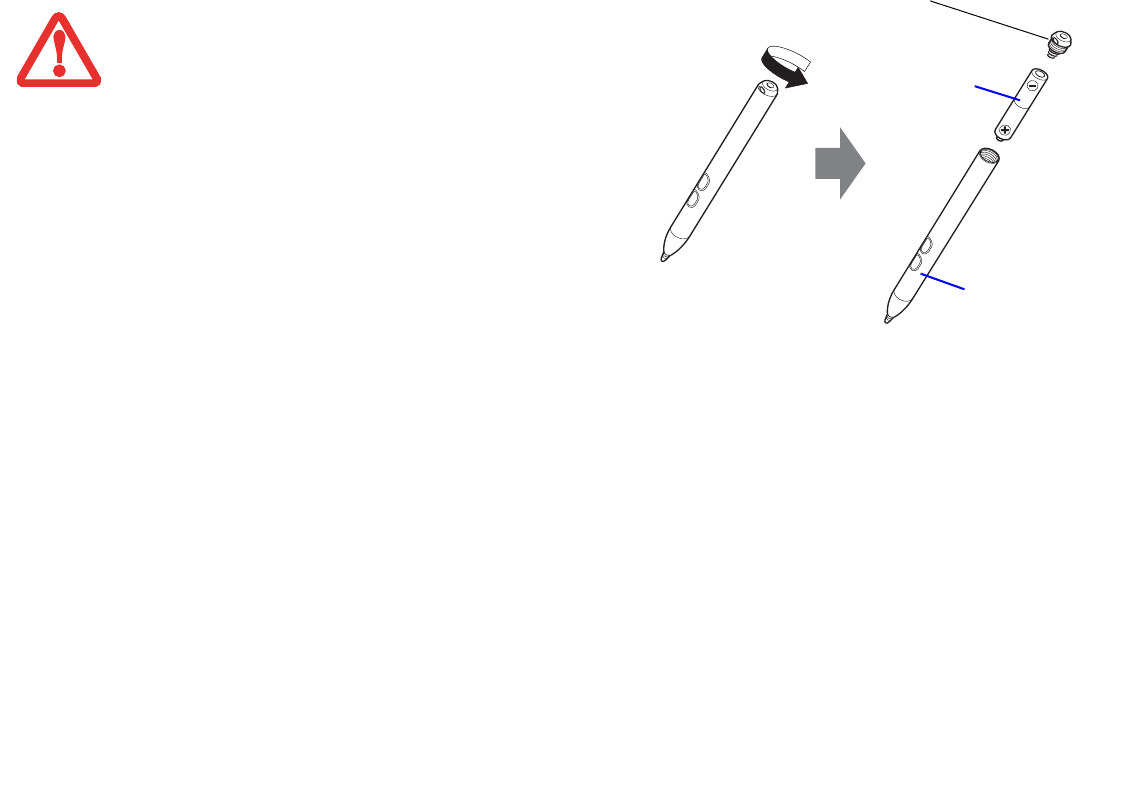
31
- Active Digitizer/Touchscreen
Changing the Pen Battery
Figure 13. Replacing the Battery
•DO NOT REMOVE THE TIP OF THE PEN TO REPLACE THE BATTERY;
REMOVE ONLY THE CAP ON THE TOP OF THE PEN.
•THERE IS A RISK OF EXPLOSION IF THE BATTERY IS REPLACED BY AN
INCORRECT TYPE. DISPOSE OF USED BATTERIES IN ACCORDANCE WITH
LOCAL INSTRUCTIONS.
The pen contains a AAAA-battery. Before proceeding, be sure
to have a new battery available.
1Remove the rear Pen Cap (Figure 13).
2Remove the battery from the pen barrel.
3Insert the new battery into the pen barrel in the same
orientation as the one that was removed.
4Close the rear Pen Cap.
Pen Cap
AAAA-battery
Pen Barrel
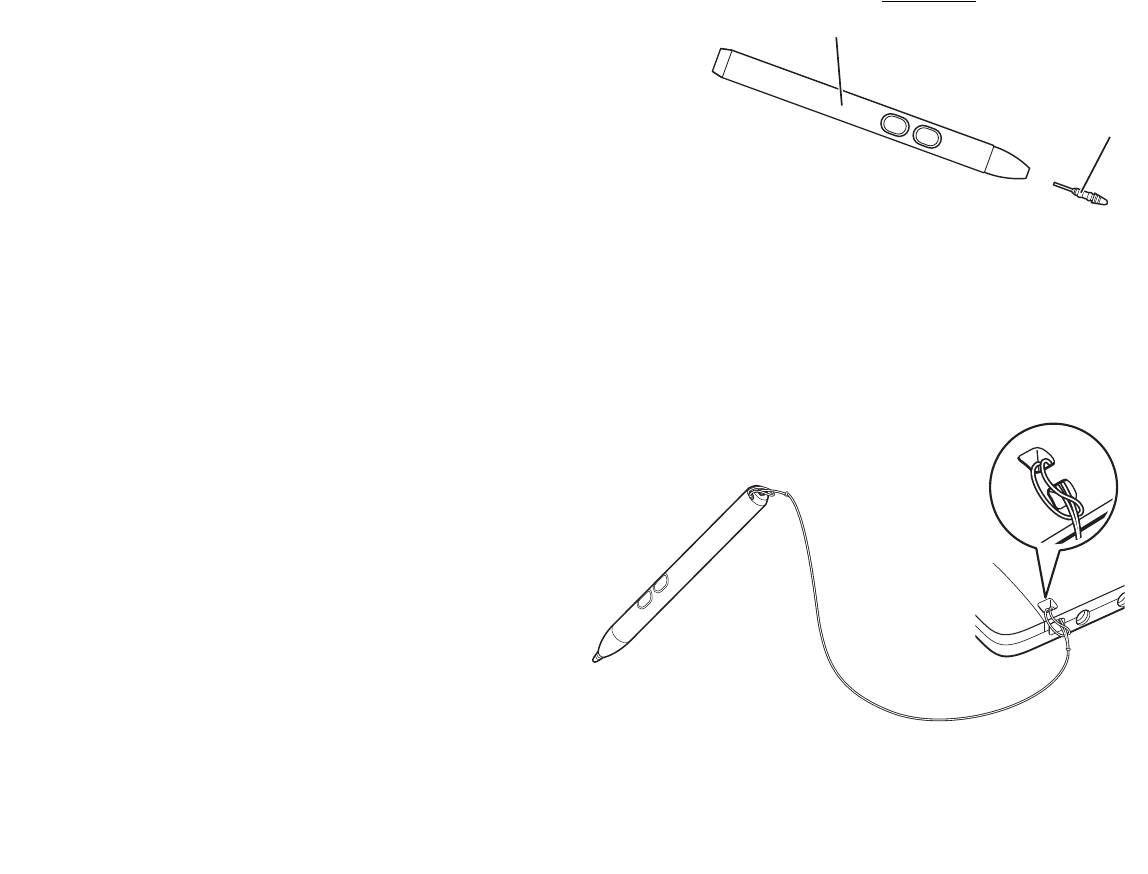
32
- Active Digitizer/Touchscreen
Replacing the Pen Tip
With use, the pen tip may become worn or may pick up foreign
particles that can scratch the screen. A damaged or worn tip may not
move freely, causing unpredictable results when using the pen. If a
problem like this should occur, you should replace the pen tip.
1Pull the tip from the barrel.
2Using one of the new tips that were supplied with your pen,
insert the pointed end of the tip into the barrel and push it in
firmly until it is in place Figure 14. Replacing the Pen Tip
Installing a Pen Tether
To prevent dropping or losing your pen, you should attach
it to your system using the pen tether that is included with
the system.
To attach the pen tether to your Hybrid Tablet, perform the
following steps:
1Attach the end of the pen tether with the smaller loop
to your pen. To do so, push the end of the tether under
the slot on the top of the pen, then thread the opposite
end of the tether through the loop.
2Attach the end of the pen tether with the larger loop to
the attachment point on the right side of your tablet.
To do so, insert the end of the pen tether through the
attachment point, then feed the pen through the large
loop in the tether.
Figure 15. Installing a Pen Tether
Pen Tip
Pen Barrel
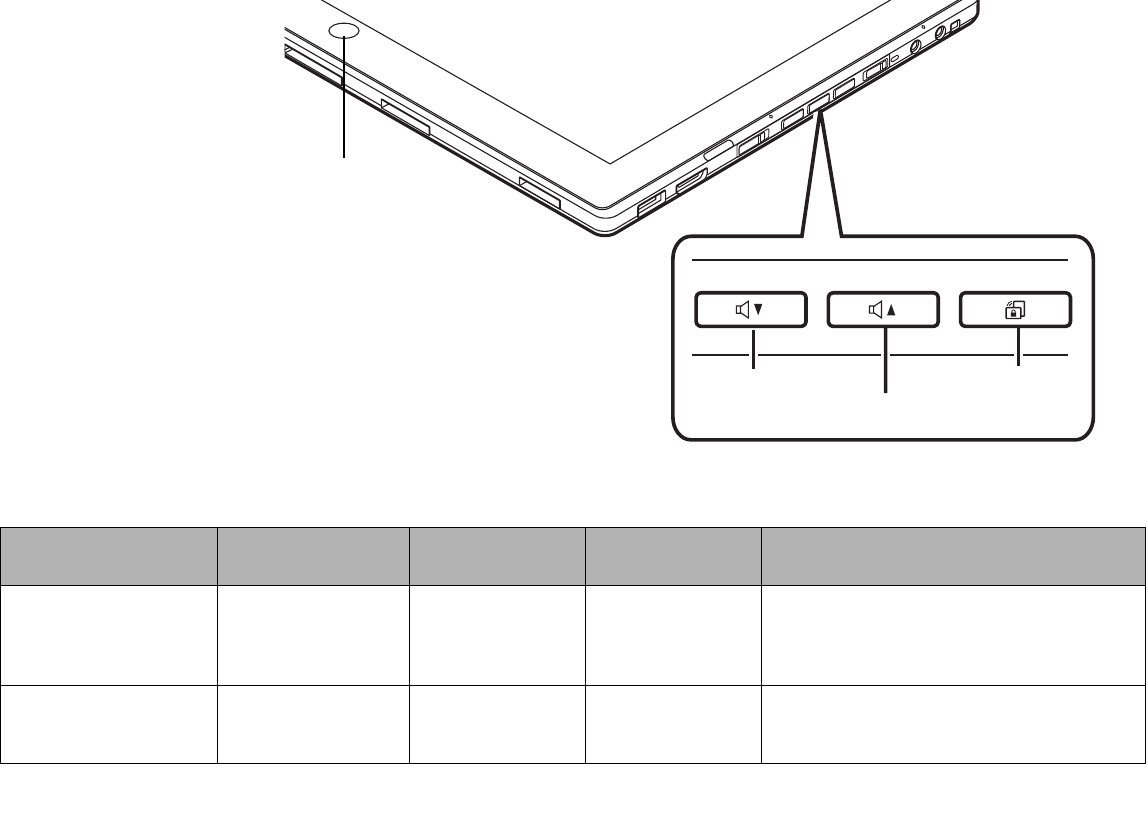
33
- Hybrid Tablet Buttons
Hybrid Tablet Buttons
The three Tablet buttons
are located on the right-
hand side of a horizon-
tally-oriented system.
The Windows button is
located at the bottom
center of the display.
Figure 16. Application buttons
Button Name Primary
Function (Press)
Press at Splash
Screen* In BIOS Setup Utility Description
Volume Down Button Volume Down Opens BIOS setup Acts as Down key
while in BIOS Setup
Pressing the Volume Down button decreases the
volume. While the system is starting up, it opens
the BIOS Setup utility, and while the BIOS is open,
it can be used to move the cursor down.
Volume Up Button Volume Up None Acts as Up key while
in BIOS Setup
Pressing the Volume Up button increases the
volume. When the BIOS is open, it can be used to
move the cursor up.
Rotation
Volume Down Button
Volume Up Button Lock Button
Windows Button

34
- Hybrid Tablet Buttons
* “Press at Splash Screen”refers to the action that occurs when you press the button when the Fujitsu logo appears when you first start up
the system.
Rotation Lock Button Enables/disable Auto
Rotation feature
Opens the Boot
menu None
Pressing and holding the button enables and
disables the Auto Rotate function. It also opens
the Boot menu if pressed while the system is
starting up.
Windows Button Open Start
menu/Ctl+Alt+Del None None
In post-logon, the Windows button can be used to
perform two functions. When pressed alone, it
opens up the Start menu. When pressed at the
same time as the power button, it acts the same
as if pressing [Ctl] + [Alt] + [Del].
Button Name Primary
Function (Press)
Press at Splash
Screen* In BIOS Setup Utility Description

35
Chapter 2
Getting Started with Your Hybrid Tablet
Power Sources
Your Fujitsu STYLISTIC Hybrid Tablet has three possible power sources: a primary Lithium Polymer battery, an AC
adapter or an optional Auto/Airline adapter.
Connecting the Power Adapters
The AC adapter or optional Auto/Airline adapter provides power for operating your Hybrid Tablet and charging the
batteries.
Connecting the AC Adapter
1Plug the DC output cable into the DC power jack of your STYLISTIC Hybrid Tablet.
2Plug the AC adapter into an AC electrical outlet.
Connecting the Optional Auto/Airline Adapter
1Plug the DC output cable into the DC power jack on your Hybrid Tablet.
2Plug the Auto/Airline adapter into the cigarette lighter of an automobile, or,
3Plug the Auto/Airline adapter into the DC power jack on an airplane seat.
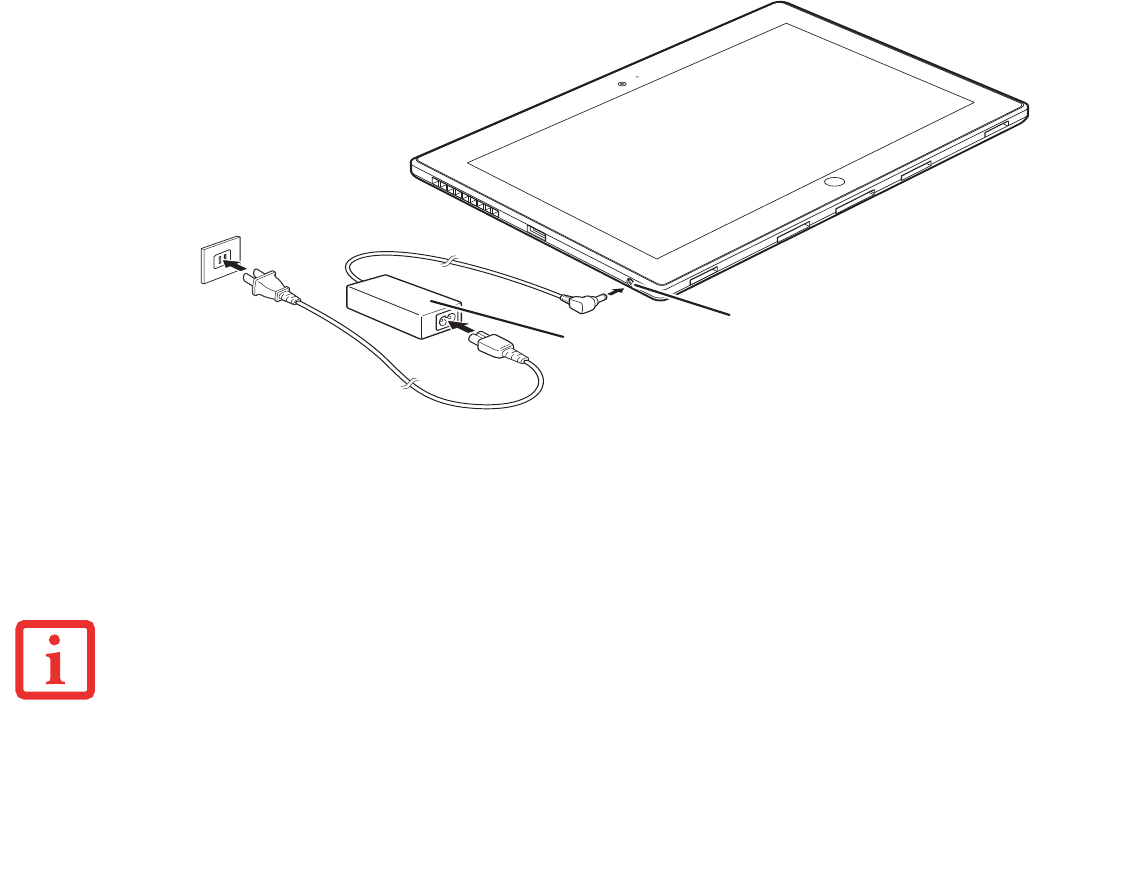
36
- Power Sources
Figure 17. Connecting the AC Adapter
Switching from AC Adapter Power or the Auto/Airline Adapter to Battery Power
1Be sure that you have at least one charged battery installed.
2Remove the AC adapter or the Auto/Airline adapter.
THE LITHIUM POLYMER BATTERY IS NOT CHARGED UPON PURCHASE. INITIALLY, YOU WILL NEED TO CONNECT EITHER THE AC ADAPTER OR THE
AUTO/AIRLINE ADAPTER TO USE YOUR HYBRID TABLET.
DC Power Jack
AC Adapter
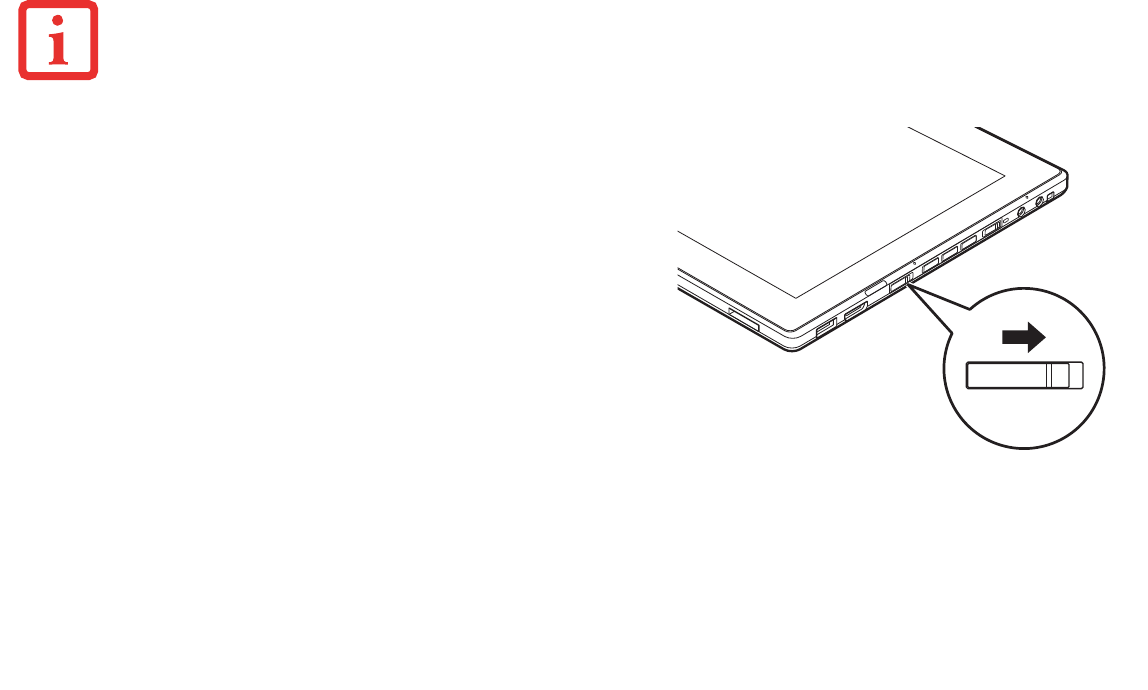
37
- Starting Your STYLISTIC Hybrid Tablet
Starting Your STYLISTIC Hybrid Tablet
Power On
Power/Suspend/Resume Switch
The Power/Suspend/Resume switch is used to turn on your STYLISTIC Hybrid Tablet from its off state. Once you have
connected your AC adapter or charged the internal Lithium Polymer battery, you can power on your tablet.
WHEN YOU TURN ON YOUR STYLISTIC HYBRID TABLET BE SURE YOU HAVE A POWER SOURCE. THIS MEANS THAT AT LEAST ONE BATTERY IS
INSTALLED AND CHARGED, OR THAT THE AC OR AUTO/AIRLINE ADAPTER IS CONNECTED AND HAS POWER.
To turn on your STYLISTIC Hybrid Tablet from its off state, slide the
Power/Suspend/Resume switch, located on the right side of the
tablet (when the system is held horizontally). When you are done
working you can either leave your Hybrid Tablet in Suspend mode
or you can turn it off. See “Sleep Mode” on page 41 and “Powering
Off” on page 43
.
When you power on your STYLISTIC, it will perform a Power On
Self Test (POST) to check the internal parts and configuration for
correct functionality. If a fault is found, your STYLISTIC Hybrid
Tablet will emit an audio warning and/or an error message will be
displayed. See “Power On Self Test Messages” on page 60.
Depending on the nature of the problem, you may be able to
continue by starting the operating system or by entering the BIOS
setup utility and revising the settings.
After satisfactory completion of the POST, your tablet will load
your operating system.
Figure 18. Power/Suspend/Resume Switch

38
- Starting Your STYLISTIC Hybrid Tablet
Boot Sequence
The procedure for starting-up your tablet is termed the Bootup sequence and involves your tablet’s BIOS. When your
tablet is first turned on, the main system memory is empty, and it needs to find instructions to start up your tablet.
This information is in the BIOS program. Each time you power up or restart your tablet, it goes through a boot
sequence which displays a Fujitsu logo until the operating system is found. During booting, your tablet is performing
a standard boot sequence including a Power On Self Test (POST). When the boot sequence is completed without a
failure and without a request for the BIOS Setup Utility, the system displays the operating system’s opening screen.
The boot sequence is executed when:
•You turn on the power to your tablet.
•You restart your tablet from the Windows Shut Down dialog box.
•The software initiates a system restart; for example, when you install a new application.
Hard Disk Drive Passwords
To provide additional security for your data, you can assign passwords to your hard disk drive(s). This feature is
managed in the system BIOS Setup Utility. See
BIOS Setup Utility
below for information about accessing the utility.
BIOS Setup Utility
The BIOS Setup Utility sets up the operating environment for your tablet. Your BIOS is set at the factory for normal
operating conditions, therefore there is no need to set or change the BIOS’ environment to operate your tablet.
NEVER TURN OFF YOUR STYLISTIC HYBRID TABLET DURING THE POWER ON SELF TEST (POST) OR IT WILL CAUSE AN ERROR MESSAGE TO BE
DISPLAYED WHEN YOU TURN YOUR STYLISTIC HYBRID TABLET ON THE NEXT TIME.
See “Power On Self Test Messages” on page 60.
REMEMBER YOUR PASSWORDS. IF YOU SET AND FORGET YOUR USER AND MASTER HARD DISK PASSWORDS, FUJITSU AMERICA WILL NOT BE ABLE
TO RESET IT. YOU MAY LOSE DATA AND HAVE TO REPLACE YOUR SYSTEM BOARD OR HARD DISK DRIVE.

39
- Starting Your STYLISTIC Hybrid Tablet
The BIOS Setup Utility also allows you to configure such features as the System Data Security feature parameters, such
as passwords.
Entering the BIOS Setup Utility
To enter the BIOS Setup Utility do the following:
1Turn on or restart your tablet.
2To enter the BIOS Setup Utility, press the [F2] key once the Fujitsu logo appears on the screen. This will open the
main menu of the BIOS Setup Utility with the current settings displayed.
Press the right or left arrow keys key to scroll through the other setup menus to review or alter the current settings.
BIOS Guide
A guide to your tablet’s BIOS is available online at our service and support Website at:
http://solutions.us.fujitsu.com/www/content/support/contact/index.php. Once there, select User’s Guides under
Online Support. Select your Product, Series, and Model, then click [Go].
Booting the System
We strongly recommend that you not attach any external devices or put a DVD/CD in your drive until you have gone
through the initial power on sequence.
When you turn on your tablet for the first time, it will display a Fujitsu logo on the screen. If you do nothing the system
will load the operating system, and then the Windows Welcome will begin.
Starting Windows the First Time
After you boot up the system the first time and follow the instructions on the screen, you will eventually come to the
Welcome window. After the Welcome window appears, the screen will black out for up to several minutes. This is
normal. DO NOT ATTEMPT TO POWER DOWN THE SYSTEM AT THIS POINT. While the screen is blacked out, your
system configuration is being set up and the necessary files are being installed.
IF YOUR DATA SECURITY SETTINGS REQUIRE IT, YOU MAY BE ASKED FOR A PASSWORD BEFORE THE BIOS MAIN MENU WILL APPEAR.

40
- Starting Your STYLISTIC Hybrid Tablet
During the course of the first start up, you will need to read and accept the End User License Agreements (EULAs) for
Microsoft and Fujitsu.
Several additional windows will appear, prompting you to enter a name and description for your computer, an
Administrator password, and a domain name. Read the instructions on the screens carefully and fill in the
information as directed.
Installing Bonus Apps
After you have started your system the first time, you will see a Bonus Apps icon on your desktop. Click on
the icon to see which additional applications are available for you to install. Applications that are already
installed appear in grey; those that are available for installation appear in blue.
Select the applications you wish to install by selecting the checkbox adjacent to your selection, or click [Select All] if
you would like to install all available applications. Once you have made your selections, click [Install].
Note that in some cases (depending upon which application was selected for installation) after installation
completes, the system will prompt you to reboot. There are also cases in which if multiple applications are selected
to install but one of them needs a reboot, the system will reboot and continue installing the rest of the selected
applications.
Registering your Tablet with Fujitsu
You can register your tablet by going to our website at: https://store.shopfujitsu.com/fpc/Ecommerce/Service.jsp. You
will need to be set up with an Internet Service Provider (ISP) to register online.
•IF YOU REJECT THE TERMS OF THE LICENSE AGREEMENT YOU WILL BE ASKED TO REVIEW THE LICENSE AGREEMENT FOR INFORMATION ON
RETURNING WINDOWS OR TO SHUT DOWN YOUR TABLET.
•YOU CANNOT USE YOUR TABLET UNTIL YOU HAVE ACCEPTED THE LICENSE AGREEMENT. IF YOU STOP THE PROCESS YOUR TABLET WILL RETURN TO
THE BEGINNING OF THE WINDOWS WELCOME PROCESS, EVEN IF YOU SHUT YOUR TABLET DOWN AND START IT UP AGAIN.

41
- Power Management
Power Management
Your Fujitsu STYLISTIC Hybrid Tablet has many options and features for conserving battery power. Some of these
features are automatic and need no user intervention. However, others depend on the parameters you set to best suit
your operating conditions, such as those for the display brightness. Internal power management for your Hybrid
Tablet may be controlled from settings made in your operating system, pre-bundled power management application,
or from settings made in BIOS setup utility.
Besides the options available for conserving battery power, there are also some things that you can do to prevent
your battery from running down as quickly. For example, you can create an appropriate power saving profile, put your
Hybrid Tablet into Sleep mode when it is not performing an operation, and you can limit the use of high power
devices. As with all mobile, battery powered computers, there is a trade-off between performance and power savings.
Power/Suspend/Resume Switch
When your Hybrid Tablet is active, the Power/Suspend/Resume switch can be used to manually put the Hybrid Tablet
into Sleep mode. Slide the Power/Suspend/Resume switch when the Hybrid Tablet is active, but not actively accessing
anything, and immediately release the button.
If your tablet is suspended, sliding the Power/Suspend/Resume switch returns it to active operation. You can tell
whether the system is Suspended by looking at the Power indicator. If the indicator is visible and not flashing, your
Hybrid Tablet is fully operational. If the indicator is visible
and
flashing, the tablet is in Sleep mode. If the indicator
is not visible, the power is off or your tablet is in Hibernation mode.
Sleep Mode
Sleep mode in Windows saves the contents of your system memory during periods of inactivity by maintaining power
to critical parts. This mode turns off the CPU, display, hard drive, and all other internal components except those
necessary to maintain system memory and for restarting.
Your Hybrid Tablet can be put in sleep mode by:
•Sliding the Power/Suspend/Resume switch when your system is turned on.
•Selecting “Sleep” after clicking [Start] then clicking the small arrow at the bottom right of the window.
•Timing out from lack of activity.
•Allowing the battery to reach the Dead Battery Warning condition.

42
- Power Management
Your Hybrid Tablet’s system memory typically stores the file on which you are working, open application information,
and any other data required to support operations in progress. When you resume operation from Sleep mode, your
tablet will return to the point where it left off. You must use the Power/Suspend/Resume switch to resume operation,
and there must be an adequate power source available, or your Hybrid Tablet will not resume.
Hibernation Feature
The Hibernation feature saves the contents of your Hybrid Tablet’s system memory to the hard drive as a part of the
Suspend/Resume mode. Hibernation is enabled by default.
Defining Power Button Action
To determine what occurs when the power button is pressed, follow these steps:
1From the Start menu, select Control Panel, then select the Power Options icon.
2Select “Choose what the power button does”, then make your selections (Do Nothing, Sleep, Hibernate, or Shut
Down).
Windows Power Management
The Power Options icon located in the Windows Control Panel allows you to configure some of the power
management settings. For example, you can use the Power Options to set the timeout values for turning off the
display and hard disks whether you are running the Hybrid Tablet on battery power or one of the adapters.
•IF RUNNING YOUR TABLET ON BATTERY POWER, BE AWARE THAT THE BATTERY CONTINUES TO DISCHARGE WHILE YOUR TABLET IS IN SLEEP MODE,
THOUGH NOT AS QUICKLY AS WHEN FULLY OPERATIONAL.
•DISABLING THE POWER/SUSPEND/RESUME SWITCH PREVENTS IT FROM BEING USED TO PUT THE TABLET INTO SLEEP OR HIBERNATION MODE. THE
BUTTON RESUME FUNCTION CANNOT BE DISABLED.
•IF YOUR TABLET IS ACTIVELY ACCESSING INFORMATION WHEN YOU ENTER THE SLEEP OR HIBERNATION MODE, CHANGES TO OPEN FILES ARE NOT
LOST. THE FILES ARE LEFT OPEN AND MEMORY IS KEPT ACTIVE DURING SLEEP MODE OR THE MEMORY IS TRANSFERRED TO THE INTERNAL HARD
DRIVE DURING HIBERNATION MODE.
•THE MAIN ADVANTAGE OF USING HIBERNATION IS THAT POWER IS NOT REQUIRED TO MAINTAIN YOUR DATA. THIS IS PARTICULARLY IMPORTANT IF
YOU WILL BE LEAVING YOUR TABLET IN A SUSPENDED STATE FOR A PROLONGED PERIOD OF TIME. THE DRAWBACK OF USING HIBERNATION MODE
IS THAT IT LENGTHENS THE POWER DOWN AND POWER UP SEQUENCES AND RESETS PERIPHERAL DEVICES.

43
- Power Management
Restarting the System
If your system is on and you need to restart it, be sure that you use the following procedure.
1Click the [Start] button, and then move the mouse over the small arrow at the bottom right of the right-hand
pane.
2Select Restart from the list.
Powering Off
If you turn off the power while accessing a disk there is a risk of data loss. To ensure that your Hybrid Tablet shuts
down without error, use the Windows shut down procedure.
Using the correct procedure to shut down from Windows allows your Hybrid Tablet to complete its operations and turn
off power in the proper sequence to avoid errors. The proper sequence is:
1Click the [Start] button, and then move the mouse over the small arrow at the bottom right of the right-hand
pane.
2Select Shut Down from the list.
If you are going to store your Hybrid Tablet for a month or more, see Care and Maintenance Section on page page 70.
TURNING OFF YOUR STYLISTIC HYBRID TABLET WITHOUT EXITING WINDOWS OR TURNING ON YOUR HYBRID TABLET WITHIN 10 SECONDS OF THE
SYSTEM BEING SHUT OFF MAY CAUSE AN ERROR WHEN YOU START THE NEXT TIME.
BE SURE TO CLOSE ALL FILES, EXIT ALL APPLICATIONS, AND SHUT DOWN YOUR OPERATING SYSTEM PRIOR TO TURNING OFF THE POWER. IF FILES ARE
OPEN WHEN YOU TURN THE POWER OFF, YOU WILL LOSE ANY CHANGES THAT HAVE NOT BEEN SAVED, AND MAY CAUSE DISK ERRORS.
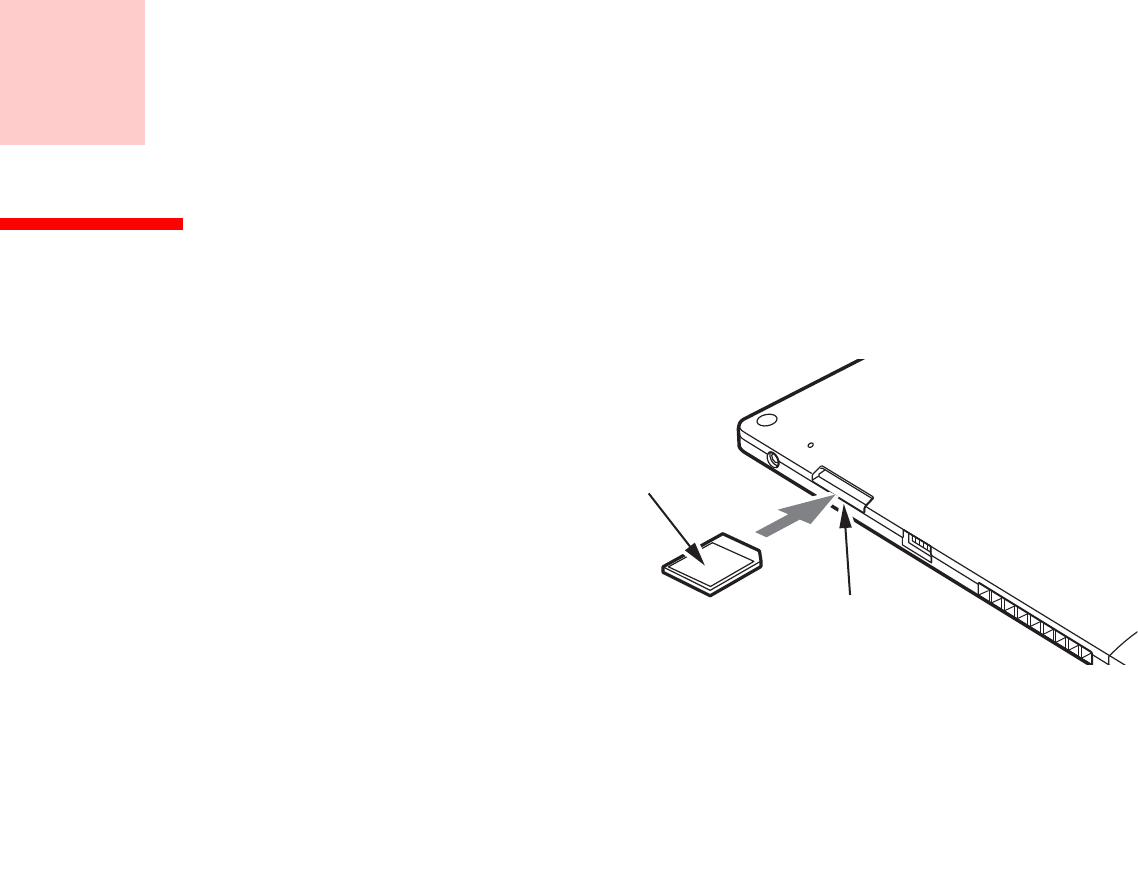
44
Chapter 3
User-Installable Features
Secure Digital Cards
Your STYLISTIC Hybrid Tablet supports Secure Digital
(SD) cards, on which you can store and transfer data to
and from a variety of digital devices. These cards use
flash memory architecture, which means they don’t
need a power source to retain data. Note that SD and
SDHC Cards are supported, but SDXC Cards are not.
SD Cards allow portable storage among a variety of
devices, such as cell phones, GPS systems, digital
cameras, and PDAs. SD Cards transfer data quickly, with
low battery consumption.
Figure 19. SD Card Slot - Rear Access
SD Card
SD Card Slot

45
- Secure Digital Cards
Installing SD Cards
When holding the Hybrid Tablet in horizontal position with the bottom side up and the fingerprint sensor at the
bottom left, the SD Card slot is located near the DC port on the left side of the system (Figure 19). To install an SD
Card, follow these steps:
1See your specific card manual for instructions on the installation of your card. Some cards may require that your
Hybrid Tablet is off while installing them.
2Make sure there is no card currently in the slot. If there is, see Removing an SD Card.
3With the product label facing in the same direction as the display screen, insert your card into the slot.
4Push the card firmly into the slot until it is seated in the connector.
Removing an SD Card
To remove an SD Card, follow these easy steps:
1Select Safely Remove Hardware from the System Tray. Highlight the card in the list, then click [Stop].
2Push the SD Card in until it unlatches. It will then eject from the slot for removal.
INSTALLING OR REMOVING AN SD CARD DURING YOUR STYLISTIC HYBRID TABLET’S SHUTDOWN OR BOOTUP PROCESS MAY DAMAGE THE CARD
AND/OR YOUR STYLISTIC HYBRID TABLET.
DO NOT INSERT A CARD INTO A SLOT IF THERE IS WATER OR ANY OTHER SUBSTANCE ON THE CARD AS YOU MAY PERMANENTLY DAMAGE THE CARD,
YOUR STYLISTIC HYBRID TABLET, OR BOTH.
SEE YOUR CARD MANUAL FOR SPECIFIC INSTRUCTIONS ON THE REMOVAL OF YOUR CARD. SOME CARDS MAY REQUIRE YOUR STYLISTIC HYBRID TABLET
TO BE IN SLEEP MODE OR OFF WHILE REMOVING THEM.
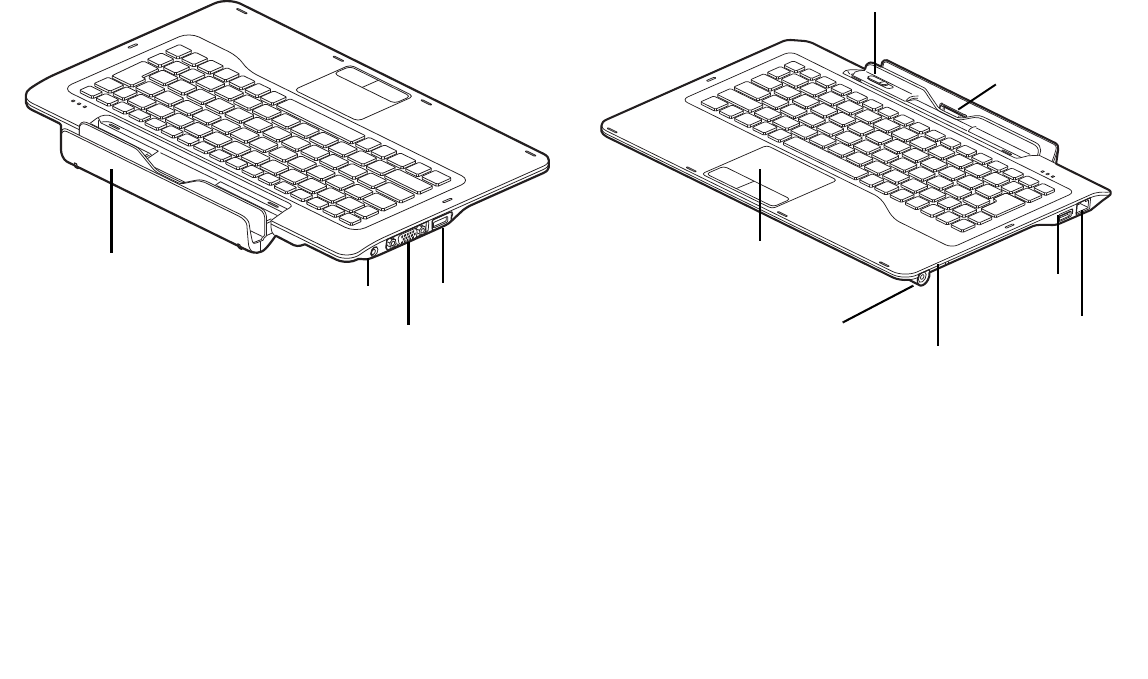
46
- Keyboard Docking Station
Keyboard Docking Station
The optional keyboard docking station extends the functionality of your STYLISTIC® Tablet and turns it into a truly
“hybrid” system by providing a keyboard, touchpad, rechargeable and removable battery, status LEDs, two USB 2.0
ports, a LAN port, external monitor port, and DC power.
The docking station connects to the bottom edge of your STYLISTIC Hybrid Tablet, and folds up to create a protective
cover over the display.
Figure 20. Docking Station - Rear Figure 21. Docking Station - Front
DC In USB 2.0 port
External Monitor Connector
Tablet Support
Docking
Connector
USB 2.0 port
LAN (RJ-45) Jack
Touchpad
Pen garage
Tablet Support Release Latch
Pen Release

47
-
Docking Station Components
The following is a brief description of the docking station’s panel components. (Figures 20 and 21).
Tablet Support Release Latch
The tablet support on the back of the docking station acts as a support when it is open so that you can use the tablet
in a hands-free vertical position and close it as a traditional notebook. To release the panel from the back of the
docking station, slide the latch to the right. To attach it to the docking station, set the tablet into the tablet support,
then snap the two together.
USB 2.0 Ports (Qty. 2)
Universal Serial Bus (USB) 2.0 ports allow you to connect USB devices. USB 2.0 ports are backward-compatible with
USB 1.1 devices. There are two USB ports on the docking station: one on the left side and one on the right side.
DC Power Jack
The DC power jack allows you to plug in the AC adapter to power your Hybrid Tablet and charge the internal battery.
LAN (RJ-45) Jack
The internal LAN (RJ-45) jack is used for an internal LAN connection.
External Monitor Connector
The external monitor connector allows you to connect an external monitor or LCD projector.
Docking Connector
The docking connector allows you to connect the Docking Station to your STYLISTIC Hybrid Tablet.
Touchpad Pointing Device
The Touchpad pointing device is a mouse-like cursor control with two buttons (left and right).
THE SYSTEM CONTAINS COMPONENTS THAT CAN BE SEVERELY DAMAGED BY ELECTROSTATIC DISCHARGE (ESD). TO MINIMIZE RISK TO THE
COMPONENTS, OBSERVE THE FOLLOWING PRECAUTIONS:
•BEFORE DOCKING OR UNDOCKING YOUR STYLISTIC WHEN USING A DOCKING STATION, YOU SHOULD TOUCH A GROUNDED METAL OBJECT TO
DISCHARGE STATIC ELECTRICITY BUILT UP IN YOUR BODY.
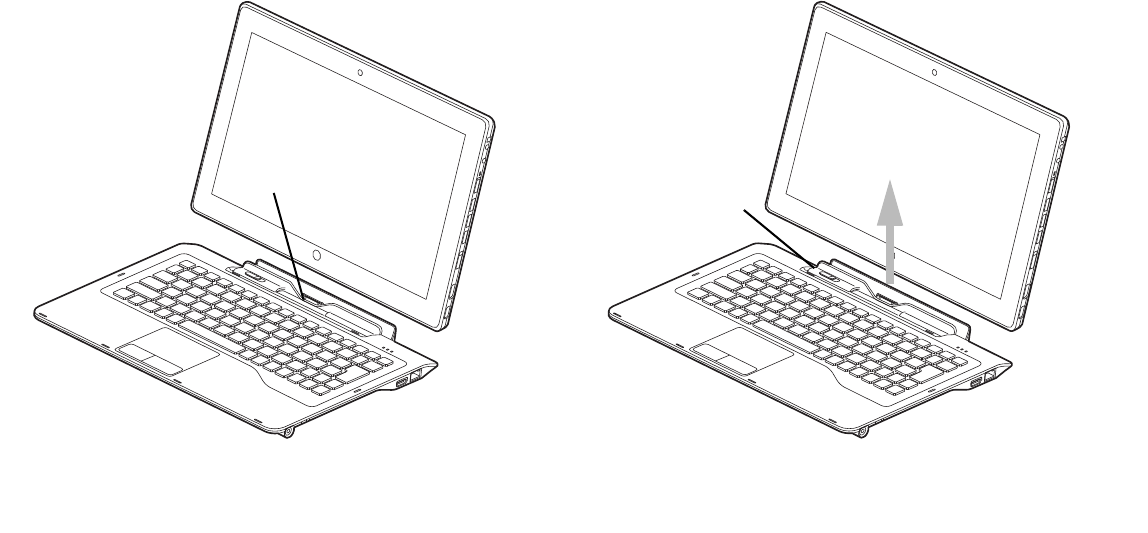
48
-
Pen Garage
The pen garage is used to store the pen when it is not in use. This helps you keep track of the pen so it is not misplaced
or lost. The pen garage sits directly below the pen tether attachment point when the system is closed while in
notebook configuration.
Pen Release
The pen release is used to eject the pen from the pen garage. Slide the pen release to the left when the pen is in the
garage; doing so will cause the pen to pop out of the garage.
Attaching the Docking Station
To attach the Docking Station, align the docking connector on the bottom of your Hybrid Tablet with the connector
on the Docking Station and push the corners down simultaneously. (Figure 22)
Figure 22. Attaching the Docking Station Figure 23. Detaching the Docking Station
Docking
Connector
Tablet Support
Release Latch
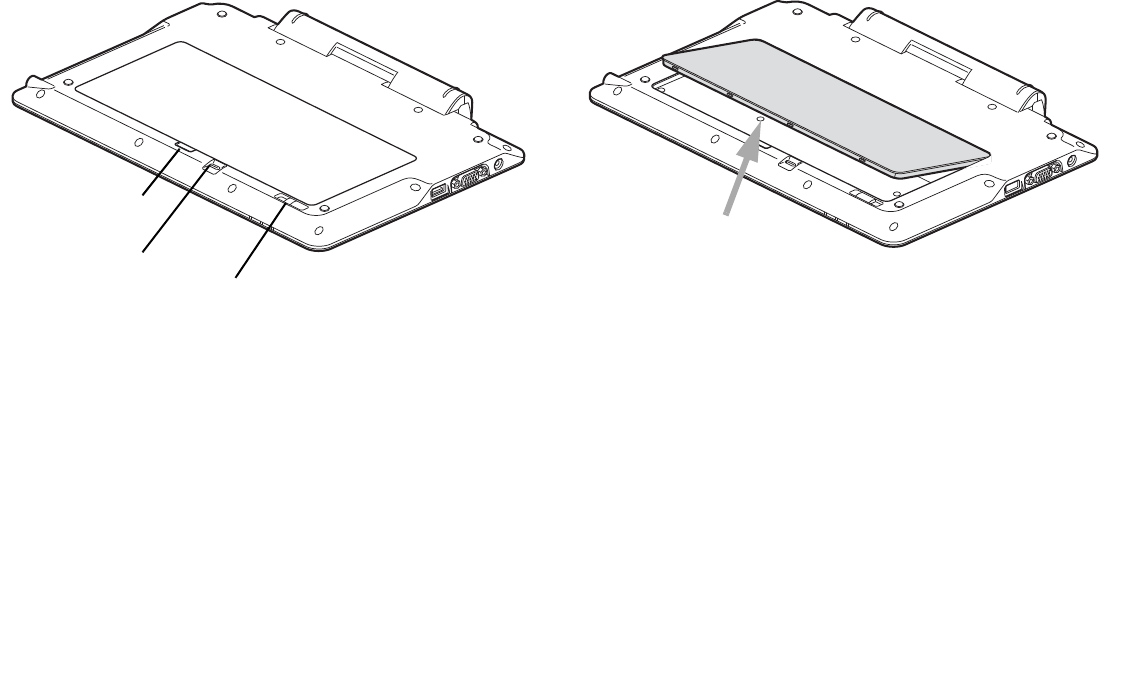
49
-
Detaching Docking Station
To detach the Docking Station, slide the tablet support release latch to the right and lift the Hybrid Tablet away from
the Docking Station to detach it. (Figure 23)
Changing the Battery
The keyboard docking station is equipped with a rechargeable, removable battery. The battery can be charged by
connecting the AC Adapter to the DC In port on the left side of the docking station (Figure 20).
To remove the battery for replacement with a new battery or when storing the docking station for a long period of
time, perform the following steps (Figure 25):
1Turn the docking station upside down.
2While pushing the battery lock, slide the battery latch to release the battery.
3Lift the battery at the lift point and remove it from the battery bay.
Figure 24. Docking Station - Bottom Figure 25. Removing the Battery
Battery Lock
Battery Latch
Lift Point
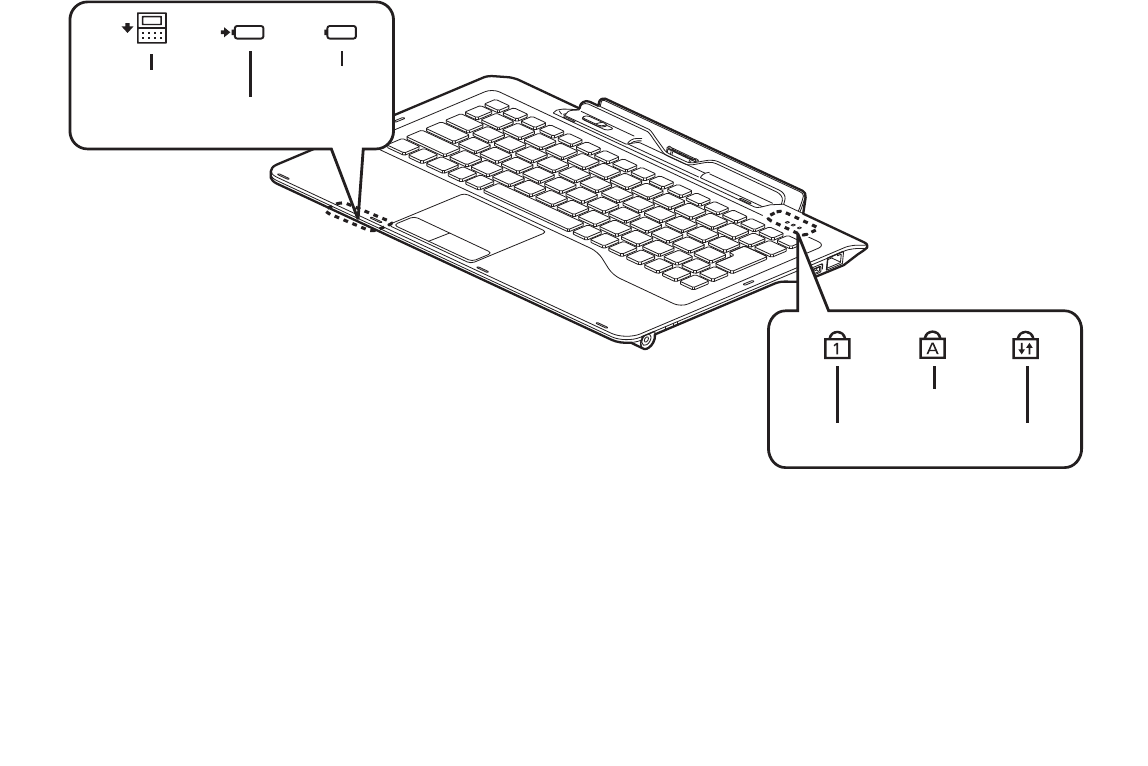
50
-
Docking Station Status Indicators
There are two sets of status indicators on the docking status, one on the left front edge and one on the left back
corner.
Figure 26. Docking Station Status Indicators
Docking Indicator
The docking indicator lights when the tablet is properly seated in the tablet support.
Battery Charge Indicator
The battery charge indicator shows the charging status of the keyboard dock battery. (See Table 1 on page 21 for
equivalent system indicator states).
Docking Indicator
Battery Charging
Battery Level
Num Lock
Caps Lock
Scroll Lock

51
-
Battery Level Indicator
The Battery Level indicator displays the charge level of the keyboard dock battery pack. (See Table 1 on page 21 for
equivalent system indicator states).
NumLk Indicator
The NumLk indicator shows that the integral keyboard is set in ten-key numeric keypad mode.
CapsLock Indicator
The CapsLock indicator shows that your keyboard is set to type in all capital letters.
ScrLk Indicator
The ScrLk indicator shows that your scroll lock is active.

52
Chapter 4
Troubleshooting Your Hybrid Tablet
Troubleshooting
There may be occasions when you encounter simple setup or operating problems that you can solve on the spot, or
problems with peripheral devices that can be solved by replacing the device. The information in this section helps you
isolate and resolve some of these straightforward issues and identify failures that require service.
Identifying the Problem
If you encounter a problem, go through the following procedure before pursuing complex troubleshooting:
1Turn off your STYLISTIC Hybrid Tablet.
2Make sure the AC adapter is plugged into your Hybrid Tablet and to an active AC power source.
3Make sure that any cards installed are seated properly. If it appears that there is a problem with a card, remove
the card from the slot, thus eliminating it as a possible cause of failure.
4Make sure that any devices connected to the external connectors are plugged in properly. You can also disconnect
such devices, thus eliminating them as possible causes of failure.
5Turn on your Hybrid Tablet. Make sure it has been off at least 10 seconds before you turn it back on.
6Go through the boot sequence.
7If the problem has not been resolved, refer to the Troubleshooting Table that follows for more detailed
troubleshooting information.

53
- Troubleshooting
8If you have tried the solutions suggested in the Troubleshooting Table without success, contact your support
representative:
Toll free: 1-800-8FUJITSU (1-800-838-5487)
Web site: http://solutions.us.fujitsu.com/www/content/support/contact/index.php.
Before you place the call, you should have the following information ready so that the customer support
representative can provide you with the fastest possible solution:
•Product name
•Product configuration number
•Product serial number
•Purchase date
•Conditions under which the problem occurred
•Any error messages that have occurred
•Type of device connected, if any
See the Configuration Label on the bottom of your Hybrid Tablet for configuration and serial numbers.
IF YOU KEEP NOTES ABOUT WHAT YOU HAVE TRIED, YOUR SUPPORT REPRESENTATIVE MAY BE ABLE TO HELP YOU MORE QUICKLY BY GIVING
ADDITIONAL SUGGESTIONS OVER THE PHONE.

54
- Troubleshooting
Specific Problems
Using the Troubleshooting Table
When you have problems with your Hybrid Tablet, try to find the symptoms under the Problem column of the
troubleshooting table for the feature giving you difficulty. You will find a description of common causes for that
symptom under the column Possible Cause and what, if anything, you can do to correct the condition under Possible
Solutions. All possible causes or solutions may not apply to your Hybrid Tablet.
Troubleshooting Table
Audio Problems. . . . . . . . . . . . . . . . . .page 55
Hard Drive Problems. . . . . . . . . . . . . .page 55
Keyboard or Mouse Problems. . . . . . .page 55
Pen Input Problems . . . . . . . . . . . . . .page 55
USB Device Problems . . . . . . . . . . . . .page 56
Power Failures. . . . . . . . . . . . . . . . . . . page 56
Shutdown and Startup Problems . . . . page 58
Video Problems. . . . . . . . . . . . . . . . . . page 59
Miscellaneous Problems. . . . . . . . . . . page 59

55
- Troubleshooting
Problem Possible Cause Possible Solutions
Audio Problems
There is no sound coming
from the built-in speaker.
The volume is turned too low. Adjust the volume control on your Hybrid Tablet and operating system. Click the Vol-
ume icon in the system tray on the bottom right of the screen. (It looks like a
speaker). If the Mute box has a red circle on it, click on it to deselect it.
Headphones are plugged into
your tablet.
Plugging in headphones disables the built-in speaker. Remove the headphones.
Hard Drive Problems
You cannot access your hard
drive.
The wrong drive designator was
used by an application when a
bootable disc was used to start
the Hybrid Tablet.
Verify drive designator used by application is in use by the operating system. When
the operating system is booted from a CD, drive designations are automatically
adjusted.
Security is set so your operating
system cannot be started with-
out a password.
Verify your password and security settings.
Keyboard or Mouse Problems
You have installed an
optional external keyboard
or mouse, and it does not
seem to work.
Your external device is not prop-
erly installed.
Re-install your device.
See “Device Ports” on page 82.
Your operating system is not set
up with correct software driver
for that device.
Check your device and operating system documentation and activate the proper
driver.
You have connected an
external keyboard or a
mouse and it seems to be
locking up the system.
Your operating system is not
setup with correct driver.
Check your device and operating system documentation and activate the proper
driver.
Your system has crashed. Try to restart your Hybrid Tablet.
Pen Input Problems
Cursor is not tracking the
pen.
Display needs to be calibrated See “Calibrating the Display” on page 27. for more information.

56
- Troubleshooting
Tablet is not responding to
the pen
System may have crashed. If the Hybrid Tablet does not respond to the pen, connect an external keyboard to the
system to see if it responds to keyboard commands. If the system doesn’t respond to
a keyboard, the application or system may have crashed, and it may be necessary to
reboot the system. If the system responds to a keyboard but not to a pen, contact
your local help desk or reseller, or call Fujitsu Service and Support at 1-800-8Fujitsu
(1-800-838-5487) for further assistance.
Memory Problems
Your System screen in the
Control Panel doesn’t show
correct amount of memory.
You have a memory failure. Check for Power On Self Test (POST) messages.
See “Power On Self Test Messages” on
page 60.
USB Device Problems
Your system doesn’t recog-
nize a USB device you
installed, or the device
doesn’t work properly.
The device is not properly
installed.
Remove and re-install the device.
The device may have been
installed while an application
was running, so your system is
not aware of its installation.
Close the application and restart your Hybrid Tablet.
Your device may not have the
correct software driver active.
See your software documentation and activate the correct driver.
Power Failures
You turn on your Hybrid Tab-
let and nothing seems to
happen.
The installed battery is com-
pletely discharged or there is no
power adapter installed.
Check the Status Indicator Panel to determine the presence and condition of the bat-
tery. See “Status Indicator Panel” on page 20. Install a charged battery or a Power
adapter.
The battery is installed but is
faulty or very low.
When the battery reaches a critically low level, the system is forced into Sleep mode
to avoid a total system power failure. To correct this problem, either connect an exter-
nal power supply (such as the AC adapter), or install a charged battery in the tablet.
System is at a critical thermal
limit.
To avoid damage to heat-sensitive components, the system enters sleep mode when
it gets too hot. System operation cannot be resumed until the Hybrid Tablet cools off
to a tolerable temperature. Move the Hybrid Tablet to a cooler location.
Problem Possible Cause Possible Solutions

57
- Troubleshooting
You turn on your Hybrid Tab-
let and nothing seems to
happen.
(continued)
AC power adapter is not plugged
in properly.
Verify that your adapter is connected correctly.
See “Power Sources” on page 35.
The power adapter has no power
from the AC or airline outlet.
Move the AC cord to a different outlet, or check for a line switch or tripped circuit
breaker. If you are using an auto/airline adapter in a car be sure the ignition switch is
in the On or Accessories position.
The power adapter is faulty. Try a different power adapter.
Your STYLISTIC Hybrid Tablet
turns off all by itself.
The power management param-
eters are set for auto timeouts
which are too short for your
operating needs.
Move the mouse to restore operation. If that fails, push Power/Suspend/Resume
switch. Check your power management settings, or close your applications and go to
Power Options located in the Control Panel to adjust timeouts to better suit your
needs.
Your power adapter has failed or
lost its power source.
Make sure the adapter is plugged in and the outlet has power.
You ignored a low battery alarm
until the battery entered Dead
Battery Suspend mode.
Install a power adapter, then push the Power/Suspend/Resume switch.
See “Power
Sources” on page 35.
You have a battery failure. Verify the condition of the battery using the Status Indicator panel. If the battery is
shorted, replace or remove it.
See “Status Indicator Panel” on page 20.
Your Hybrid Tablet will not
work on battery alone.
The installed battery is dead. Replace the battery with a charged one or use an adapter.
No battery is installed. Install a charged battery.
Battery is improperly installed. Verify that the battery is properly connected by re-installing it.
Your installed battery is faulty. Verify the condition of the battery using the Status Indicator panel and replace or
remove any batteries that are shorted.
See “Status Indicator Panel” on page 20.
The battery seems to
discharge too quickly.
The power savings features may
be disabled.
Check the Power Options menu settings and adjust according to your operating
needs.
The brightness is turned all the
way up.
Turn down the brightness adjustment. The higher the brightness the more power
your display uses.
Problem Possible Cause Possible Solutions

58
- Troubleshooting
The battery seems to
discharge too quickly.
(continued)
You’re running an application
that uses a lot of power due to
frequent drive access, or use of
wireless devices.
Use a power adapter for this application when at all possible.
The battery is too hot or too
cold.
Restore the Hybrid Tablet to normal operating temperature. Charging icon on the Sta-
tus Indicator panel will flash when battery is outside of operating range.
Shutdown and Startup Problems
The Suspend/Resume
switch does not work.
Suspend/Resume
switch is disabled.
To enable the button, go to Control Panel -> Power Options and click on the Advanced
tab. In the Power buttons area, select the “Change what the power button does”
option.
There may be application soft-
ware. conflict
Close all applications and try the button again.
The system powers up and
displays power on informa-
tion, but fails to load the
operating system.
You have a secured system
requiring a password to load
your operating system.
Make sure you have the right password. Enter the setup utility and verify the Security
settings and modify them as accordingly.
See “BIOS Setup Utility” on page 38.
The boot sequence settings of
the setup utility are not compat-
ible with your configuration.
Set the operating source by pressing the [F12] key while the Fujitsu logo is on screen
or use the [F2] key and enter the setup utility and adjust the source settings from the
Boot menu.
See “BIOS Setup Utility” on page 38.
Hard drive was not detected. Use BIOS setup utility to auto detect the internal hard drive.
An error message is dis-
played on the screen during
the boot sequence.
Power On Self Test (POST) has
detected a problem.
See the Power On Self Test (POST) messages to determine the meaning and severity
of the problem. Not all messages are errors; some are simply status indicators.
See
“Power On Self Test Messages” on page 60.
Your Hybrid Tablet appears to
change setup parameters
when you start it.
BIOS setup changes were not
saved when made and you
exited the setup utility.
Make sure you select Save Changes And Exit when exiting the BIOS setup utility.
Problem Possible Cause Possible Solutions

59
- Troubleshooting
Video Problems
The display is blank when
you turn on your Hybrid Tab-
let.
Power management timeouts
are set for short intervals and
you didn’t see the display go on
and off again.
Move the mouse to restore operation. If that fails, push the Power/Suspend/Resume
switch. (The display may be shut off by Sleep mode, Auto Suspend or Video Timeout)
The Hybrid Tablet turned on
with a series of beeps and
the display is blank.
Power On Self Test detected a
failure which does not allow the
display to operate.
Contact your support representative.
The display goes blank by
itself after you have been
using it.
Power management timeouts
are set for short intervals and
you failed to notice the display
come on and go off again.
Push the Power/Suspend/Resume switch. (The display may be shut off by Sleep Mode,
Auto Suspend or Video Timeout)
The Hybrid Tablet has gone into
Sleep or Hibernate mode
because you have not used it for
a period of time.
Push Power/Suspend/Resume switch. Check power management settings, or close
applications and go to the Power Savings menu of the setup utility to adjust timeout
values
to suit your needs.
See “BIOS Setup Utility” on page 38.
The display has bright or
dark spots.
If the spots are very tiny and few
in number, this is normal for a
large LCD display.
This is normal; do nothing.
If the spots are numerous or
large enough to interfere with
your operation needs.
Display is faulty; contact your support representative.
Miscellaneous Problems
Error message displayed on
the screen during operation
of an application.
Application software often has
its own set of error message dis-
plays.
See your application manual and help displays screens for more information. Not all
messages are errors some may simply be status.
Problem Possible Cause Possible Solutions

60
- Troubleshooting
Power On Self Test Messages
The following is a list of error-and-status messages that the Phoenix BIOS and/or your operating system can generate
and an explanation of each message. Error messages are marked with an *. If an error message is displayed that is
not in this list, write it down and check the operating system documentation on screen and in the manual. If you can
find no reference to the message, contact a support representative.
*Invalid NVRAM Data
Problem with NVRAM access. In the unlikely case that you see this message you may have a display problem. You can
continue operating but should contact your support representative for more information.
*Operating system not found
Operating system cannot be located on either drive A: or drive C: Enter the setup utility and see if both the fixed disk,
and drive A: are properly identified and that the boot sequence is set correctly. Unless you have changed your
installation greatly, the operating system should be on drive C:. If the setup utility is correctly set, your hard drive may
be corrupted.
*Real time clock error - Check date and time settings
Real-time clock fails BIOS test. May require board repair. Contact your support representative.

61
- Restoring Your System Image and Software
Restoring Your System Image and Software
It is very important that you create DVD copies of your Factory Image and Bootable Disc (along with other
applicable media such as application discs) before beginning to use your system. To do so, follow the
instructions in the “Saving Your Factory Image” and “Creating Backup Images of Factory Image and Discs”
sections of this chapter.
Saving and Recovering Your Factory and System Images
Along with instructions on saving your Factory Image, this document outlines several other important procedures,
such as making a system image, restoring your Factory Image and system images, managing your images, and
restoring the partitions on a hard drive.
Saving your Factory Image
When you purchased your new system, a copy of the pre-installed Factory Image was loaded into a hidden partition
on your hard disk drive. Having a copy of the original Factory Image available to you means that in the event of system
failure, you will be able to restore it to its original state.
•IN ORDER TO INSTALL APPLICATIONS, MAKE COPIES OF FACTORY AND SYSTEM IMAGES, AND BURN APPLICATION MEDIA AND BOOTABLE DISCS YOU
MUST HAVE AN EXTERNALLY CONNECTED WRITABLE DVD DRIVE.
•IT IS EXTREMELY IMPORTANT THAT YOU COPY YOUR FACTORY IMAGE TO REMOVABLE MEDIA (E.G., DVD DISCS). FAILURE TO DO SO COULD RESULT
IN AN INABILITY TO RESTORE THE IMAGE AT A FUTURE DATE.
•WE RECOMMEND THAT YOU USE DVD-R OR DVD+R DISCS FOR YOUR BACKUP, BUT SUPPORTED MEDIA* FOR IMAGE BACKUPS INCLUDE:
FOR FACTORY IMAGE, APPLICATION DATA, AND BOOTABLE DISC: DVD-R/+R.
FOR USER-CREATED BACKUP IMAGE: DVD-R/+R, DVD-RW/+RW, DVD-DL.
* DEPENDING UPON YOUR OPTICAL DRIVE AND MEDIA FORMAT USED, SOME MEDIA TYPES MAY BE INCOMPATIBLE FOR CREATING IMAGE BACKUPS.
DUE TO CERTAIN LICENSING REQUIREMENTS, SOME THIRD-PARTY APPLICATIONS WILL NEED TO BE INSTALLED SEPARATELY USING THE APPLICATION
MEDIA BUNDLED WITH YOUR SYSTEM.

62
- Restoring Your System Image and Software
To make a copy of the Factory Image to DVD discs, you will need several blank discs (DVD-R or DVD+R discs are
recommended) to create the copy. After creating the copy, be sure to label the discs and keep them in a safe place to
ensure they do not get damaged.
Creating Backup Images of Factory Image and Discs
Using the [Manage/Change] button, you can create backup images of the Factory Image, Application Disc(s), or
Bootable Disc.
1Launch My Recovery from desktop icon
2Select [Manage/Create]-> [Manage Backup Images].
The Backup Images menu displays a list from which you can choose which type of disc you want to burn: Bootable
Disc, Application Discs, or Recovery Disc.
3Select
Recovery Disc
, then click [Make DVD].
4Confirm that the # box has “2” (Note that in some cases the box may display a larger number for the factory image,
depending upon its size.)
5The message “Recovery Disc #1 will be created. Enter your comments and the number of media on the DVD”. Click
[YES] to burn the Factory Image.
6While the copy is being made, a “Writing to the media screen displays a progress bar. When the copy is complete,
a dialog will appear informing you of the successful completion of the backup.
7Repeat the process for the remaining images on disc (Bootable Disc and Application Discs). The number of images
available may vary depending on your system model; some models do not have the applications loaded on the
hard drive.
•SOME CONFIGURATIONS OF CERTAIN MODELS DO NOT HAVE APPLICATIONS LOADED ON THE HARD DRIVE; RATHER, THEY ARE AVAILABLE AT THE
FUJITSU SUPPORT SITE FOR DOWNLOAD. PLEASE TAKE THAT INTO ACCOUNT WHEN READING THE FOLLOWING PROCEDURES.
•ALL USER-CREATED DATA WILL BE DELETED FROM YOUR SYSTEM WHEN THE FACTORY IMAGE IS RESTORED.

63
- Restoring Your System Image and Software
Recovering Your Factory Image
In the event you need to restore your original Factory Image, perform the following steps. Note that there may be
some third-party applications that need to be installed from the application media bundled with your system.
In order to recover your Factory Image, perform the steps outlined in “Running Recovery and Utility from hard disk”.
Backing Up a System Image
Optional Step: Launch the Fujitsu Bonus Apps utility from your desktop, and select the components you wish to
install.
User-Configured System Backups: On your desktop, there is a [MyRecovery] icon that allows you to
make backups of your current system image either to another location on your hard drive or on
removable media. A system image is the configuration of your C: drive at a particular point of time. You
may want to make system image backups occasionally in order to have points to which you can return
without having to go all the way back to the Factory Image.
By default, system images are saved in the MyRecovery folder (either on D:\ or external hard drive, depending on your
hardware type).
1Click the [MyRecovery] icon on your desktop. The My Recovery screen will appear (See Figure 27). Note that the
screen illustrated may vary, depending upon your system configuration.)
2Click the [Backup] button on the MyRecovery screen.
3On the next screen that appears, you can enter up to 200 characters of information about the backup file. This
information will help you to identify the image at a later date.
ALL USER-CREATED DATA WILL BE DELETED FROM YOUR SYSTEM WHEN THE FACTORY IMAGE IS RESTORED.
My Recovery
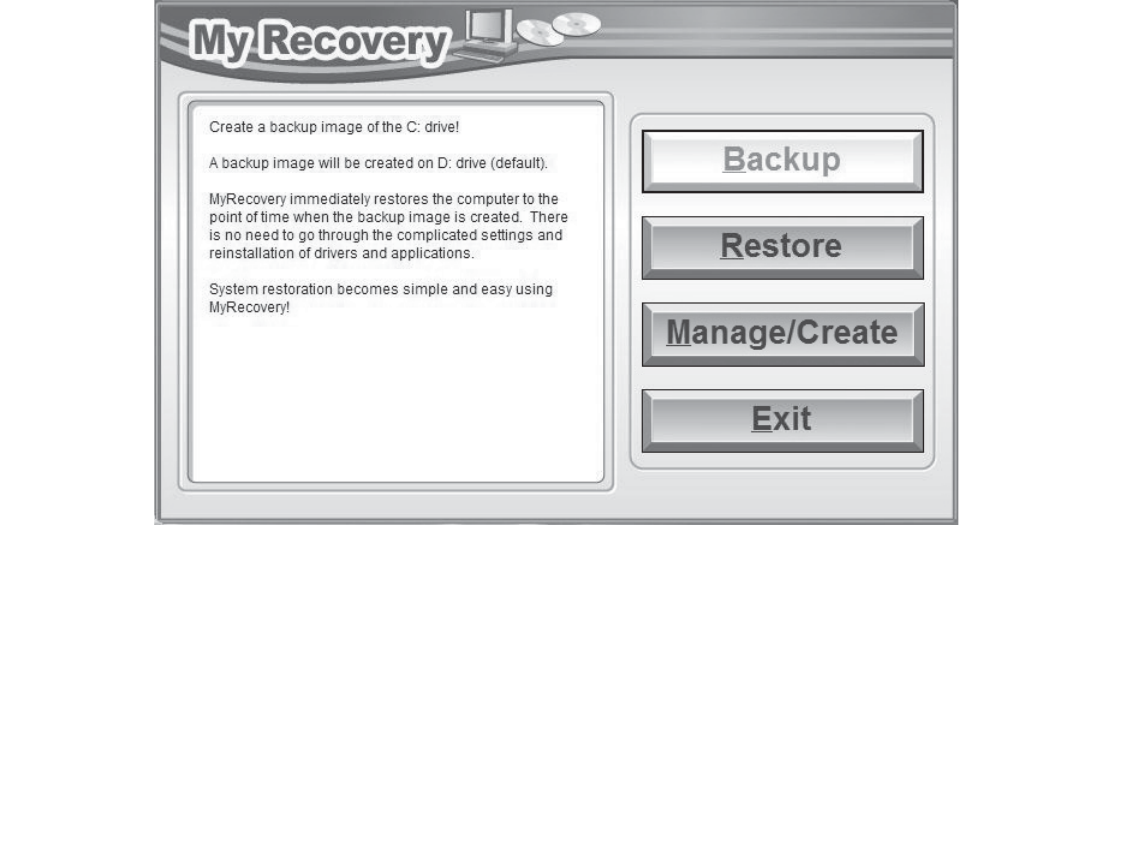
64
- Restoring Your System Image and Software
Figure 27. MyRecovery screen
4Click the [Next] button and the system will reboot.
5After rebooting, the “Creating of the backup image” window appears, in which you can either click [Create the
image on D drive] or [Select the drive] if you want to save to an external hard disk drive. (Note that the [Create
the image on D drive may not be available on all configurations.)
6An image appears showing you graphically how the image will be stored. Click the [Next] button.
7Click [Execute] to start the backup.

65
- Restoring Your System Image and Software
Managing Your Backup Images
With the MyRecovery tool you can also make copies of backup images, archive them on DVD, or delete them from
your hard drive.
1To begin, click the [MyRecovery] icon on your desktop.
2Click the [Manage/Create] button in the MyRecovery window.
3When the MyRecovery Manager window appears, click [Manage Backup Images].
4In the next window, a list of your backup images appears. Below the list are three buttons allowing you to [Make
DVD], [Copy], or [Delete] your backup images.
5Select an image title from the list, then click the action button you would like to perform.
6Note that you need to have an external disk drive connected for the [Copy] button to be enabled. If you elect to
copy the image, you will be prompted to enter the destination. If you are ready to copy, click [OK] to proceed. A
progress screen appears while the backup copy is being made.
7Note that if you copy an image to an external hard drive, both the original and the copy will appear in the [Backup
Images] window with identical names, dates, and file sizes, but with the different drive letter to distinguish them.
Before you select [Make DVD], make sure you have a recordable DVD drive connected and blank DVDs available.
Using the Recovery and Utility Tools
The Recovery and Utility tools consist of a variety of tools that will help you recover your Factory Image, recover system
images, and delete the data from your hard disk.
Methods for accessing the utilities
Recovery and Utility Tools are preinstalled in a hidden partition by the factory, or they can be accessed by using the
bootable disc. Please note that you can delete Recovery and Utility tools from your hard disk drive if you modify the
partitions. In this case you will not be able to use the hidden partition for booting to Recovery and Utility Tools, but
you will still be able to boot from the Bootable Disc.

66
- Restoring Your System Image and Software
Determining whether Recovery and Utility is pre-loaded
1Turn on or reboot your system. When the Fujitsu logo appears, press [F12] key. The Boot Menu will appear.
2Press the Tab key to select Application menu.
3Check whether the <Recovery and Utility> option is present. If it is not present, it means that the utility must be
used from the disc. Proceed to “Running Recovery and Utility from the Bootable Disc” if <Recovery and Utility> is
unavailable.
Running Recovery and Utility from hard disk
1Turn on or reboot your system. When the Fujitsu logo appears, press [F12] key. The Boot Menu will appear.
2Press the Tab key to select Application menu.
3Cursor down to <Recovery and Utility> and press the [Enter] key.
4While the files are being loaded from the disc, a progress bar will appear at the bottom of the screen.
5When the System Recovery Options dialog opens, select a new keyboard layout, if necessary, then click [Next].
6When the Operating System dialog appears, select “Use recovery tools...”, then click [Next].
7If necessary, enter your password, then click [OK].
8When System Recovery Options window appears, click on Recovery and Utility.
9The Recovery and Utility screen appears on the screen with three tabs: Diagnostics, Recovery and Utility. Please
note that Diagnostics tab is not supported on certain LIFEBOOK/STYLISTIC models when running Recovery and
Utility from the hard disk. In order to restore the operating system, please use the middle icon “Restoring the
Factory Image (only C:\drive)” under the Recovery tab.
Running Recovery and Utility from the Bootable disc
To verify/change the boot-up priority (rather than booting-up from the hard drive or an external floppy disk drive),
perform the following steps:
1Power on your system. When the Fujitsu logo appears on the screen. press the [F12] key to get to the Boot Menu.
2Highlight the CD/DVD option.

67
- Restoring Your System Image and Software
3Insert the bootable disc into an externally connected DVD drive tray.
4Click [OK]. While the files are being loaded from the disc, a progress bar will appear at the bottom of the screen.
5When the System Recovery Options dialog opens, select a new keyboard layout, if necessary, then click [Next].
6When the Operating System dialog appears, click [Next].
7If necessary, enter your password, then click [OK].
8When System Recovery Options window appears, click on Recovery and Utility.
9When the Recovery and Utility screen appears, three tabs will be present: Diagnostics, Recovery, and Utility.
Recovery and Utility tabs
Diagnostics tab: The Diagnostics tool is designed for use by IT professionals. It is not likely you will need to use this
tool. When you select devices from the Diagnosis window then click [Execute], several tests are performed on the
selected components.
Recovery tab: The Recovery tab contains three tools: Recovering User-Configured System Backups, Restoring the
Factory Image (only C: drive), and Restoring the Factory Image (full hard drive recovery). You can use these tools to
restore the Factory Image from the hidden partition, restore backup image(s) created by you or images stored on DVD
discs, and perform a full hard drive recovery. Please refer to instructions above for details on how to create Factory
Image Recovery DVDs, user backup DVDs and system image backup.
Utility tab: The Utility tab contains three tools: Hard Disk Data Delete, Restore Recovery and Utility, and Windows
Complete PC Restore.
•The Hard Disk Data Delete utility is used to delete all data on the hard disk and prevent the data from being
reused. NOTE: Do not use the Hard Disk Data Delete utility unless you are absolutely certain that you want
to erase your entire hard disk, including all partitions.
•Restore Recovery and Utility allows you to restore the first hidden partition.
•Windows Complete PC Restore utility allows you to restore an image created with Windows Backup and
Restore Center. Complete PC Restore will overwrite the data on your hard disk drive.

68
- Restoring Your System Image and Software
Recovering your Factory Image using Recovery and Utility (for new hard drive or non-bootable hard drive)
If you have installed a new hard drive or your hard drive is not bootable, perform the following steps. Note that first
you will need to create new partitions on the hard drive, then restore the Factory Image:
1Power on your system. When the Fujitsu logo appears on the screen. press the [F12] key.
2Highlight the CD/DVD option.
3Insert the bootable disc in an externally connected DVD drive tray, then click [OK].
4When System Recovery Options window appears, click on <Recovery and Utility>.
5When the System Recovery Options dialog opens, select a new keyboard layout, if necessary, then click [Next].
6When the Operating System dialog appears, click [Next].
7If necessary, enter your password, then click [OK].
8When System Recovery Options window appears, click on Recovery and Utility.
9Click the Recovery tab in the Recovery and Utility window, then click
Restoring the Factory Image
icon.
10 Click [Execute].
11 Read the precautions, then select “I Agree”.
12 Click [Next], then click [Execute] to start the recovery process.
13 “1. Recovery Disc Check” will be in bold and the rest will be grayed out. Follow the instructions and “Insert the
Recovery Disc #1”. In some cases, you may prompted to “Insert the Recovery Disc #2”, depending upon the size of
the Recovery Image
14 Click [Next] to begin the check. Click [Next] again when the check is complete.
15 “2. Initializing hard disk drive” will be in bold with the message “Please insert the Bootable Disc into your optical
drive”. Insert the bootable disc. Click [Next] to proceed. A dialog box appears, with a checking disc message.
16 “Warning All DATA on the Hard Disk will be completely erased!!!” will appear. Select [OK]. The partition creation
process will begin.
17 “3. Restoring Factory Image to hidden partition” will be in bold with the message “Please insert the Recovery
Disk#1 into the optical drive”. Click [Next] to proceed.

69
- Restoring Your System Image and Software
After completion, the tool will automatically go back to "3.Restoring Factory Image to hidden partition" but will
include the note “Please insert your Third Party Applications Disc or CyberLink DVD, then click [OK]. After installation
of each disc, insert the next and continue until all have been installed. If you don't have your Third Party Applications
Disc and/or CyberLink DVD, or you have already inserted these discs, please click [Skip] to continue. NOTE: In some
cases (products without an optical drive) you will not have a CyberLink DVD".
At this point, you can either:
•Insert Application Disc(s) to restore back to hidden partition, or,
•Click [Skip] to skip restoring Application disc(s) and continue with restore.
18 If you select to insert Application Disc, after copying of application disc(s) to hidden partition is completed, the
message will appear again. Repeat inserting application disc(s) until all discs have been copied, then click [Skip]
to continue with Restore.
19 After clicking [Skip], a confirmation message will appear "If you want to skip copying or you have finished copying,
click [OK]. Click [Cancel] to go back to Restoring Factory Image to hidden partition.”
20 Click [OK] and Restoring Factory Image will begin.
21 When restoration is complete, you will see the message “Restoration has been completed. Click [OK] to reboot the
computer.” Click [OK].
Downloading Driver Updates
To ensure that you always have the most current driver updates related to your system, you should occasionally
access the Fujitsu Software Download Manager (FSDM) utility. The FSDM utility is available from the Fujitsu Support
site. FSDM will allow you to view a list of the most current drivers, utilities, and applications to determine whether
you have the latest versions. If you have a Windows 7 operating system, you will need to go to the Support Site to
download the FSDM Utility: http://support.fujitsupc.com/CS/Portal/support.do?srch=DOWNLOADS.

70
Chapter 5
Care and Maintenance
Caring for your Hybrid Tablet
If you use your STYLISTIC Hybrid Tablet carefully, you will increase its life and reliability. This section provides some tips
for looking after the Hybrid Tablet and its devices.
•Your STYLISTIC is a durable but sensitive electronic device. Treat it with respect and care.
•Make a habit of transporting it in a suitable carrying case.
•Do not attempt to service the computer yourself. Always follow installation instructions closely.
•Keep it away from food and beverages.
THE SYSTEM CONTAINS COMPONENTS THAT CAN BE SEVERELY DAMAGED BY ELECTROSTATIC DISCHARGE (ESD). TO MINIMIZE RISK TO THE
COMPONENTS, OBSERVE THE FOLLOWING PRECAUTIONS:
•IF YOU DROP YOUR HYBRID TABLET OR DAMAGE THE HOUSING IN ANY WAY, IMMEDIATELY TURN OFF POWER AND DISCONNECT THE POWER PLUG.
FAILURE TO DO SO COULD RESULT IN A SHORT CIRCUIT, SMOKE, AND/OR FIRE. CONTACT FUJITSU SERVICE AND SUPPORT BY PHONE AT 1-800-
8FUJITSU (1-800-838-5487), BY EMAIL AT 8FUJITSU@US.FUJITSU.COM, OR THROUGH THE WEBSITE AT
HTTP://WWW.COMPUTERS.US.FUJITSU.COM/SUPPORT TO LEARN HOW TO GET THE SYSTEM REPAIRED.
•BEFORE DOCKING OR UNDOCKING YOUR HYBRID TABLET (WHEN USING A DOCKING CRADLE), IT IS GOOD PRACTICE TO TOUCH A GROUNDED METAL
OBJECT TO DISCHARGE STATIC ELECTRICITY IN YOUR BODY.
•ELECTRICAL EQUIPMENT MAY BE HAZARDOUS IF MISUSED. OPERATIONS OF THIS PRODUCT OR SIMILAR PRODUCTS, MUST ALWAYS BE SUPERVISED BY AN
ADULT. DO NOT ALLOW CHILDREN ACCESS TO THE INTERIOR OF ANY ELECTRICAL PRODUCTS AND DO NOT PERMIT THEM TO HANDLE ANY CABLES.

71
- Caring for your Hybrid Tablet
•If you accidentally spill liquid on your STYLISTIC Hybrid Tablet:
1Turn it off.
2Position it so that the liquid can run out and let it dry out for 24 hours, or longer if needed.
3If your Hybrid Tablet will not boot after it has dried out, call your support representative.
•Do not use your Hybrid Tablet in a wet environment (near a bathtub, swimming pool).
•Always use the AC adapter and batteries that are approved for your Hybrid Tablet.
•Avoid exposure to sand, dust and other environmental hazards.
•Do not expose your Hybrid Tablet to direct sunlight for long periods of time as temperatures above 140° F (60°
C) may damage your Hybrid Tablet.
•Do not put heavy or sharp objects on the computer.
Cleaning your Hybrid Tablet
•Always disconnect the power plug. (Pull the plug, not the cord.)
•Clean your STYLISTIC Hybrid Tablet with a damp, lint-free cloth. Do not use abrasives or solvents.
•Use a soft cloth to remove dust from the screen. Never use glass cleaners.
•Always shut down the computer, unplug the power adapter, and remove the battery when cleaning or
disinfecting the computer exterior or LCD display.
Cleaning guidelines using recommended off-the-shelf cleaners
Computer exterior. To clean the exterior, use one of the following off-the-shelf products:
•Office Depot® #154-616 b Cleaning Kit
•Meridrew Enterprises Klear Screen® Wipes
•3M CL563 Cleaner Wipes
Note: After cleaning with one of these products, gently polish with a dry, soft, lint-free cloth until the solution is no
longer visible.
Disinfecting STYLISTIC computers
Wipe the surface with a soft cloth wipe and a 50% ethanol solution or use another ethanol-based germicide which
has been registered as a hospital disinfectant by the EPA.

72
- Caring for your Hybrid Tablet
Storing your Hybrid Tablet
•If storing your Hybrid Tablet for a month or longer, turn it off, fully charge the battery, then remove and store
all Lithium Polymer batteries.
•Store your Fujitsu STYLISTIC in a cool, dry location. Temperatures should remain between 13ºF (-25ºC) and
140ºF (60ºC).
•Store your tablet and batteries separately. If you store your system with a battery installed, the battery will
discharge, and battery life will be reduced. In addition, a faulty battery might damage your system.
Traveling with your Hybrid Tablet
•Do not transport your Hybrid Tablet while it is turned on.
•You should carry your tablet with you while traveling, rather than checking it in as baggage.
•Never put your tablet through a metal detector; have it hand-inspected by security personnel. You can however,
put your tablet through a properly tuned X-ray machine. To avoid problems, place it close to the entrance of the
machine and remove it as soon as possible or have it hand-inspected by security personnel. Security officials
may require you to turn your system on, so make sure you have a charged battery on hand.
•USE OF INCORRECT CLEANERS CAN RESULT IN OPTICAL IMPAIRMENT OF THE LCD AND/OR DAMAGE TO THE COMPUTER. ALWAYS REFER TO THE
CLEANER MANUFACTURER'S GUIDELINES AND MATERIAL SAFETY DATA SHEETS FOR PROPER HANDLING AND USE OF THE PRODUCTS.
•NEVER USE AMMONIA, ACIDIC, OR ALKALINE CLEANERS OR ORGANIC CHEMICALS SUCH AS PAINT THINNER, ACETONE, PROPYL OR ISOPROPYL
ALCOHOL, OR KEROSENE. IT MAY DAMAGE SURFACE FINISHES AND THE COATING OF THE LCD SCREEN.
•NEVER USE COMPRESSED AIR FOR CLEANING YOUR COMPUTER.
•ALWAYS POWER OFF THE COMPUTER BEFORE TRANSPORTING AND/OR PACKAGING IT. AFTER SHUTTING DOWN THE SYSTEM, WAIT UNTIL THE STATUS
LED PANEL INDICATES POWER OFF CONDITION (I.E., NO LIGHTS ARE ILLUMINATED).
•IT IS POSSIBLE THAT THE UNIT MAY NOT AUTOMATICALLY GO TO POWER OFF OR HIBERNATE MODE WHEN YOU CLOSE THE LID. THIS SITUATION MAY
OCCUR DUE TO PRE-OS BOOT PASSWORD SECURITY SETTINGS OR SOME OTHER APPLICATION RUNNING ON THE COMPUTER.
•ATTEMPTING TO TRANSPORT THE COMPUTER WHILE POWER IS ON MAY DAMAGE THE HYBRID TABLET DUE TO SHOCK OR OVERHEATING.
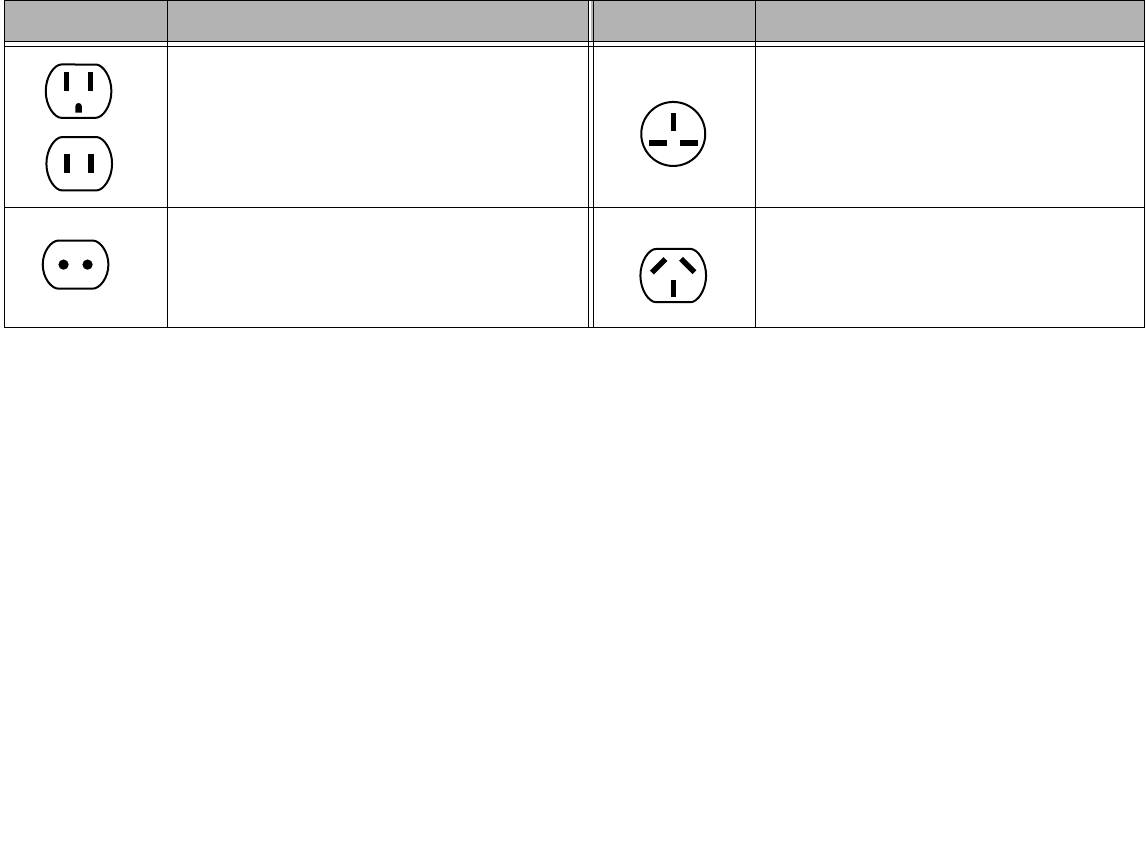
73
- Caring for your Hybrid Tablet
•Take the necessary plug adapters if you're traveling overseas. Check the following diagram to determine which
plug adapter you'll need or ask your travel agent.
Batteries
Caring for your Battery
•Always handle batteries carefully.
•Do not short-circuit the battery terminals (that is, do not touch both terminals with a metal object). Do not
carry lose batteries in a pocket or purse where they may mix with coins, keys, or other metal objects. Doing so
may cause an explosion or fire.
•Do not drop, puncture, disassemble, mutilate or incinerate the battery.
•Recharge batteries only as described in this manual and only in ventilated areas.
•Do not leave batteries in hot locations for more than a day or two. Intense heat can shorten the life of your
battery.
•Do not leave a battery in storage for longer than 6 months without recharging it.
Increasing Battery Life
•Power your Hybrid Tablet through the AC or optional auto/airline adapter whenever possible.
•If your tablet runs on battery power all day, connect it to an AC adapter overnight to recharge it.
Outlet Type Location Outlet Type Location
United States, Canada, parts of Latin
America, Mexico, Japan, Korea,
the Philippines, Taiwan
United Kingdom, Ireland, Malaysia,
Singapore, parts of Africa
Russia and the Commonwealth of Independent
States (CIS), most of Europe, parts of Latin America,
the Middle East, parts of Africa, Hong Kong, India,
most of South Asia
China, Australia, New Zealand

74
- Caring for your Hybrid Tablet
•Keep brightness to the lowest level comfortable.
•Set the power management for maximum battery life.
•Put your Hybrid Tablet in Sleep mode when it is turned on and you are not actually using it.
•Limit your media drive access.
•Disable the Media Player auto insert notification function.
Media Care
Caring for your Media (when optional external optical drive is installed)
Media discs are precision devices and will function reliably if given reasonable care.
•Always store your media disc in its case when it is not in use.
•Always handle discs by the edges and avoid touching the surface.
•Avoid storing any media discs in extreme temperatures.
•Do not bend or scratch media discs or set heavy objects on them.
•Do not spill liquids or get dust on media discs.
•Never write on the label surface with a ballpoint pen or pencil. Always use a felt pen.
•If a disc is dirty, use only a DVD/CD cleaner or wipe it with a clean, soft, lint free cloth starting from the inner
edge and wiping to the outer edge.
•If a disc is subjected to a sudden change in temperature, condensation may form on the surface. Wipe moisture
off with a soft, lint free cloth and let it dry at room temperature. DO NOT use a hair dryer or heater to dry media
discs.
Caring for an Optional Optical Drive
An optional optical drive is durable but you must treat it with care. Please pay attention to the following points:
•The drive rotates the compact disc at a very high speed. Do not carry it around or subject it to shock
or vibration with the power on.
•Avoid using or storing the drive where it will be exposed to extreme temperatures.
•Avoid using or storing the drive where it is damp or dusty.
•Avoid using or storing the drive near magnets or devices that generate strong magnetic fields.
•Avoid using or storing the drive where it will be subjected to shock or vibration.

75
- Caring for your Hybrid Tablet
•Do not disassemble or dismantle the optical drive.
•Use of a commercially available lens cleaner is recommended for maintenance of your drive.
Secure Digital Cards
Caring for your Cards
Secure Digital Cards are durable, but you must treat them with care. The documentation supplied with your card will
provide specific information, but you should pay attention to the following points:
•To keep out dust and dirt, store cards in their protective sleeves when they are not installed.
•Avoid prolonged exposure to direct sunlight or excessive heat.
•Keep the cards dry.
•Do not flex or bend the cards, and do not place heavy objects on top of them.
•Do not force cards into the slot.
•Avoid dropping cards, or subjecting them to excessive vibration.

76
Chapter 6
System Specifications
Specifications
This section provides the hardware and environmental specifications for your Fujitsu STYLISTIC Hybrid Tablet.
Specifications of particular configurations will vary.
Microprocessor
Intel® 3rd Generation Core processors (1.8 GHz)
Chipset
•Intel QM77 or HM76, depending upon processor
Memory
System Memory
•DDR3-1600 MHz SDRAM memory module.
•2GB or 4GB of total memory (onboard) (4GB maximum)
Cache Memory
3MB L3 cache

77
- Specifications
Video
Video Color and Resolution
Anti-glare 11.6" HD IPS display
•Internal: 1366x768 pixel resolution, 16M colors
•External (HDMI from system: 1920x1200 pixel resolution, 16M colors
•External: (VGA from optional keyboard dock): 1920 x1200, 16M colors
•160° vertical and horizontal viewing angles (80/80/80/80)
Digitizer
N-trig® DuoSense® technology. Dual Digitizer, consisting of active digitizer and capacitive touch panel (uses active
stylus input and up to four finger touch input).
Video RAM
Shared Intel® HD Graphics 4000 controller. Uses Unified Memory Architecture (UMA) built onto motherboard which
shares part of main memory for video memory. The amount of shared video memory is determined by the amount
of system memory.
Audio
•Realtek codec ALC269
•Headphones: Stereo headphone jack, 3.5 mm, 1 Vrms or less, minimum impedance 32 Ohms
•One built-in speaker, 18 mm diameter
•Hard button volume control
•Two built-in dual analog microphones

78
- Specifications
Mass Storage Device Options
Hard Drive Options
•Solid State Drive, mSATA/600 (6.0Gbps), 64 GB, with TRIM command support
•Solid State Drive, mSATA/600 (6.0Gbps), 128 GB, with TRIM command support
•Solid State Drive, mSATA/600 (6.0Gbps), 256 GB, with TRIM command support
Communications
•WLAN: Optional Integrated Intel Centrino Advanced-N 6205 (802.11abgn 2x2), or,
Atheros XSPAN HB116 802.11abgn
•Bluetooth: Broadcom BCM20702 Bluetooth USB 4.0 device for wireless personal area network communication
•WWAN: Optional integrated 3G Wireless Wide Area Network, Gobi3000 (Sierra Wireless AirPrime™ MC8355)
Security Features
Trusted Platform Module
The STYLISTIC Q702 Hybrid Tablet may have an optional Trusted Platform Module (TPM) installed for added system
security.
Fingerprint Recognition Sensor
Swipe sensor for biometric security.
Device Ports
On the STYLISTIC Hybrid Tablet:
•SD Card slot
•One USB 2.0 (Universal Serial Bus) connector for input/output devices
•Two USB 3.0 (Universal Serial Bus) connectors for input/output devices
•One DC In connector
•One HDMI connector
•Docking port (100-pin, to dock with optional STYLISTIC Docking Cradle)

79
- Specifications
•One stereo headphone out/line out jack
•One stereo microphone in/line in jack
•1920x1080 pixel FHD rear-facing web camera, 1280x720 pixel HD front-facing web camera
On the Optional STYLISTIC Keyboard Docking Station
•Two USB 2.0 connectors for input/output devices
•One DC-in connector
•One LAN (RJ-45) connector
•One VGA out connector
•One docking connector (80-pin, to dock with tablet)
Power
Battery Options
•Lithium Polymer Battery, 3 cells, 10.6V, 34Wh
•Optional Lithium Polymer Keyboard Dock/Slice Battery, 4-cell, 14.4V, 45 Wh
AC Adapter
Autosensing 100-240V AC, supplying 19V DC, 60W to the Hybrid Tablet; includes an AC cable
Power Management
Conforms to ACPI (Advanced Configuration and Power Interface).
Dimensions and Weight
Overall Dimensions
Tablet only: 11.89" (w) x 7.68" (d) x 0.50" (h) (302 x 195 x 12.7 mm)
Tablet with optional keyboard dock: 11.89" (w) x 7.99" (d) x 1.07" (h) (302 x 203 x 27.1 mm)

80
- Specifications
Weight
Tablet only: Approximately 1.87 lb. (.85 kg)
Tablet with optional keyboard dock: Approximately 3.86 lb. (1.75 kg)
Environmental Requirements
Temperature
Operating: 41° to 95° F (5° to 35° C). Non-operating: 5° to 140° F (–15° to 60° C)
Humidity
Operating: 20% to 85%, relative, non-condensing. Non-operating: 8% to 85%, relative, non-condensing
Altitude
Operating: 10,000 feet (3,048 m) maximum
Popular Accessories
For ordering or additional information on Fujitsu accessories please visit our Web site at
www.shopfujitsu.com or call 1-800-FUJITSU.
Included Software
Depending on your pre-installed operating system, your Hybrid Tablet comes with software for playing audio and
video files of various formats. In addition there is virus protection software and Power Management software. The
following list indicates the software included with your system.
•Adobe® Reader
•OmniPass® Fingerprint application
•Google Toolbar
•CyberLink YouCam
•Norton Internet Security 2012
•Microsoft Windows Live Essentials

81
- Specifications
Learning About Your Software
Tutorials
All operating systems and most application software have tutorials built into them upon installation. We highly
recommend that you step through the tutorial before you use an application.
Manuals
Included with your Hybrid Tablet you will find manuals for your installed operating system and other pre-installed
software. Any manuals that are not included, are available online through the help system of the software. We
recommend that you review these manuals for general information on the use of these applications.
Adobe Reader
The Adobe Reader allows you to view, navigate, and print PDF files from across all of the major computing platforms.
OmniPass® Fingerprint application
The fingerprint sensor uses Softex OmniPass which provides password management capabilities to Microsoft
Windows operating systems. OmniPass lets you use a "master password" for all Windows, applications, and on-line
passwords, and presents a convenient user interface through which you can securely manage passwords, users, and
multiple identities for each user.
Google Toolbar
Google Toolbar lets you to search the Internet quickly, block pop-ups, and perform a variety of other tasks to make
your Internet experience easier and more pleasant.
Norton Internet Security 2012
Your system is preinstalled with a free 60-day trial version of Symantec’s Norton Internet Security™ 2012. Internet
Security is a suite of tools designed to protect your STYLISTIC from viruses, hackers, spam, and spyware. It helps
you protect data currently on your hard disk from destruction or contamination. The trial version is activated upon
your acceptance of software license agreement. After 60 days, you will need to purchase a subscription from
Symantec to download latest virus, spyware, and spam definitions.

82
- Specifications
CyberLink YouCam
CyberLink YouCam allows you to capture photos or movies on the embedded webcam, add special effects to them,
and share them in a variety of formats or via social networks.

83
- Specifications
Microsoft Windows Live Essentials
Windows Live Essentials is a suite of programs that make it easier and more enjoyable to use your STYLISTIC. Live
Essentials consists of 6 applications: Messenger, Photo Gallery, Writer, Mail, Movie Maker, and Silverlight. Messenger
lets you quickly communicate and interact with individuals and groups. Photo Gallery is a flexible application that
lets you organize, edit, and share your photos. Writer can be used to generate blog entries, upload videos and
photos to your blogs, and publish your entries online. Mail makes it easy for you to manage your email accounts.
Movie Maker makes great-looking movies and slideshows from your videos and photos. It’s simple to import
standard or high definition video and photos, and then have AutoMovie add animations, music, and a title in
minutes. Silverlight powers rich application experiences and delivers high quality, interactive video across the Web
and mobile devices.
Operating System
The following operating system configuration is installed on your system:
Microsoft Windows 7 Professional Edition

84
- Regulatory Information
Regulatory Information
Notice
Changes or modifications not expressly approved by Fujitsu could void this user’s authority to operate the equipment.
FCC NOTICES
Notice to Users of Radios and Television
This equipment has been tested and found to comply with the limit for class B digital devices, pursuant to parts 15 of the FCC Rules.
These limits are designed to provide reasonable protection against harmful interference in a residential installation. This equipment
generates, uses, and can radiate radio frequency energy and, if not installed and used in accordance with the instructions, may cause harmful
interference to radio communications. However, there is no guarantee that interference will not occur in a particular installation. If this
equipment does cause harmful interference to radio or television reception, which can be determined by turning the equipment off and on,
the user is encouraged to try to correct the interference by one or more of the following measures:
•Reorient or relocate the receiving antenna.
•Increase the separation between the equipment and receiver.
•Connect the equipment into an outlet that is on a different circuit than the receiver.
•Consult the dealer or an experienced radio/TV technician for help.
Shielded interconnect cables must be employed with this equipment to ensure compliance with the pertinent RF emission limits governing
this device.
DOC (INDUSTRY CANADA) NOTICES
Notice to Users of Radios and Television
This Class B digital apparatus meets all requirements of Canadian Interference-Causing Equipment Regulations.
CET appareil numérique de la class B respecte toutes les exigence du Réglement sur le matérial brouilleur du Canada.

85
Appendix A: WLAN User’s Guide
FCC Regulatory Information
Please note the following regulatory information related to the optional wireless LAN device.
Regulatory Notes and Statements
Wireless LAN, Health and Authorization for use
Radio frequency electromagnetic energy is emitted from Wireless LAN devices. The energy levels of these emissions, however, are far much
less than the electromagnetic energy emissions from wireless devices such as mobile phones. Wireless LAN devices are safe for use by
consumers because they operate within the guidelines found in radio frequency safety standards and recommendations. The use of Wireless
LAN devices may be restricted in some situations or environments, such as:
•On board an airplane, or
•In an explosive environment, or
•In situations where the interference risk to other devices or services is perceived or identified as harmful.
In cases in which the policy regarding use of Wireless LAN devices in specific environments is not clear (e.g., airports, hospitals,
chemical/oil/gas industrial plants, private buildings), obtain authorization to use these devices prior to operating the equipment.

86
-
Regulatory Information/Disclaimers
Installation and use of this Wireless LAN device must be in strict accordance with the instructions included in the user documentation
provided with the product. Any changes or modifications made to this device that are not expressly approved by the manufacturer may void
the user’s authority to operate the equipment. The manufacturer is not responsible for any radio or television interference caused by
unauthorized modification of this device, or the substitution or attachment of connecting cables and equipment other than those specified
by the manufacturer. It is the responsibility of the user to correct any interference caused by such unauthorized modification, substitution or
attachment. The manufacturer and its authorized resellers or distributors will assume no liability for any damage or violation of government
regulations arising from failure to comply with these guidelines.
This device must not be co-located or operated in conjunction with any other antenna or transmitter.
For IEEE 802.11a Wireless LAN: For operation within 5.15~5.25 GHz frequency range, it is restricted to indoor environments, and the
antenna of this device must be integral.
Federal Communications Commission statement
This device complies with Part 15 of FCC Rules.
Operation is subject to the following two conditions: (1) This device may not cause interference, and, (2) This device must accept any
interference, including interference that may cause undesired operation of this device.
FCC Interference Statement
This equipment has been tested and found to comply with the limits for a Class B digital device, pursuant to Part 15 of the FCC Rules. These
limits are designed to provide reasonable protection against harmful interference in a residential installation. This equipment generates,
uses, and can radiate radio frequency energy. If not installed and used in accordance with the instructions, it may cause harmful interference
to radio communications. However, there is no guarantee that interference will not occur in a particular installation.
If this equipment does cause harmful interference to radio or television reception, which can be determined by turning the equipment off
and on, the user is encouraged to try and correct the interference by one or more of the following measures:
1Reorient or relocate the receiving antenna.
2Increase the distance between the equipment and the receiver.
3Connect the equipment to an outlet on a circuit different from the one the receiver is connected to.
4Consult the dealer or an experienced radio/TV technician for help.
Figure A-1. Ad Hoc Mode Network

87
-
FCC Radio Frequency Exposure statement
The available scientific evidence does not show that any health problems are associated with using low power wireless devices. There is no
proof, however, that these low power wireless devices are absolutely safe. Low power wireless devices emit low levels of radio frequency
energy (RF) in the microwave range while being used. Whereas high levels of RF can produce health effects (by heating tissue), exposure to
low-level RF that does not produce heating effects causes no known adverse health effects. Many studies of low-level RF exposure have not
found any biological effects. Some studies have suggested that some biological effects might occur, but such findings have not been
confirmed by additional research.
The wireless LAN radio device has been tested and found to comply with FCC radiation exposure limits set forth for an uncontrolled equipment
and meets the FCC radio frequency (RF) Exposure Guidelines in Supplement C to OET65.
Export restrictions
This product or software contains encryption code which may not be exported or transferred from the US or Canada without an approved US
Department of Commerce export license. This device complies with Part 15 of FCC Rules., as well as ICES 003 B / NMB 003 B. Operation is
subject to the following two conditions: (1) this device may not cause harmful interference, and (2) this device must accept any interference
received, including interference that may cause undesirable operation. Modifications not expressly authorized by Fujitsu America, Inc. may
invalidate the user's right to operate this equipment.
Canadian Notice
The device for the 5150 - 5250 MHz band is only for indoor usage to reduce the potential for harmful interference to co-channel mobile
satellite systems.
The maximum antenna gain of 6 dBi permitted (for devices in the 5250 - 5350 MHz, 5470 - 5725 MHz and 5725 - 5825 MHz bands) to comply
with the e.i.r.p. limit as stated in A9.2 of RSS210.
In addition, users are cautioned to take note that high power radars are allocated as primary users (meaning they have priority) of 5250 -
5350 MHz and 5650 - 5850 MHz and these radars could cause interference and/or damage to LE-LAN devices.

88
- Before Using the Optional Wireless LAN
Before Using the Optional Wireless LAN
This manual describes the procedures required to properly set up and configure the optional integrated Wireless LAN
USB device (referred to as "WLAN device" in the rest of the manual). Before using the WLAN device, read this manual
carefully to ensure its correct operation. Keep this manual in a safe place for future reference.
Wireless LAN Device Covered by this Document
This document is applicable to systems containing one of the following optional devices:
•Integrated Intel Centrino Advanced-N 6205 (802.11a/b/g/n)
•Atheros XSPAN 802.11abgn
Characteristics of the WLAN Device
•The WLAN device is a USB module attached to the main board of the mobile computer.
•The WLAN device operates in license-free RF bands, eliminating the need to procure an FCC operating license.
The WLAN operates in the 2.4GHz Industrial, Scientific, and Medical (ISM) RF band and the lower, middle, and
upper bands of the 5GHz Unlicensed National Information Infrastructure (UNII) bands.
•The WLAN devices are capable of four operating modes, IEEE802.11a, IEEE802.11b, IEEE802.11g, and
IEEE802.11n
•The WLAN devices are Wi-Fi certified and operate (as applicable) at a the maximum data rate of 150 Mbps
(theoretical) in IEEE802.11n mode; 54 Mbps in IEEE802.11a or IEEE802.11g mode; and 11 Mbps in
IEEE802.11b mode.
•The WLAN devices support the following encryption methods - WEP, TKIP, CKIP, and AES encryption.
•The Wireless LAN devices are compliant with the following standards: WPA, WPA2, CCX1.0, CCX2.0, CCX3.0,
CCX4.0, and CCX5.0.
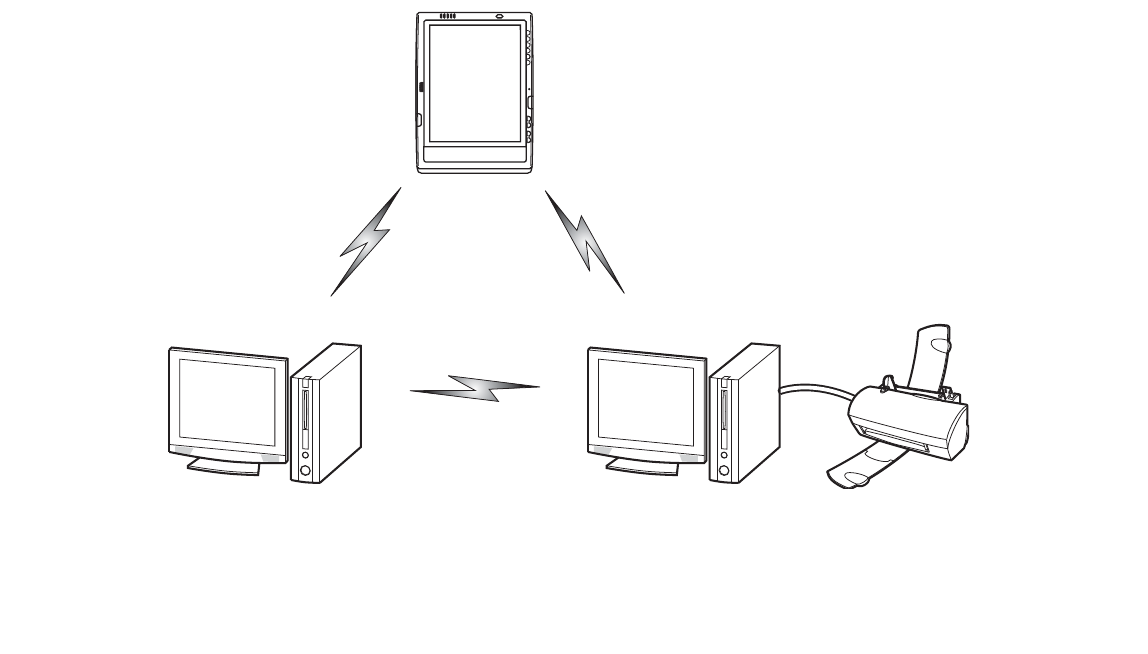
89
- Before Using the Optional Wireless LAN
Wireless LAN Modes Using this Device
Ad Hoc Mode
"Ad Hoc Mode" refers to a wireless network architecture where wireless network connectivity between multiple
computers is established without a central wireless network device, typically known as Access Point(s). Connectivity
is accomplished using only client devices in a peer-to-peer fashion. That is why Ad Hoc networks are also known as
peer-to-peer networks. Ad Hoc networks are an easy and inexpensive method for establishing network connectivity
between multiple computers. Ad Hoc mode requires that the SSID, network authentication, and encryption key
settings are identically configured on all computers in the Ad Hoc network.
Figure 28. Ad Hoc Mode Network
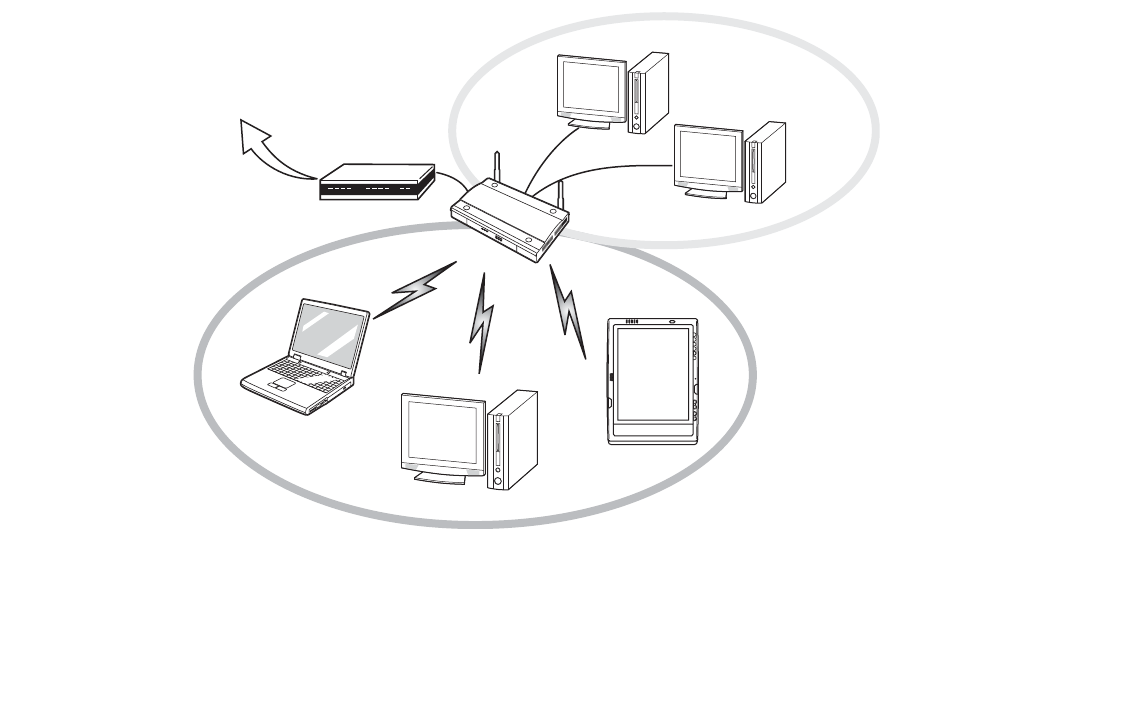
90
- Before Using the Optional Wireless LAN
Access Point (Infrastructure) Mode
Infrastructure mode refers to a wireless network architecture in which devices communicate with wireless or wired
network devices by communicating through an Access Point. In infrastructure mode, wireless devices can
communicate with each other or with a wired network. Corporate wireless networks operate in infrastructure mode
because they require access to the WLAN in order to access services, devices, and computers (e.g., file servers,
printers, databases).
Figure 29. Access Point (Infrastructure) Mode Network
ADSL modem,
cable modem,
or similar
Internet Wired LAN
Access Point*
Wireless LAN *An optional hub for a wired
LAN may be required depending
upon the type of access point used.

91
- Before Using the Optional Wireless LAN
How to Handle This Device
The WLAN device is an optional device that may come pre-installed in your mobile computer. Under normal
circumstances, it should not be necessary for you to remove or re-install it. The operating system that your mobile
computer comes with has been pre-configured to support the WLAN device.
•The Wireless LAN devices support IEEE802.11a, IEEE802.11b, IEEE802.11g, and IEEE802.11n.
•The WLAN devices operate in the 2.4 GHz ISM band and the 5 GHz lower, middle, and upper UNII bands.
•Microwave ovens may interfere with the operation of WLAN devices since they operate in the same 2.4 GHz
frequency range as IEEE802.11b/g/n devices. Interference by microwaves does not occur with IEEE802.11a
radio which operates in the 5 GHz RF band.
•Wireless devices that transmit in the 2.4 GHz range may interfere with operation of WLAN devices in
IEEE802.11b/g/n modes. Symptoms of interference include reduced throughput, intermittent disconnects, and
many frame errors. It is HIGHLY recommended that these interfering devices be powered off to ensure proper
operation of the WLAN device.
Deactivating/Disconnecting the WLAN Device
Disconnecting the WLAN device may be desired in certain circumstances (to extend battery life) or where certain
environments require it (i.e. hospitals, clinics, airplanes, etc.). The WLAN device can be deactivated by using the
Wireless On/Off Switch, and it can be disconnected in Windows using the WLAN icon in the system tray (Note that
disconnecting via the icon in the system tray does not turn off the radio; it continues to transmit and receive even
though it’s not connected.).
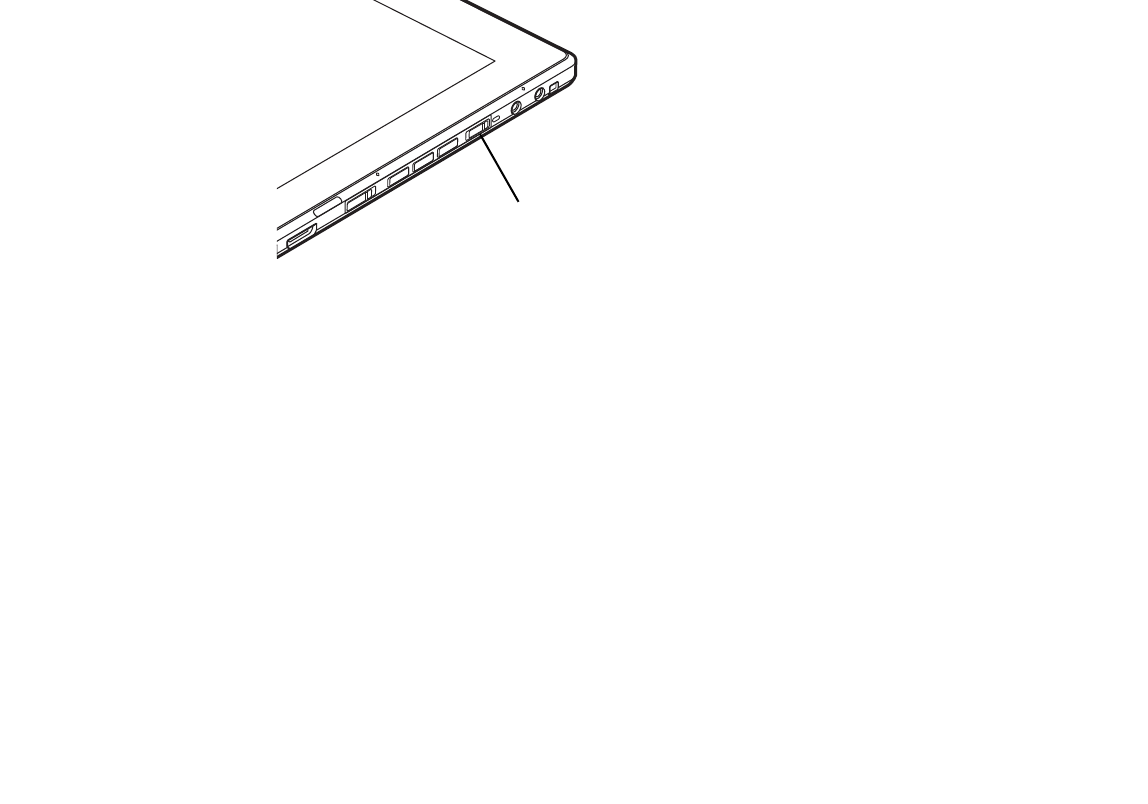
92
- Before Using the Optional Wireless LAN
Deactivation Using the Wireless On/Off Switch
The WLAN device can be deactivated quickly and efficiently by toggling the Wireless Device On/Off Switch to the Off
position.
The switch has no effect on non-Wireless LAN models.
Figure 30. Wireless LAN/Bluetooth On/Off Switch Location
Disconnection Using the Icon in the Taskbar
Note that disconnecting via the icon in the system tray does not turn off the radio; it continues to transmit and receive
even though it’s not connected.
1Right-click the WLAN icon in the taskbar at the bottom right of your screen.
2Choose Disconnect from a network.
Activating the WLAN Device
Activation of the WLAN device can be accomplished using the same methods as the deactivation process
•Using the Wireless On/Off Switch
•In Windows, by right-clicking the WLAN icon then clicking “Connect to a network”
Wireless Device Switch

93
- Configuring the Wireless LAN
Configuring the Wireless LAN
The WLAN device can be configured to establish wireless network connectivity using the software that is built into
Windows. Support for most industry standard security solutions is contained in this software.
Pre-defined parameters will be required for this procedure. Ask your network administrator for these parameters:
Configuring the WLAN
1Click the Start button, then select Control Panel.
2If the Control Panel is not in Classic View, select Classic View from the left panel. Double-click the Network
Connections icon.
3Double-click on the Wireless Network Connection icon.
4Click on [View Wireless Networks]
5Choose a wireless network.
6Click [Connect].
7Enter the Network Key, if required.
8Enter any required information. It may be necessary to consult with your network administrator for some of the
information.
9If you require assistance, go to [Start] -> Help and Support -> Networking and the Web. Select the main topic in
which you are interested, then type in relevant keywords in the Search box.
Connection to the network
After you have configured your computer, you can connect to an active network by performing the following steps:
1Click on the WLAN icon in the system tray.
2Select “Connect to a network”.
3Select a network from the list that appears, and click the [Connect] button.
After you have configured your computer, you can connect to an active network by clicking on the Wireless Network
icon in the system tray:

94
- Troubleshooting the WLAN
Troubleshooting the WLAN
Troubleshooting
Causes and countermeasures for troubles you may encounter while using your wireless LAN are described in the
following table. If you are unfamiliar with the steps required, consult your System Administrator or go to [Start] ->
Help and Support -> Networking and the Web
Problem Possible Cause Possible Solution
Unavailable
network
connection
Incorrect network
name (SSID) or
network key
Ad hoc connection: verify that the network names (SSID’s) and network keys (WEP) of all computers to
be connected have been configured correctly. SSID’s and WEP key values must be identical on each
machine.
Access Point (Infrastructure) connection: set network name (SSID) and network key to the same
values as those of the access point.
Set the Network Authentication value identically to that of the Access Point. Please consult your
network administrator for this value, if necessary.
Weak received signal
strength and/or link
quality
Ad hoc connection: Retry connection after shortening the distance to the destination computer or
removing any obstacles for better sight.
Access Point (Infrastructure) connection: Retry connection after shortening the distance to the access
point or removing any obstacles for better transmission.
The WLAN device has
been deactivated or
disabled
Check if the wireless switch is turned On. Go to Start -> Control Panel, and double-click on Windows
Mobility Center. If the wireless network is off, click the [Turn wireless on] button.
The computer to be
connected is turned
off
Check if the computer to be connected is turned ON.

95
- Troubleshooting the WLAN
Unavailable
network
connection
(continued)
RF interference from
Access Points or other
wireless networks
The use of identical or overlapping RF channels can cause interference with the operation of the WLAN
device. Change the channel of your Access Point to a channel that does not overlap with the interfering
device.
Wireless network
authentication has
failed
Re-check your Network Authentication, Encryption, and Security settings. Incorrectly configured security
settings such as an incorrectly typed WEP key, a misconfigured LEAP username, or an incorrectly chosen
authentication method will cause the LAN device to associate but not authenticate to the wireless
network.
Incorrectly configured
network settings
Recheck the configuration of your network settings.
Incorrect IP address
configuration
This only applies to networks using static IP addresses. Please contact your network administrator for
the correct settings.
Problem Possible Cause Possible Solution

96
- WLAN Specifications
WLAN Specifications
Specifications
* “Wi-Fi based” indicates that the interconnectivity test of the organization which guarantees the interconnectivity of wireless LAN (Wi-Fi
Alliance) has been passed.
** The communication ranges shown above will increase or decrease depending on factors such as number of walls, reflective material, or
interference from external RF sources.
*** Encryption with network key (WEP) is performed using the above number of bits, however, users can set 40 bits/ 104 bits after
subtracting the fixed length of 24 bits.
**** Depending on practical environments, the allowable number of computers to be connected may be decreased.
Item Specification
Type of network The integrated Intel Centrino Advanced-N 6205 (802.11abgn 2x2) and Atheros XSPAN 802.11a/b/g/n WLAN
devices conform to IEEE 802.11a, 802.11b/g, and 802.11n, Wi-Fi based*.
Transfer rate (Automatic switching) 150 Mbps maximum data rate
Active frequency •802.11n: 2.4 GHz or 5 GHz
•802.11b/g: 2400~2473 MHz
•802.11a: 4900 ~ 5850 MHz
Typical operating distances** •802.11a: 40 ft. (12 m) @ 54 Mbps; 300 ft. (91 m) @ 6 Mbps
•802.11b: 100 ft. (30 m) @ 11 Mbps; 300 ft. (91 m) @ 1 Mbps
•802.11g: 100 ft. (30 m) @ 54 Mbps; 300 ft. (91 m) @ 1 Mbps
•802.11n: Estimated double the operating distance of 802.11g and 802.11a in their respective frequencies.
Number of channels •802.11a: 8 independent channels
•802.11b/g: 11 channels, 3 non-overlapping channels
•802.11n: 2.4 GHz - 3 non-overlapping channels when Channel Bonding is not used; 2 non-overlapping
channels when Channel Bonding is used.
5 GHz - 12 non-overlapping UNII channels with or without Channel Bonding
Security Encryption Types - WEP, TKIP, AES***, WPA 1.0 compliant
Maximum recommended number of
computers to be connected over
wireless LAN (ad hoc connection).
10 units or less ****

97
- Using the Bluetooth Device
Using the Bluetooth Device
The optional Integrated Bluetooth (V. 3.0) module is a wireless device installed in selected Fujitsu mobile computers.
What is Bluetooth
Bluetooth technology is designed as a short-range wireless link between mobile devices, such as laptop computers,
phones, printers, and cameras. Bluetooth technology is used to create Personal Area Networks (PANs) between
devices in short-range of each other.
Where to Find Information About Bluetooth
For additional information about Bluetooth Technology, visit the Bluetooth Web site at: www.bluetooth.com.
SLIDING THE WIRELESS DEVICE SWITCH ON THE FRONT OF THE SYSTEM WILL TURN BOTH THE OPTIONAL WIRELESS LAN AND BLUETOOTH DEVICES ON
AND OFF AT THE SAME TIME. TO ENABLE OR DISABLE BLUETOOTH INDIVIDUALLY, PERFORM THE FOLLOWING STEPS:
•GO TO START > ALL PROGRAMS > BLUETOOTH.
•CLICK ON OPTIONS UNDER THE BLUETOOTH MENU AND CLICK ON THE BLUETOOTH RADIO POWER BUTTON.
•CLICK [OK].

98
- Using the Bluetooth Device
FCC Radiation Exposure Statement
This equipment complies with FCC radiation exposure limits set forth for an uncontrolled environment. The Bluetooth
antenna is located on the front edge of the right palm rest and is exempt from minimum distance criteria due to its
low power.
The transmitters in this device must not be co-located or operated in conjunction with any other antenna or
transmitter.
Canadian Notice
To prevent radio interference to the licensed service, this device is intended to be operated indoors and away from
windows to provide maximum shielding. Equipment (or its transmit antenna) that is installed outdoors is subject to
licensing.
Warranty
Users are not authorized to modify this product. Any modifications invalidate the warranty.
This equipment may not be modified, altered, or changed in any way without signed written permission from Fujitsu.
Unauthorized modification will void the equipment authorization from the FCC and Industry Canada and the
warranty.
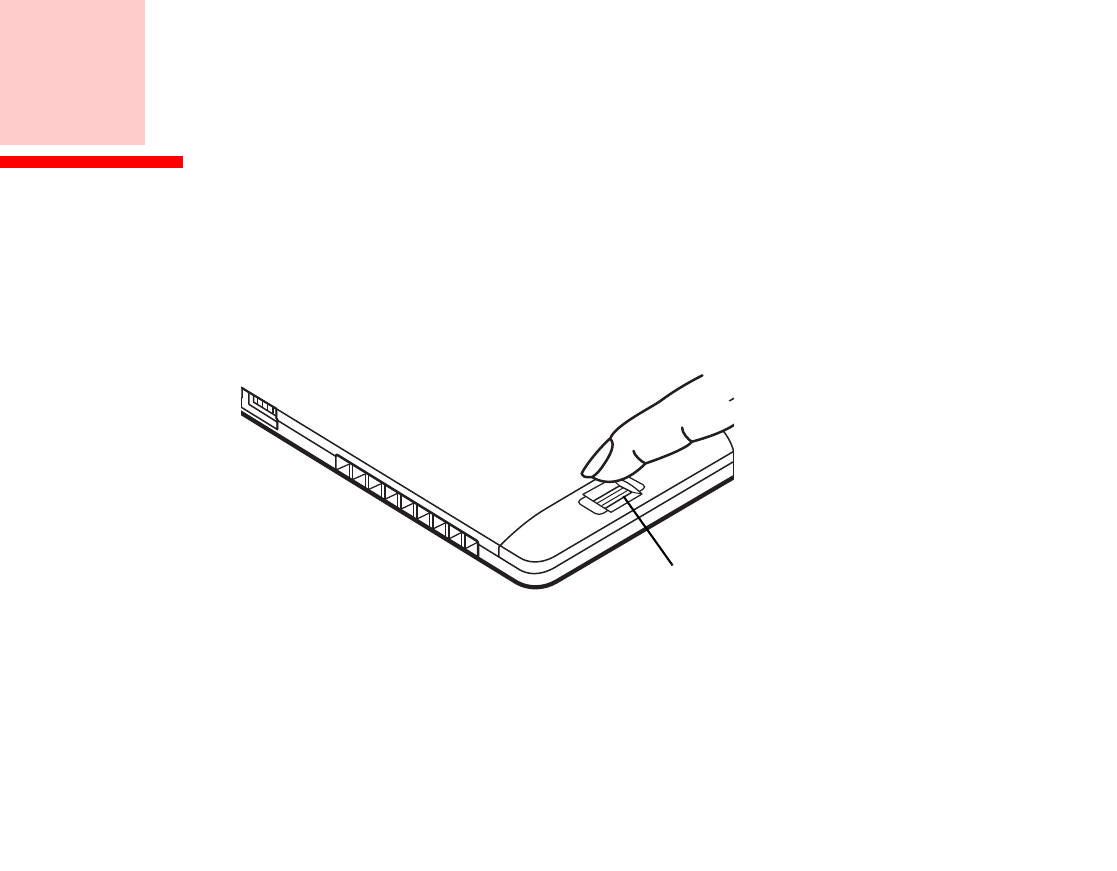
99
Appendix B: Fingerprint Sensor Device
Introducing the Fingerprint Sensor Device
Your system has a fingerprint sensor device at the bottom left below the display screen.
Figure 31. Fingerprint sensor
With a fingerprint sensor, you can avoid having to enter a username and password every time you want to:
•Log onto Windows
•Cancel a password-protected screen saver
•Log into homepages that require a username and password
After you have “enrolled” - or registered - your fingerprint, you can simply swipe your fingertip over the sensor for the
system recognize you.
Fingerprint Sensor Device

100
- Introducing the Fingerprint Sensor Device
The fingerprint sensor uses Softex OmniPass which provides password management capabilities to Microsoft
Windows operating systems. OmniPass enables you to use a "master password" for all Windows, applications, and on-
line passwords.
OmniPass requires users to authenticate themselves using the fingerprint sensor before granting access to the
Windows desktop. This device results in a secure authentication system for restricting access to your computer,
applications, web sites, and other password-protected resources.
OmniPass presents a convenient graphical user interface, through which you can securely manage passwords, users,
and multiple identities for each user.
Getting Started
This section guides you through the preparation of your system for the OmniPass fingerprint recognition application.
You will be led through the OmniPass installation process. You will also be led through the procedure of enrolling your
first user into OmniPass.
Installing OmniPass
If OmniPass has already been installed on your system, skip this section and go directly to “User Enrollment” on
page 102. You can determine whether OmniPass has already been installed by checking to see if the following are
present:
•The gold key-shaped OmniPass icon in the system tray at the bottom right of the screen.
•The Softex program group in the Programs group of the Start menu
System Requirements
The OmniPass application requires space on your hard drive; it also requires specific Operating Systems (OS’s). The
minimum requirements are as follows:
CERTAIN MODELS SUPPORT PRE-BOOT AUTHENTICATION OR PBA. PBA ALLOWS THE USER TO LOG IN PRIOR TO WINDOWS' OWN AUTHENTICATION
MECHANISM. A PBA ENVIRONMENT SERVES AS AN EXTENSION OF THE BIOS OR BOOT FIRMWARE AND ALLOWS FOR A MORE SECURE ENVIRONMENT
EXTERNAL TO THE OPERATING SYSTEM.

101
- Introducing the Fingerprint Sensor Device
•Windows XP Professional operating system or later
•At least 35 MB available hard disk space
Installing the OmniPass Application
If OmniPass is already installed on your system, go to “User Enrollment” on page 102
.
Otherwise continue with this
section on software installation.
To install OmniPass on your system you must:
1Omnipass is included in the Fujitsu Bonus Apps. To install Omnipass, start the Fujitsu Bonus Apps application from
the desktop icon, select Softex Omnipass and click [Install].
2Once OmniPass has completed installation you will be prompted to restart you system. Once your system has
rebooted you will be able to use OmniPass. If you choose not to restart immediately after installation, OmniPass
will not be available for use until the next reboot.
3The installation program automatically places an icon (Softex OmniPass) in the Windows Control Panel as well as
a golden key shaped icon in the taskbar.
Verifying Information about OmniPass
After you have completed installing OmniPass and restarted your system, you may wish to check the version of
OmniPass on your system.
To check the version information of OmniPass:
1From the Windows Desktop, double-click the key-shaped OmniPass icon in the taskbar (usually located in the
lower right corner of the screen),
or,
•INSTALLATION OF THE APPLICATION REQUIRES THAT YOU HAVE AN EXTERNAL OPTICAL DRIVE ATTACHED TO YOUR SYSTEM.
•FOR INSTALLATION, OMNIPASS REQUIRES THAT THE USER INSTALLING OMNIPASS HAVE ADMINISTRATIVE PRIVILEGES TO THE SYSTEM. IF YOUR
CURRENT USER DOES NOT HAVE ADMINISTRATIVE PRIVILEGES, LOG OUT AND THEN LOG IN WITH AN ADMINISTRATOR USER BEFORE PROCEEDING
WITH OMNIPASS INSTALLATION.

102
- Introducing the Fingerprint Sensor Device
Click the Start button and click Control Panel. Double-click Softex OmniPass in the Control Panel, and the
OmniPass Control Center will appear. If it does not appear, then the program is not properly installed,
or,
Click the Start button, select Programs, and from the submenu select the Softex program group, from that
submenu click OmniPass Control Center.
2Version information is listed on the left side of OmniPass Control center window.
Uninstalling OmniPass
To remove the OmniPass application from your system:
1Click Start on the Windows taskbar. Select Control Panel.
2Double-click Add/Remove Programs (In Windows 7: Programs and Features).
3Select OmniPass, and then click Change/Remove.
4Follow the directions to uninstall the OmniPass application.
5Once OmniPass has finished uninstalling, reboot your system when prompted.
User Enrollment
Before you can use any OmniPass features you must first enroll a user into OmniPass.
Master Password Concept
Computer resources are often protected with passwords. Whether you are logging into your computer, accessing
email, e-banking, paying bills online, or accessing network resources, you often have to supply credentials to gain
access. This can result in dozens of sets of credentials that you have to remember.
FOR UNINSTALLATION, OMNIPASS REQUIRES THAT THE USER UNINSTALLING OMNIPASS HAVE ADMINISTRATIVE PRIVILEGES TO THE SYSTEM. IF YOUR
CURRENT USER DOES NOT HAVE ADMINISTRATIVE PRIVILEGES, LOG OUT AND THEN LOG IN WITH AN ADMINISTRATOR USER BEFORE PROCEEDING WITH
OMNIPASS UNINSTALLATION.

103
- Introducing the Fingerprint Sensor Device
During user enrollment a "master password” is created for the enrolled user. This master password “replaces” all other
passwords for sites you register with OmniPass.
Example: A user, John, installs OmniPass on his system (his home computer) and enrolls an OmniPass user with
username “John_01” and password “freq14”. He then goes to his webmail site to log onto his account. He inputs his
webmail credentials as usual (username “John_02” and password “lifebook”), but instead of clicking [Submit], he
directs OmniPass to Remember Password. Now whenever he returns to that site, OmniPass will prompt him to supply
access credentials.
John enters his OmniPass user credentials (“John_01” and “freq14”) in the OmniPass authentication prompt, and he
is allowed into his webmail account. He can do this with as many web sites or password protected resources he likes,
and he will gain access to all those sites with his OmniPass user credentials (“John_01” and “freq14”). This is assuming
he is accessing those sites with the system onto which he enrolled his OmniPass user. OmniPass does not actually
change the credentials of the password protected resource. If John goes to another computer without he OmniPass
account to access his webmail, he would need to enter his original webmail credentials (“John_02” and “lifebook”) to
gain access. If he attempts his OmniPass user credentials on a system other than a system he’s enrolled on, he will
not gain access.
Basic Enrollment
The Enrollment Wizard will guide you through the process of enrolling a user. Unless you specified otherwise, after
OmniPass installation the Enrollment Wizard will launch on Windows login. If you do not see the Enrollment Wizard,
you can bring it up by clicking Start on the Windows taskbar; select Programs; select Softex; click Enroll a new user.
1Click Enroll to proceed to username and password verification. By default, the OmniPass Enrollment Wizard enters
the credentials of the currently logged in Windows user.
THE ENROLLMENT PROCEDURE ASSUMES YOU HAVE NO HARDWARE AUTHENTICATION DEVICES OR ALTERNATE STORAGE LOCATIONS THAT YOU WISH
TO INTEGRATE WITH OMNIPASS. IF YOU DESIRE SUCH FUNCTIONALITY, CONSULT THE APPROPRIATE SECTIONS OF THIS DOCUMENT.

104
- Introducing the Fingerprint Sensor Device
2Enter the password you use to log in to Windows. This becomes the “master password” for this OmniPass user. In
most cases, the Domain: value will be your Windows computer name. In a corporate environment, or when
accessing corporate resources, Domain: may not be your Windows computer name. Click [Next] to continue.
3In this step OmniPass captures your fingerprint. See “Enrolling a Fingerprint” on page 104 for more information.
4You will then see a Congratulations screen indicating your completion of user enrollment.
5Click [OK] to exit the OmniPass Enrollment Wizard. You will be asked if you’d like to log in to OmniPass with your
newly enrolled user; click [Yes].
Enrolling a Fingerprint
Enrolling a fingerprint increases the security of your system and streamlines the authentication procedure.
You enroll fingerprints in the OmniPass Control Center. With an OmniPass user logged in, click the Start button >
Select Programs > Select Softex > Select Enroll a new user.
1During initial user enrollment, you will be prompted to select the finger you wish to enroll. Fingers that have
already been enrolled will be marked by a green check. The finger you select to enroll at this time will be marked
by a red arrow. OmniPass will allow you re-enroll a finger. If you choose a finger that has already been enrolled
and continue enrollment, OmniPass will enroll the fingerprint, overwriting the old fingerprint. Select a finger to
enroll and click [Next].
2It is now time for OmniPass to capture your selected fingerprint. It may take a several capture attempts before
OmniPass acquires your fingerprint. Should OmniPass fail to acquire your fingerprint, or if the capture screen
times out, click [Back] to restart the fingerprint enrollment process.
Your system has a “swipe” fingerprint sensor. A swipe sensor is small and resembles a skinny elongated rectangle.
To capture a fingerprint, gently swipe or pull your fingertip over the sensor (starting at the second knuckle)
towards yourself. Swiping too fast or too slow will result in a failed capture. The Choose Finger screen has a
[Practice] button; click it to practice capturing your fingerprint. When you are comfortable with how your
fingerprint is captured, proceed to enroll a finger.

105
- Introducing the Fingerprint Sensor Device
3Once OmniPass has successfully acquired the fingerprint, the Verify Fingerprint screen will automatically appear.
To verify your enrolled fingerprint, place your fingertip on the sensor and hold it there as if you were having a
fingerprint captured. Successful fingerprint verification will show a green fingerprint in the capture window and
the text Verification Successful under the capture window.
4After you finish enrolling and verifying your fingerprints, you have the option to Enable PBA with
enrolled finger. If you enable this option, then you must choose two fingers to save in PBA. If you have
enrolled successfully, the Finger Enrollment Status in PBA screen will state Finger saved in PBA
successfully.
Using OmniPass
You are ready to begin using OmniPass. Used regularly, OmniPass will streamline your authentications.
Password Replacement
You will often use the password replacement function. When you go to a restricted access website (e.g., your bank,
your web-based email, online auction or payment sites), you are always prompted to enter your login credentials.
OmniPass can detect these prompts and you can teach OmniPass your login credentials. The next time you go to that
website, you can authenticate with your fingerprint to gain access.
OmniPass Authentication Toolbar
After installing OmniPass and restarting, you will notice a dialog you have not seen before at Windows Logon. This is
the OmniPass Authentication Toolbar, and it is displayed whenever the OmniPass authentication system is invoked.
The OmniPass authentication system may be invoked frequently: during Windows Logon, during OmniPass Logon,
when unlocking your workstation, when resuming from hibernate, when unlocking a password-enabled screensaver,
during password replacement for remembered site or application logins, and more. When you see this toolbar,
OmniPass is prompting you to authenticate.
IF YOU ENABLE PBA ON YOUR SYSTEM, YOU MUST SET THE SUPERVISOR PASSWORD AND PASSWORD ON BOOT SETTINGS. SEE “HARD DISK DRIVE
PASSWORDS” ON PAGE 61 FOR ADDITIONAL INFORMATION.

106
- Introducing the Fingerprint Sensor Device
The Logon Authentication window indicates what OmniPass-restricted function you are attempting. The icons in the
lower left (fingerprint and key) show what authentication methods are available to you. Selected authentication
methods are highlighted while unselected methods are not. When you click the icon for an unselected authentication
method, the authentication prompt associated with that method is displayed.
When prompted to authenticate, you must supply the appropriate credentials: an enrolled finger for the fingerprint
capture window or your master password for the master password prompt (the key icon).
Remembering a Password
OmniPass can remember any application, GUI, or password protected resource that has a password prompt.
Using the following procedure, you can store a set of credentials into OmniPass. These credentials will then be linked
to your “master password” or fingerprint.
Go to a site that requires a login (username and password), but
do not log in yet.
At the site login prompt, enter your
username and password in the prompted fields, but
do not enter the site
(do not hit [Enter], [Submit], [OK], or
Login). Right-click the OmniPass system tray icon and select Remember Password from the submenu. The Windows
arrow cursor will change to a golden key OmniPass cursor. Click the OmniPass cursor in the login prompt area, but
don’t click [Login] or [Submit].
Associating a Friendly Name
After clicking the OmniPass key cursor near the login prompt, OmniPass will prompt you to enter a “friendly name”
for this site. You should enter something that reminds you of the website, the company, or the service you are logging
into. In its secure database, OmniPass associates this friendly name with this website.
Additional Settings for Remembering a Site
When OmniPass prompts you to enter a “friendly name” you have the opportunity to set how OmniPass authenticates
you to this site. There are three settings for how OmniPass handles a remembered site.
The default setting is Automatically click the “OK” or “Submit” button for this password protected site once the
user is authenticated. With this setting, each time you navigate to this site OmniPass will prompt you for your master
password or fingerprint authentication device. Once you have authenticated with OmniPass, you will automatically
be logged into the site.

107
- Introducing the Fingerprint Sensor Device
Less secure is the option to Automatically enter this password protected site when it is activated. Do not prompt
for authentication. Check the upper box to get this setting, and each time you navigate to this site OmniPass will log
you into the site without prompting you to authenticate.
If you uncheck both boxes in Settings for this Password Site, OmniPass will prompt you for your master password or
fingerprint authentication device. Once you have authenticated with OmniPass your credentials will be filled in to the
site login prompt, but you will have to click the website [OK], [Submit], or [Login] button to gain access to the site.
Click Finish to complete the remember password procedure. The site location, the credentials to access the site, and
the OmniPass authentication settings for the site are now stored in the OmniPass secure database. The OmniPass
authentication settings (Settings for this Password Site) can always be changed in Vault Management.
Logging in to a Remembered Site
Whether or not OmniPass prompts you to authenticate when you return to a remembered site is determined by
Settings for this Password Site and can be changed in Vault Management.
The following cases are applicable to using OmniPass to login to: Windows, remembered web sites, and all other
password protected resources.
With Master Password
Once you return to a site you have remembered with OmniPass, you may be presented with a master password
prompt. Enter your master password and you will be allowed into the site.
Logging into Windows with a Fingerprint Device
When logging into Windows with a fingerprint device, the fingerprint capture window will now appear next to the
Windows Login screen. Place your enrolled fingertip on the sensor to authenticate. You will be simultaneously logged
into Windows and OmniPass. The capture window will also appear if you have used Ctrl-Alt-Del to lock a system, and
the fingerprint device can be used to log back in as stated above.
THIS SETTING IS MORE CONVENIENT IN THAT WHENEVER YOU GO TO A SITE REMEMBERED WITH THIS SETTING, YOU WILL BYPASS ANY
AUTHENTICATION PROCEDURE AND GAIN INSTANT ACCESS TO THE SITE. BUT SHOULD YOU LEAVE YOUR SYSTEM UNATTENDED WITH YOUR OMNIPASS
USER LOGGED IN, ANYONE USING YOUR SYSTEM CAN BROWSE TO YOUR PASSWORD PROTECTED SITES AND GAIN AUTOMATIC ACCESS.

108
- Introducing the Fingerprint Sensor Device
Password Management
OmniPass provides an interface that lets you manage your passwords. To access this GUI, double-click the OmniPass
key in the system tray. Click Vault Management; you will be prompted to authenticate. Once you gain access to Vault
Management, click Manage Passwords under Vault Settings. You will see the Manage Passwords interface, with a
list of friendly names.
You can view credentials stored for any remembered website by highlighting the desired resource under Password
Protected Dialog and clicking Unmask Values. Should a password be reset, or an account expire, you can remove
stored credentials from OmniPass. Highlight the desired resource under Password Protected Dialog and click Delete
Page. You will be prompted to confirm the password deletion.
The two check boxes in Manage Passwords govern whether OmniPass prompts you to authenticate or directly logs
you into the remembered site.
OmniPass will overwrite an old set of credentials for a website if you attempt to use Remember Password on an
already remembered site.
The exception to the above rule is when resetting the Windows password. If your password is reset in Windows, the
next time you login to Windows, OmniPass will detect the password change and prompt you to “Update” or
“Reconfirm” the password with OmniPass. Enter your new Windows password in the prompt and click OK. Your
OmniPass "master password" will still be your Windows password.
OmniPass User Identities
Identities allow OmniPass users to have multiple accounts to the same site (e.g.,
bob@biblomail.com
and
boballen@biblomail.com
). If OmniPass did not provide you identities, you would be limited to remembering one
account per site.
IF A MACHINE IS LOCKED AND OMNIPASS DETECTS A DIFFERENT USER LOGGING BACK IN WITH A FINGERPRINT, THE FIRST USER WILL BE LOGGED OUT
AND THE SECOND USER LOGGED IN.

109
- Introducing the Fingerprint Sensor Device
To create and manage identities, double-click the OmniPass key in the system tray. Click Vault Management;
OmniPass will prompt you to authenticate. Once you gain access to Vault Management, click Manage Identities
under Vault Settings. You can only manage the identities of the currently logged in OmniPass user
To add a new identity, click New Identity or double-click Click here to add a new identity. Name the new identity
and click [OK], then click [Apply]. You can now switch to the new identity and start remembering passwords.
To delete an identity, highlight the identity you want to delete and click [Delete Identity], then [Apply].
To set the default identity, highlight the identity you want as default and click [Set as Default]; click [Apply] to ensure
the settings are saved. If you log in to OmniPass with a fingerprint device, you will automatically be logged in to the
default identity for that OmniPass user. You can choose the identity with which you are logging in if you login using
"master password".
Choosing User Identity during Login
To choose your identity during login, type your username in the User Name: field. Press [Tab] and see that the
Domain: field self-populates. Click the Password: field to bring the cursor to it, and you will see the pull-down menu
in the Identity: field. Select the identity to login as, then click OK.
Switch User Identity
To switch identities at any time, right-click the OmniPass system tray icon and click Switch User Identity from the
submenu. The Switch Identity dialog will appear. Select the desired identity and then click OK.
Identities and Password Management
On the Manage Passwords interface of the Vault Management tab of the OmniPass Control Center, there is a pull-
down selection box labeled, Identity. This field lets you choose which identity you are managing passwords for. When
you select an identity here, only those password protected dialogs that are associated with that identity are shown.
You can perform all the functions explained in “Password Management” on page 108.
WHEN YOU DELETE AN IDENTITY, ALL OF ITS ASSOCIATED REMEMBERED SITES AND PASSWORD PROTECTED DIALOGS ARE LOST.

110
- Introducing the Fingerprint Sensor Device
Configuring OmniPass
This section gives an overview of both the Export/Import function and the OmniPass Control Center.
Exporting and Importing Users
Using OmniPass Control Center, you can export and import users in and out of OmniPass. The export process backs
up all remembered sites, credentials, and enrolled fingerprints for an OmniPass user. All OmniPass data for a user is
backed up to a single encrypted database file. During the import process, the Windows login of the exported user is
required. If the proper credentials cannot be supplied, the user profile will not be imported.
Exporting an OmniPass User Profile
To export a user, open OmniPass Control Center, and click Run User Management Wizard.
Click Backup a user's OmniPass profile. OmniPass will prompt you to authenticate. Upon successfully authentication,
you must name the OmniPass user profile and decide where to save it. An .opi file is generated, and you should store
a copy of it in a safe place.
This .opi file contains all your user specific OmniPass data, and it is both encrypted and password protected. This user
profile does NOT contain any of your encrypted data files.
YOU CANNOT IMPORT A USER INTO OMNIPASS IF THERE ALREADY IS A USER WITH THE SAME NAME ENROLLED IN OMNIPASS.
•YOU SHOULD PERIODICALLY EXPORT YOUR USER PROFILE AND STORE IT IN A SAFE PLACE. IF ANYTHING HAPPENS TO YOUR SYSTEM, YOU CAN IMPORT
YOUR OMNIPASS PROFILE TO A NEW SYSTEM AND HAVE ALL YOUR REMEMBERED SETTINGS AND FINGERPRINTS INSTANTLY.
•YOU DON'T FORGET THE WINDOWS LOGIN CREDENTIALS WHEN EXPORTING. WHEN YOU EXAMINE THE IMPORTATION, YOU ARE PROMPTED FOR
AUTHENTICATION. THE CREDENTIALS THAT WILL ALLOW A USER PROFILE TO BE IMPORTED ARE THE WINDOWS LOGIN CREDENTIALS OF THE
EXPORTED USER. THEY ARE THE CREDENTIALS THAT HAD TO BE SUBMITTED WHEN THE USER PROFILE WAS EXPORTED. YOU WILL NEED USER NAME,
PASSWORD, AND DOMAIN.

111
- Introducing the Fingerprint Sensor Device
Importing an OmniPass User Profile
To import an OmniPass user open the OmniPass Control Center, and click Run User Management Wizard. Click
Restore a user's OmniPass profile. OmniPass will then prompt you to browse for the file you had previously exported
(.opi file). When you select the .opi file for importation, OmniPass will prompt you for authentication. The credentials
that will allow a user profile to be imported are the Windows login credentials of the exported user. They are the
credentials that had to be submitted when the user profile was exported. You will need User Name, Password, and
Domain. If you don’t remember the value for Domain, in a PC or SOHO environment Domain should be your computer
name.
OmniPass will notify you if the user was successfully imported.
Things to Know Regarding Import/Export
•Assume you export a local Windows User profile from OmniPass. You want to import that profile to another
machine that has OmniPass. Before you can import the profile, a Windows user with the same login credentials
must be created on the machine importing the profile.
Example: I have a Windows user with the username “Tom” and the password “Sunshine” on my system. I have
enrolled Tom into OmniPass and remembered passwords. I want to take all my passwords to new system. I
export Tom’s OmniPass user profile. I go to my new system and using the Control Panel I create a user with the
username "Tom" and the password "Sunshine". I can now successfully import the OmniPass user data to the new
system.
•If you export an OmniPass-only user, you can import that user to any computer running OmniPass, provided
that a user with that name is not already enrolled in OmniPass.
•If you attempt to import a user profile who has the same name as a user already enrolled in OmniPass, the
OmniPass import function will fail.
OmniPass Control Center
The Omnipass Control Center allows you to perform a variety of Omnipass "housekeeping" tasks. For details about the
features offered by the Control Center:
1Go to Start > All Programs > Softex > Omnipass Control Center.
2When the Omnipass Control Center opens, click the Help link on the left side of the Control Center window.

112
- Introducing the Fingerprint Sensor Device
Troubleshooting
You cannot use OmniPass to create Windows users. You must first create the Windows user, and you will need
administrative privileges to do that. Once the Windows user is created, you can add that user to OmniPass using the
same username and password
Cannot add Windows users to OmniPass
If you experience difficulties adding a Windows user to OmniPass, you may need to adjust your local security
settings. You can do this by going to Start, Control Panel, Administrative Tools, and Local Security Settings.
Expand Local Policies, expand Security Options, and double-click Network Access: Sharing and Security Model
for Local Accounts. The correct setting should be
Classic - Local Users Authenticate as Themselves
.
Cannot add a User with a Blank Password to OmniPass
If you experience difficulties adding a user with a blank password to OmniPass, you may need to adjust your local
security settings. First attempt the procedure explained in the
Cannot add Windows user to OmniPass
section. If
the difficulties persist, then try the following procedure.
Click Start, Control Panel, Administrative Tools, and Local Security Settings. Expand Local Policies, expand
Security Options, and double-click Accounts: Limit local account use of blank passwords to console login only.
This setting should be set to Disabled.
Dialog appears after OmniPass authentication during Windows Logon
After installing OmniPass on your system, you can choose to logon to Windows using OmniPass. You authenticate
with OmniPass (via master password, or an enrolled security device) and OmniPass logs you into Windows. You
may, during this OmniPass authentication, see a Login Error dialog box.
This dialog box occurs when OmniPass was unable to log you into Windows with the credentials supplied
(username and password). This could happen for any of the following reasons:
•Your Windows password has changed
•Your Windows account has been disabled

113
- Introducing the Fingerprint Sensor Device
If you are having difficulties due to the first reason, you will need to update OmniPass with your changed Windows
account password. Click Update Password and you will be prompted with a dialog to reconfirm your password.
Enter the new password to your Windows user account and click OK. If the error persists, then it is unlikely the
problem is due to your Windows user account password changing.

114
Index
A
About This Guide 10
AC
adapter 35
plug adapters 73
Active Digitizer 24
application buttons
Rotate button 33
Auto/Airline Adapter 35, 36
B
Battery
care 73
conserving power 41
dead 57
faulty 57
increasing life 73
level indicator 51
problems 57, 58
battery release latch 16
BIOS
Guide 39
setup utility 38
Bluetooth 97
Boot Sequence 38
Built-in Speakers 55
C
Cameras 14, 16
Capacitive Touchscreen 28
CapsLock 51
Clicking 24
Contact Information 11
conventions used in the guide 10
D
DC input connector 17
DC Output Cable 35
E
Error Messages 60
F
Fingerprint Sensor Device 99
enrolling a fingerprint 104
getting started 100
installing OmniPass 100
logging into a remembered site 107
OmniPass authentication toolbar 105
password replacement 105
remembering a password 106
uninstalling OmniPass 102
user enrollment 102
using OmniPass 105
Front Web Camera 14

115
G
Gestures 28
H
Hard Disk Drive
problems 55
Hibernation Feature 42
disable/enable 42
K
keyboard docking station 46
P
Pen
Caring for the Pen 30
Changing the Pen Battery 31
Changing the Pen Settings 30
Installing a Pen Tether 32
Replacing the Pen Tip 32
Port Replicator 47
attaching 48, 49
back panel components 47
detaching 49
Power
AC adapter 35
Auto/Airline adapter 35
failure 56, 57
management 41
off 43
on 37
problems 58
sources 35
power icon 21
Power Management 41
Power On Self Test 37, 60
Power/Suspend/Resume Switch 17, 41
Pre-Installed Software 80
Adobe Reader 81
manuals 81
R
Rear Web Camera 16
Registration 40
Regulatory Information 84
Restarting 43
Restoring Your Pre-installed Software 61
S
ScrLk 51
SD Card 17
installing 45
removing 45
Sleep Mode 41
Smart Card Slot 18
Specifications 76
Audio 77
Chipset 76
Digitizer 77
Dimensions and Weight 79
Environmental Requirements 80
Keyboard 78
mass storage device options 78
Memory 76
Microprocessor 76
Power 79
Video 77
status display 20
power icon, system states indicated by 21

116
T
Touch Screen
calibrating 27
clicking 25
dragging 26
Troubleshooting 52
Audio Problems 55
battery 57
display 59
hard drive 55
mouse 55
power 56
USB 56
U
Universal Serial Bus 17, 18
Using the Optional Capacitive Touchscreen 28
W
Warranty 12
Windows Power Management 42
Wireless LAN
Before Using the Wireless LAN 88
configuring 88
connection to the network 93
deactivating/disconnecting 91
modes 89
Specifications 96
Troubleshooting 94